Critical review: Tyler Ferrell's "Stock Tour Swing"
Click here to go back to the home page.
Introduction:
Tyler Ferrell is a golf instructor, who runs the golfsmartacademy.com website (which offers a monthly subscription service to hundreds of his short videos that cover a variety of topics). New subscribers can get a 7-day free trial before finally deciding whether they want to subscribe to his monthly subscription service. Tyler Ferrell has also published a golf instructional book called "The Stock Tour Swing" and it is available at https://www.amazon.com/Stock-Tour-Swing-Science-Uncover/dp/0999243705 .
In this review paper, I will critically analyse some of Tyler Ferrell's opinions - as expressed in his book and in his videos that are available at his Golf Smart Academy website. I will mainly focus my attention on 5 topics where I significantly disagree with Tyler Ferrell's opinions on golf swing mechanics/biomechanics, and readers of this review paper can independently evaluate our opinions in order to determine whose opinion(s) has the greatest legitimacy - both in terms of sound biomechanical logic and also with respect to the issue as to whether any of the described biomechanical actions actually occur in the golf swings of most professional golfers.
For readers, who only want to read certain topics,
you can click on the relevant links in this introductory section in order to
go directly to that topic.
Topic number 2: The release phase and hand release actions through impact.
Topic number 3: Clubshaft shallowing during the early-mid downswing.
Topic number 1: The topic of clubface-closing during the downswing and an analysis of the "motorcycle move".
Tyler Ferrell is a strong advocate of the "motorcycle move" and he has produced a large number of videos for his Golf Smart Academy website on the topic of the "motorcycle move".
Here is a capture image from one of Tyler Ferrell's videos where he demonstrates the "motorcycle move"
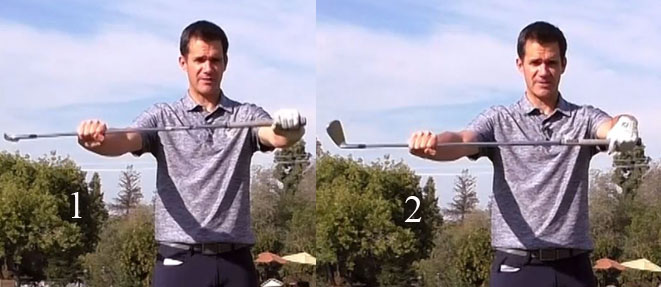
Image 1 shows Tyler Ferrell holding a golf club handle with his left hand as if he were grasping the handle grip of a motorcycle with his left hand. Note that the clubshaft is horizontal to the ground and that the clubshaft is at a roughly 90 degree angle relative to his left forearm, which means that his left wrist is radially deviated (upcocked).
In image 2, he is actively palmar flexing his left wrist while using his right arm/hand to keep the clubshaft stationary so that it does not angulate. Note that the clubface rotates counterclockwise in a clubface closing direction. It would be more accurate to label this maneuver the "reverse motorcyle move" because a motorcyclist usually rotates the motorcyle's handle grip clockwise when twisting the motorcyle's handle grip. However, I will use Tyler Ferrell's "motorcycle move" term in this review paper to describe the true factual reality that palmar flexion of the lead wrist will cause the clubshaft to rotate counterclockwise about its longitudinal axis if the lead wrist is radially deviated, and that it will close the clubface relative to the clubhead arc, and also relative to the watchface area of the back of the left lower forearm, by ~30 degrees if the golfer adopts a weak-neutral lead hand grip.
I have written about the topic of "What effect does lead wrist bowing have on the clubface and clubshaft?" in the following review paper at https://perfectgolfswingreview.net/LeadWristBowing.html and if you look at the capture images of my visual demonstration in that review paper, you will note that I have confirmed the fact that lead wrist bowing twists the club handle about its longitudinal axis so that the clubface will close by ~30 degrees, but only if the lead wrist is radially deviated.
Tyler Ferrell has stated that if a golfer closes the clubface by ~30 degrees relative to the clubhead arc by performing the "motorcycle move" in the early downswing (or even earlier in the late backswing) when the lead wrist is radially deviated that it will allow a golfer to get to the P5.5/P6 position with a clubface that is already closed relative to the clubhead arc by that amount.
Here are capture images from Tyler Ferrell's "Stock Tour Swing" book where he demonstrates the "motorcycle move".
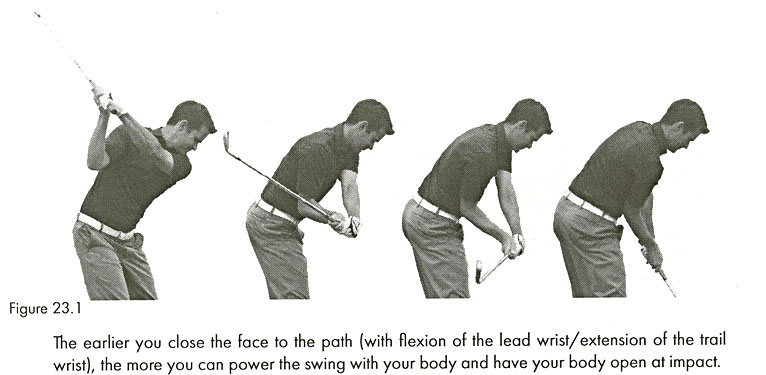
The first image on the left side shows Tyler Ferrell at his end-backswing position. Note that his lead wrist is slightly cupped, and that his clubface is open to the clubhead arc, but neutral relative to the watchface area on the back of his lead lower forearm (which is expected if a golfer adopts a weak-neutral lead hand grip strength). Note that his lead wrist is radially deviated and that the clubshaft is at a ~90 degree angle relative to his lead forearm.
The second image shows Tyler Ferrell at his P5.5 position. Note that his lead wrist is overtly bowed (palmar flexed) and that it closes the clubface relative to his clubhead arc by ~ 20-30 degrees because the lead wrist bowing maneuver that he is performing between P4 => P5.5 is happening when his lead wrist is radially deviated. Note that the clubface is closed relative to his clubhead arc, and also closed relative to the watchface area on the back of his lead lower forearm, by ~20-30 degrees at his P5.5 position (and also at his P6 position in the third image).
What is the implication of that true factual reality? Tyler Ferrell has implied that early clubface closing of ~30 degrees secondary to the use of a "motorcycle move" maneuver (that is performed during the early-mid downswing) means that a golfer can simply rotate his torso counterclockwise into impact without having to use any further clubface closing in the later downswing secondary to the use of lead forearm supination (which is called a PA#3 release action in TGM terminology). To support his opinion, Tyler Ferrell presented the following comparative handle twist velocity graphs in one of his Golf Smart Academy videos.
Composite image created from two copied graphs.
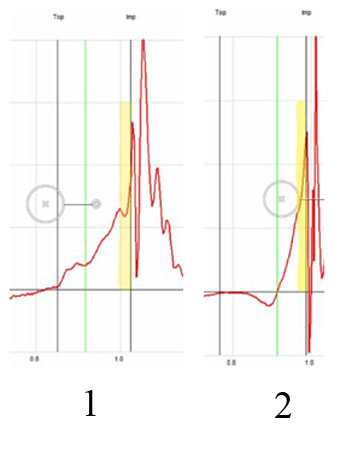
The red graph is a measure of the handle twist velocity of the golf club handle during the downswing. The vertical black line labelled "top" represents the end-backswing position and the vertical black line labelled "imp" represents the impact position, and the downswing happens between the two vertical black lines.
Image 1 shows the handle twist velocity graph of a pro golfer who apparently uses the "motorcycle move" in the early downswing. Note that the graph shows a low level of handle twist velocity happening in the early downswing between the vertical "top" black line and the green vertical line, and that is presumably due to the "motorcycle move" maneuver.
Image 2 shows the handle twist velocity graph of a skilled amateur golfer who does not use the "motorcycle move" maneuver. Note that his handle twist velocity graph does not rise above the zero horizontal black line in his early downswing. Note that his handle twist velocity starts to increase in the mid-downswing and that it then continues to increase in a smooth, non-interrupted manner all the way to impact, reaching its maximum axial twist velocity at impact.
Now, look again at image 1's handle twist velocity graph. Note that the handle twist velocity is not fast in the mid-downswing, but it does increase very rapidly in velocity just before impact (see the yellow-colored zone). In fact, if you look at the handle twist velocity graph near/at impact in image 1 it is just as fast as the handle twist velocity graph seen near/at impact in image 2 (see the yellow-colored zone). Why is the handle twist velocity so fast just before impact in image 1 - thereby contradicting Tyler Ferrell's claim that using a "motorcycle move" maneuver in the early downswing means that a golfer will not have to twist the club handle very fast in the later downswing near impact? The answer is related to the fact that the golfer is maintaining a bowed lead wrist throughout the entire downswing into the early followthrough, and it is causally due to the fact that maintaining a bowed lead wrist into the later downswing, when the lead wrist becomes increasingly ulnar deviated, causes clubshaft angulation without clubface closing. I discussed this "clubshaft angulation effect due to lead wrist bowing happening when the lead wrist is ulnar-deviated" phenomenon in great detail in my review paper called "What effect does lead wrist bowing have on the clubface and clubshaft?"
I believe that many golf instructors do not understand that maintaining a bowed lead wrist "motorcycle move" maneuver into the later downswing will cause backwards angulation of the clubshaft relative to the bowed lead wrist/hand, so that the golfer will approach impact with a lot of forward shaft lean (where the lead hand is well ahead of the clubhead).
Here is an example - featuring Collin Morikawa.
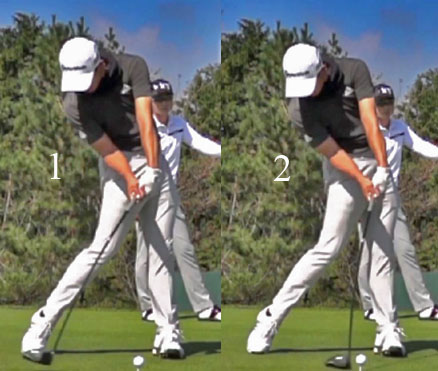
Image 1 shows Collin Morikawa at his P6.7 position and image 2 shows him at impact.
Note that Collin Morikawa has a markedly bowed lead wrist that angles his clubshaft back away from the target relative to his lead hand. Now, although Collin Morikawa closed his clubface relative to his clubhead arc by ~30 degrees by bowing his lead wrist at his P4 position when his lead wrist was radially deviated, his clubface is still open relative to the ball-target line at his P6.7 position because his clubshaft is angled so much backwards relative to his bowed lead wrist/hand. Look at how much Collin Morikawa has to rotate his lead hand, and therefore his clubface, counterclockwise between P6.7 => impact - i) by looking at the degree of counterclockwise rotation of the back of his lead hand, or ii) by looking at the degree of counterclockwise rotation of his lower radial bone in his lower lead forearm, or iii) by looking at the degree of counterclockwise rotation of the watchface area on the back of his lead lower forearm. To get a square clubface by impact, Collin Morikawa has to use a finite amount of counterclockwise rotation of his lead humerus and a finite amount of lead forearm supination between P6.7 => P7, and Tyler Ferrell is not taking that fact into account. Note that Collin Morikawa's lead hand has already reached the ball position by P6.7 and that there is only about 2" of targetwards travel of his lead hand happening between P6.7 => impact. That means that the degree of counterclockwise rotation of his clubshaft (due to lead arm/forearm counterclockwise rotation) happening per unit amount of lead hand travel distance is going to be larger near impact, which will likely result in a larger clubface ROC near impact - even if the overall amount of counterclockwise rotation of his clubshaft is smaller in amount between P6 => P7 due to the fact that his clubface is already closed relative to his clubhead arc by ~30 degrees at the P6 position.
Jon Rahm is a prototypical example of a golfer who uses the bowed lead wrist "motorcycle move" technique, and here are capture images showing how he uses the "motorcycle move" during his early-mid downswing golf swing action.

Image 1 is at the P4 position, image 2 is at the P5 position, image 3 is at the P5.5 position and image 4 is at the P6 position.
Note that Jon Rahm bowed his lead wrist during his backswing action, and that it caused his clubface to be slightly closed relative to his clubhead arc, and also relative to the watchface area on the back of his lead lower forearm, at the P4 position.
Note that the degree of lead wrist bowing is less at the P5 position, but it then increases significantly in amount between the P5 => P6 positions due to Jon Rahm's use of the "combined lead wrist palmar flexion + early lead forearm supination" maneuver. Note that Jon Rahm's clubface is closed by >30 degrees relative to his clubhead arc, and also relative to the watchface area on the back of his lead lower forearm, at the P6 position.
Now, although proponents of the "motorcycle move" maneuver (like Tyler Ferrell) believe that early clubface closing due to use of the "motorcycle move" between P4 => P6 implies that the golfer can simply turn his body into impact without having to rotate the lead forearm counterclockwise during the later downswing, the true "real life" reality does not support their opinion.
Here is a copy of Jon Rahm's 3D graphs.
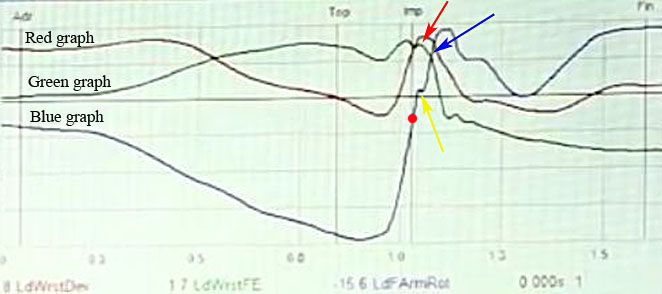
The green graph represents Jon Rahm's lead wrist flexion-extension graph. Note that Jon Rahm's lead wrist is bowed at the P4 position. Then, note that his degree of lead wrist bowing decreases slightly in the early downswing before increasing again in the later downswing and that he reaches impact with a markedly bowed lead wrist.
The blue graph represents Jon Rahm's lead forearm supination-pronation graph. Note that Jon Rahm's lead forearm is pronated at his P4 position, and that his lead forearm pronates slightly more during his early-mid downswing when he shallows his clubshaft between P4 => P6. Then, note how much, and how rapidly, Jon Rahm supinates his lead forearm in his later downswing after P6. The reason why Jon Rahm still has to use a large amount of lead forearm supination in his later downswing in order to square his clubface by impact is due to the fact that his marked amount of lead wrist bowing, which is happening between P6 => P7, angles his clubshaft backwards away from the target and thereby opens the clubface relative to his ball-target line - and like Collin Morikawa, he needs to rotate his lead hand counterclockwise by a significant amount between P6.5 => P7 in order to get his clubface square to the ball-target line by impact.
Here are capture images of Jon Rahm's late downswing action.
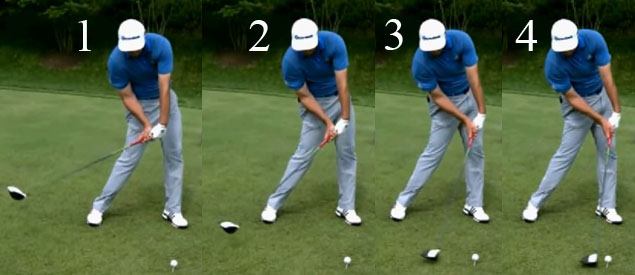
Image 1 is at the P6.2 position, image 2 is at the P6.5 position, image 3 is at the P6.8 position and image 4 is at impact.
At the P6.5 position, Jon Rahm's clubface is presumably closed relative to his clubhead arc by ~30 degrees because he performed the "motorcycle move" in his backswing and early-mid downswing when his lead wrist was radially deviated. However, his clubface is still very open relative to his ball-target line because he has such a large degree of backwards clubshaft angulation - note that his lead hand has already reached the ball position while his clubhead is still about 30" away from impact. Note that his lead hand only moves targetwards by a few inches between P6.5 => P7 and during that time period his clubface has to rotate counterclockwise by a significant amount in order for the clubface to become square to the ball-target line at impact. It is therefore not surprising that Jon Rahm's 3D lead forearm rotation graph shows a large amount of lead forearm supination rapidly happening between P6.5 => P7.
Another error that Tyler Ferrell makes with respect to his opinions regarding the "motorcycle move" is his opinion that a pro golfer must be using the "motorcycle move" if his lead wrist becomes less extended during his early/mid downswing.
Watch this Tyler Ferrell video called "Flexing Your Wrist - Golf Club Face Motorcycle Move", which is available at https://www.youtube.com/watch?v=MNpOGqOvOEE&t=56s
In that video, Tyler Ferrell states that a golfer can perform the "motorcycle move" during the i) backswing, ii) early-mid downswing or iii) late downswing.
As an example of a pro golfer who Tyler Ferrell believes is performing the "motorcycle move" during the early-mid downswing between P4 => P6, Tyler Ferrell uses Henrik Stenson as a prototypical example. However, what is the fundamental fact justifying Tyler Ferrell's opinion that Henrik Stenson is using the "motorcycle move" during the P4 => P6 time period? Tyler Ferrell simply asserts in his video that Henrik Stenson's lead wrist is more extended at the P4 position than it is at the P6 position, which only means that his lead wrist is moving in the direction of palmar flexion (lead wrist bowing) during the P4 => P6 time period. However, although Tyler Ferrell is correct to assert that Henrik Stenson's lead wrist is less extended at the P6 position than it is at the P4 position, that does not necessarily mean that Henrik Stenson is using the "motorcycle move". Tyler Ferrell would also have to demonstrate that Henrik Stenson's clubface is closing relative to his clubhead arc, and also relative to the watchface area on the back of his lead lower forearm, between P4 => P6.
Here are comparative capture images of Tyler Ferrell's and Henrik Stenson's mid downswing action.
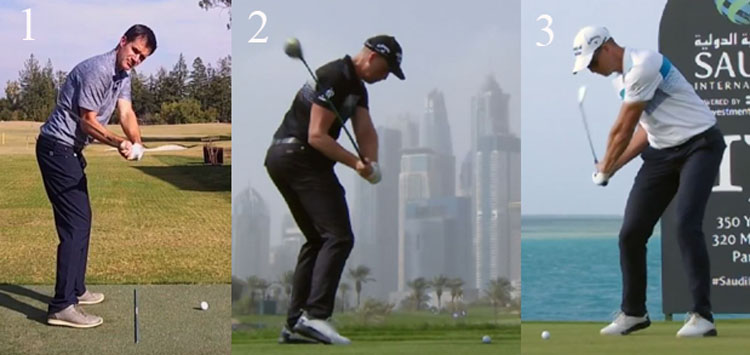
Image 1 shows Tyler Ferrell at the P5.5 position, and images 2 and 3 show Henrik Stenson at the P5.5 position (viewed from two different viewing perspectives).
Note that Tyler Ferrell is using the "motorcycle move" based on two clearly observable facts - i) his lead wrist is overtly bowed and ii) his clubface is closing by ~20 - 30 degrees relative to his clubhead arc, and also relative to the watchface area on the back of his lead lower forearm.
Note that Henrik Stenson still has a slightly cupped lead wrist at P5.5, and although it is less cupped at P5.5 than it was at P4, it is not overtly bowed. More importantly, note that his clubface is not closing relative to his clubhead arc or relative to the watchface area on the back of his lead lower forearm - so he cannot possibly be using the "motorcycle move" like Tyler Ferrell.
Here is a HackMotion 3D graph of Henrik Stenson's downswing action.
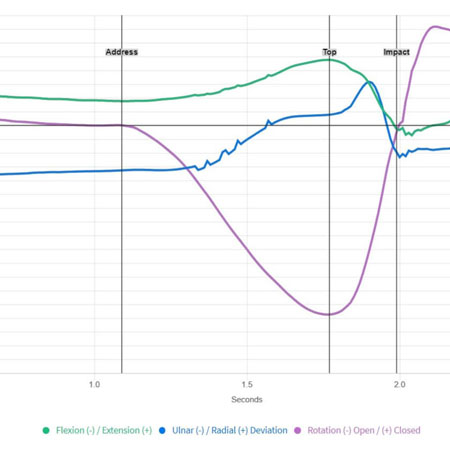
The downswing action happens between the vertical black line labelled "top" and the vertical black line labelled "impact".
The green graph is Henrik Stenson's lead wrist flexion-extension graph. Note that Henrik Stenson's lead wrist is extended at his P4 position and that it becomes progressively less extended during his downswing to eventually become borderline palmar flexed at impact.
Now, although Henrik Stenson's lead wrist is steadily moving in the direction of less lead wrist extension (which is the same as saying that it is moving steadily in the direction of lead wrist palmar flexion) throughout his entire downswing, that does not mean that Henrik Stenson is using the "motorcycle move" golf swing technique. In reality, Henrik Stenson is actually using the intact LFFW/GFLW golf swing technique, which I described in great detail in my review paper called "What effect does lead wrist bowing have on the clubface and clubshaft?".
A key point about understanding the intact LFFW/GFLW golf swing technique is understanding the natural biomechanical phenomenon where the lead wrist of a golfer, who uses a weak-neutral lead hand grip strength, will automatically/naturally becomes less extended as it moves from being radially deviated at the P4 position to becoming more ulnar deviated in the later downswing between P6.5 => P7.
Here is a capture image from my review paper showing that natural biomechanical phenomenon.
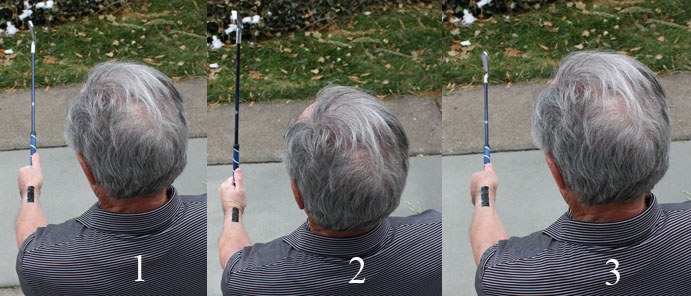
In image 1, I (the author of this review paper) am holding a short golf club in my left hand using a weak left hand grip strength. I have taped a 3" piece of black tape over my lower radial bone at the level of my lower left forearm. Note that the clubshaft is straight-in-line with that black taped area of my left lower forearm, which means that I have an intact LFFW (left forearm flying wedge). Note that the clubface is also straight-in-line with my left lower forearm, which means that it is neutral and not open/closed relative to my left lower forearm. Note that my left wrist is slightly cupped (dorsiflexed), which is biomechanically expected if I adopt a weak lead hand grip strength and a low palmar lead hand grip position. Now, although my left wrist does not look anatomically flat, it is geometrically flat (= where the clubshaft is straight-line-aligned with the black-taped area of my lower lead forearm), and that geometrical straight-line relationship between the clubshaft and my lower lead forearm defines the term GFLW (geometrically flat left wrist).
In image 2, I am radially deviating my left wrist so that the clubshaft becomes roughly perpendicular to my left forearm (simulating the P4 position's left wrist alignment in the plane of ulnar-radial deviation). Note that the degree of left wrist cupping (dorsiflexion) increases even though I still have an intact LFFW/GFLW alignment and note that the clubface still remains neutral relative to my left forearm.
In image 3, I am ulnar deviating my left wrist (simulating my impact position's left wrist alignment in terms of its degree of ulnar deviation in the plane of ulnar-radial deviation). Note that my left wrist becomes less extended and borderline palmar flexed (anatomically flat) even though I still have an intact LFFW/GFLW alignment and the clubface still remains neutral relative to my left forearm.
In other words, although my left wrist changed from being frankly extended when it is radially deviated to becoming borderline palmar flexed when it is ulnar deviated, the changing degree of left wrist extension does not disrupt my intact LFFW/GFLW alignment and it does not close the clubface relative to the black-taped area of my left lower forearm. If you want to better understand the biomechanics underlying the intact LFFW/GFLW golf swing technique (as used by Henrik Stenson, Justin Rose, Adam Scott and Tiger Woods), then I would recommend that you read the relevant section of my review paper.
I previously mentioned that Tyler Ferrell stated in his video called "Flexing Your Wrist - Golf Club Face Motorcycle Move" that it possible to perform the "motorcycle move" during either the late backswing, early-mid downswing or late downswing. Tyler Ferrell's conceptual idea of the "motorcycle move" is the idea that an active lead wrist bowing maneuver closes the clubface relative to the clubhead arc. I have already agreed that it is possible to close the clubface relative to the clubhead arc by bowing the lead wrist during the backswing, or early-mid downswing, when the lead wrist is radially deviated. However, I don't agree that it is possible to significantly close the clubface relative to the clubhead arc in the later downswing (after P6) when the lead wrist becomes significantly ulnar deviated. Under those conditions, lead wrist bowing is far more likely to angle the clubshaft backwards away from the target relative to the lead wrist/hand without closing the clubface relative to the clubhead arc. In his "Flexing Your Wrist - Golf Club Face Motorcycle Move" video, Tyler Ferrell uses Rory Sabbatini as an example of a pro golfer who he believes is using the "motorcycle move" in his late downswing.
Here are capture images of Rory Sabbatini's late downswing action.
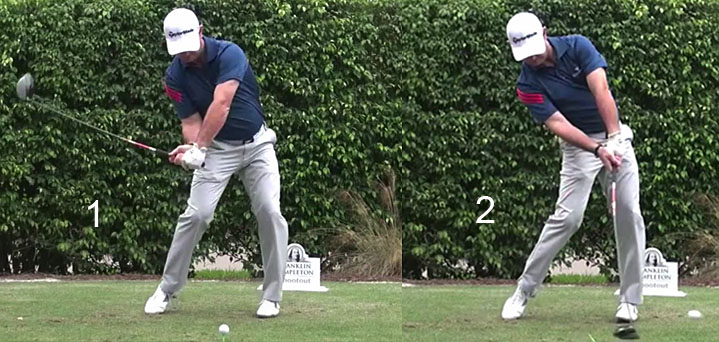
Image 1 is at the P6 position and image 2 is at impact.
At the P6 position, Rory Sabbatini does not have a bowed lead wrist and his lead wrist is slightly cupped. Note that his clubface is not closed relative to his clubhead arc at the P6 position.
Between P6 => P7, Rory Sabbatini starts to bow his lead wrist so that he reaches impact with a slightly bowed lead wrist. What effect does bowing his lead wrist between P6 => P7 have on his clubface and clubshaft? I believe that bowing his lead wrist during his later downswing between P6 => P7, when his lead wrist is becoming increasingly ulnar deviated, will allow him to reach impact with a finite amount of forward shaft lean (which is desirable), but I do not believe that it will close his clubface relative to his clubhead arc in such a way that it will decrease the amount of lead forearm supination required to get a square clubface by impact. Note how much Rory Sabbatini is rotating the watchface area of his lead lower forearm, and therefore the back of his lead hand, counterclockwise between P6 => P7. I believe that it is mainly due to a lead forearm supinatory motion, and I think that there is no reason to believe that he is using less lead forearm supination as a result of bowing his lead wrist during that same P6 => P7 time period. Tyler Ferrell has presented no evidence that bowing the lead wrist in the later downswing between P6 => P7 (in a golfer who uses a weak-neutral lead hand grip strength) will decrease the amount of lead forearm supination required in the later downswing in order to square the clubface by impact!
As a second example of a pro golfer who Tyler Ferrell believes is using the "motorcycle move" in the later downswing, Tyler Ferrell uses the example of John Senden.
Watch Tyler Ferrell's "Flexing Your Wrist - Golf Club Face Motorcycle Move" video between the 14:16 - 14:59 minute time points where he claims that John Senden is using the "motorcycle move" in his late downswing just before impact.
Here are capture images (from that video) of John Senden's late downswing action.

Image 1 is the P6 position, image 2 is at the ~P6.5 position, image 3 is at the ~P6.8 position and image 4 is at impact.
Note that John Senden's lead wrist is cupped at the P6 position and less cupped at impact, which means that his lead wrist is moving in the direction of lead wrist palmar flexion. However, the fact that John Senden's lead wrist is becoming less extended between P6 => P7 does not mean that he is using the "motorcycle move", which Tyler Ferrell believes is primarily used to close the clubface relative to the clubhead arc.
Look more carefully at those capture images and you will note that John Senden, who uses a very strong lead hand grip strength, is not rotating his lower lead forearm, and therefore the back of his lead hand, counterclockwise very much between P6 => P7 and that he reaches impact with the ulnar border of his lead hand facing the target while the back of his lead wrist/hand is facing the ball-target line. If the back of his lead wrist/hand is facing the ball-target line, and if it is parallel to the functional swingplane, in the later downswing when he starts to bow his lead wrist, then that lead wrist bowing phenomenon will primarily change the angle of his clubshaft in the VSP (vertical swingplane) which is perpendicular to the direction of his clubhead arc, and it will not produce forward shaft lean or close the clubface relative to the clubhead arc.
A pro golfer, who adopts a very strong lead hand grip strength at address, already has his clubface closed relative to the watchface area of his lead lower forearm and he therefore should have no incentive to use an additional clubface-closing maneuver (like the "motorcycle move") to close the clubface even more relative to his clubhead arc during his downswing action. Also, if he does increasingly bow his lead wrist during his later downswing between P6 => P7 it will not close the clubface relative to his clubhead arc for two reasons. First of all, if lead wrist bowing happens in the later downswing, when the lead wrist becomes increasingly ulnar deviated, it only changes the clubshaft angle (relative to the lead forearm) and it does not close the clubface relative to the clubhead arc. Secondly, if lead wrist bowing happening between P6 => P7 did actually cause the clubface to close slightly relative to the watchface area of his lead lower forearm between P6 => P7, that changing clubface angle would be happening perpendicular to the targetwards direction of the clubhead arc, and not parallel to the direction of the clubhead arc - and it would more likely affect the clubface's dynamic loft rather than have any closing effect on the clubface relative to the targetwards direction of the clubhead arc! I think that it is a major mistake to claim that a pro golfer, who uses a very strong lead hand grip strength, can effectively use the "motorcycle move" in the later downswing in order to help close the clubface relative to the clubhead arc, and thereby reduce the amount of lead forearm supination required during the late downswing's PA#3 release action (where the required amount of lead forearm supination is inversely proportional to a pro golfer's lead hand's grip strength).
In conclusion, I agree with Tyler Ferrell's opinion that if a pro golfer, who uses a weak-neutral lead hand grip strength, performs the "motorcycle" move in the late backswing or early-mid downswing (when the lead wrist is radially deviated), that it will close the clubface relative to the clubhead arc, and also relative to the watchface area on the back of the lead lower forearm, by ~ 20 - 30 degrees at the P6 position. However, that clubface closing benefit is offset by the fact that if a pro golfer maintains a significantly bowed lead wrist between P6 => P7 that it will angle the clubshaft backwards relative to the lead forearm and that clubshaft angulation phenomenon will have a clubface opening effect relative to the ball-target line, which means that the golfer will still likely have to use a lot of lead forearm supination in his later downswing, and the handle twist velocity near impact is also likely to still be very rapid. However, although I think that using a bowed lead wrist golf swing technique (rather than the intact LFFW/GFLW golf swing technique) has negligible benefit from a clubface closing perspective, I do think that the bowed lead wrist technique has other major benefits - i) it naturally results in forward shaft lean at impact; ii) the bowed lead wrist is likely to be more mechanically stable than a GFLW at impact and through impact; and iii) it is very conducive to more efficiently executing a DH-hand release action through the immediate impact zone between P7 => P7.2+. I discussed these three major benefits in my review paper on this topic.
Topic number 2: The release phase and hand release actions through impact.
Tyler Ferrell describes two phases in his recommended golf swing action - a transition phase between P4 and P5.5 (which is the swing power production phase) and a release phase between P5.5 and P8 during which time period the arms and club are released. Tyler Ferrell does not divide the release phase into a pre-impact phase and a post-impact phase, and he does not talk about a separate PA#2 release phase (club release phase) and a separate PA#3 release phase (clubface-closing phase due to left forearm supination). He simply states that the release phase starts with a bent right elbow, bent right wrist and a radially deviated left wrist at P5.5 and he states that during the release phase between P5.5 and P8 the two arms will fully straighten and that the "arm straightening/extending" phenomenon will naturally cause the club to release and the left forearm to maximally supinate.
Consider Tyler Ferrell's description of the release phase in the following you-tube video - https://www.youtube.com/watch?v=9lgMWCrhyIU
Tyler Ferrell states in the video that as the arms extend fully during the release phase that the arm extension phenomenon should fully supinate the left forearm and fully pronate the right forearm.
Capture image from that video featuring Tyler Ferrell.
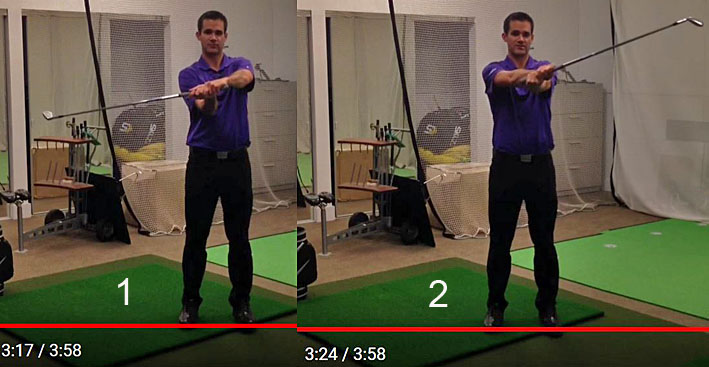
Image 1 is at the start of the release phase where the left wrist is
radially deviated and the left forearm is pronated, while the right elbow
and right wrist are both bent and the right forearm is supinated. Note that
the clubface is facing skywards.
Image 2 is at the end of the release phase where the right elbow has fully straightened and where the right forearm has fully pronated over a fully supinated left forearm. Note that the left palm is facing skywards and note that the clubshaft has bypassed his left arm (from an angular rotational perspective) secondary to the left forearm supination phenomenon. Note that the clubface has markedly rotated and it is facing the ground. Note that the right wrist has fully straightened and that the fully pronating right forearm has caused the right palm to roll over the fully supinated left hand so that the right palm faces the ground (while the left palm faces the sky).
Tyler Ferrell often emphasises his "opinion" that he wants the left forearm to fully supinate after impact when he discusses his "release phase" ideology and he uses the term "maxing-out" left forearm supination to describe the biomechanical phenomenon where the left forearm continues to supinate to its maximum degree during the followthrough phase between impact and P8.
Consider these capture images from a Tyler Ferrell video that is available at his golfsmartacademy.com website - called "Single Arm Ping Pong Paddle Release Training" - where he performs a "release phase" drill using a ping pong paddle.
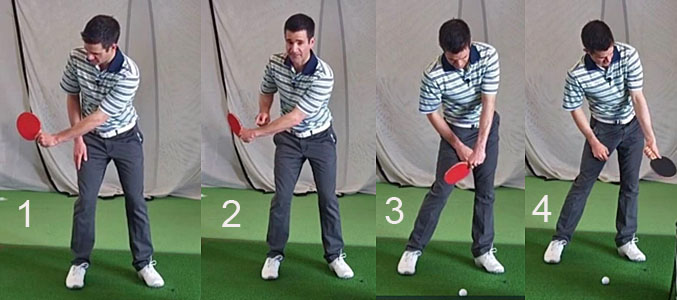
Image 1 is at the end of the transition phase - where the
left wrist is radially deviated and where he has a GFLW (slightly cupped left
wrist) and where the face of the paddle is open relative to the paddle path.
Note that his left forearm is pronated so that the watchface area of his
left lower forearm and the back of his left hand face partially skywards.
Image 2 shows how he is using a "motorcycle move" (twistaway maneuver) to close the paddle's face relative to the paddle's path.
Image 3 shows the start of the release phase where the left wrist moves from radial deviation to ulnar deviation and that causes the paddle to catch up to the straight left arm by impact - thereby simulating the release of PA#2.
Image 4 shows how he fully supinates his left forearm through the impact zone between P7 and P7.2 and that causes the ping pong paddle to roll over so that the red colored front of the paddle (which was facing partially skywards in image 1) is now partially facing the ground in image 2. Note that the watchface area of his left lower forearm and the back of his left hand are facing the camera (and partially skywards) in image 3 and then facing away from the camera (and partially groundwards) in image 4. One can understand why Tyler Ferrell uses the term "maxing-out" to describe the marked degree of left forearm supination that happens through impact in his recommended hand release pattern - when you consider the huge difference in his lower left forearm's rotational orientation between image 3 and image 4.
Tyler Ferrell believes that the left forearm should start to supinate during the late downswing's pre-impact time period and that it should continue to supinate in an uninterrupted (continuous/non-stop) manner through impact so that it can become fully supinated by P8, and that opinion is expressed in the following you-tube video called "Should You Supinate in the Golf Swing Release", which is available at https://www.youtube.com/watch?v=mG5vqemOzyg&t=724s .
In that video, Tyler Ferrell uses the following 3-D graph of left forearm supination (apparently captured from a professional golfer) to demonstrate what he believes should optimally happen with respect to the left forearm during the "release phase" of the golf swing.
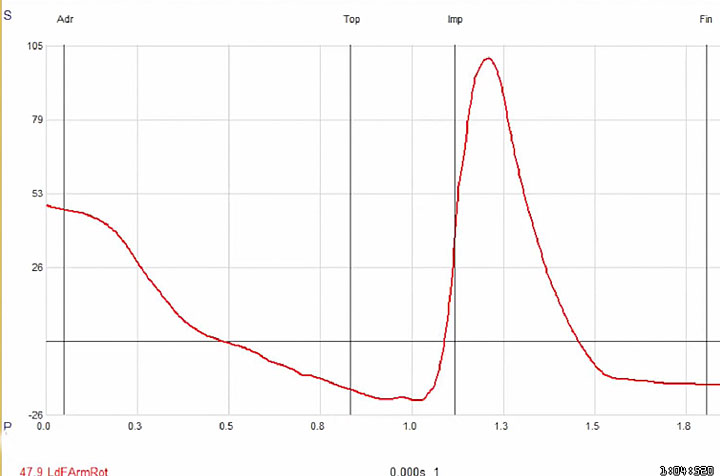
Supination is above the horizontal black zero line, and pronation is below
the horizontal black line. "Top" is the end-backswing position and "Imp" is
impact.
The red graph shows the amount of left forearm supination happening in the late downswing and early followthrough - between the two time points when the red graph has a nadir pre-impact and a peak post-impact. Note that the maximum degree of supination happens after impact and it is ~90 degrees in magnitude, and that it reflects Tyler Ferrell's opinion that a golfer should "max-out" his degree of left forearm supination between impact and P8. The slope of the red graph between these two points is reflective of the speed of left forearm supination and one can see that it is happening very fast through impact, and it is also happening in a continuously uninterrupted manner. This red graph apparently represents the rotational pattern of left forearm supination that Tyler Ferrell recommends for his "release phase".
What would this "uninterrupted left forearm supination" rotational pattern - where the left forearm continues to supinate rapidly in an uninterrupted manner through impact - visually look like in a "real life" golf swing if performed by a professional golfer?
I think that it would look like Luke Donald's hand release pattern - as depicted in the following series of capture images from a face-on swing video of Luke Donald's driver swing.
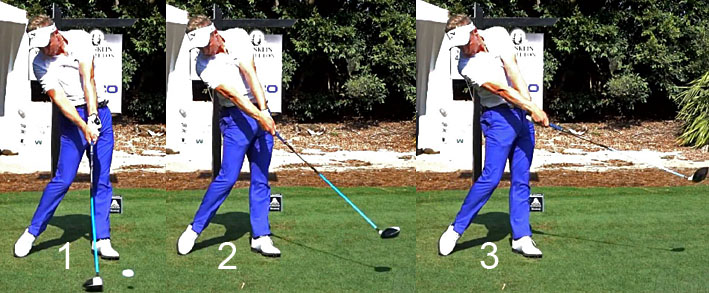
Image 1 is at impact, image 2 is at about P7.4 and image 3 is at about P7.7.
Note that the clubshaft is straight-in-line with his left arm at impact (image 1). Note that the back of his left hand and the watchface area of his left lower forearm is partially facing the camera in image 1.
Note how much the back of his left hand and the watchface area of his left lower forearm has rotated counterclockwise between image 1 and image 2 and that is primarily due to an uninterrupted left forearm supination phenomenon happening between impact and P7.4. Note that the fast and uninterrupted "left forearm supination" phenomenon has caused his clubshaft to bypass his left arm/forearm (from an angular rotational perspective) by P7.4. Note how he straightens his right arm and right wrist, and how he fully pronates his right forearm during his followthrough so that his right palm is rotating clockwise at roughly the same speed as his left palm is rotating counterclockwise.
Note how he continues to supinate his left forearm between P7.4 (image 2) and P7.7 (image 3) and note how it causes his clubshaft to bypass his left arm to an even greater degree. Note that Luke Donald has seemingly "maxed-out" his left forearm supination by P7.7, which is slightly faster than what would happen if he only "maxed-out" his left forearm supination by P8.
Most importantly, look at his clubface, and note how it closes very fast (relative to his clubhead arc) between impact and P7.7 - and also note that the speed/magnitude of his clubface-closure is directly proportional to the speed/magnitude of his left forearm supination motion that is happening during that P7 => P7.7 time period.
In his "Should You Supinate in the Golf Swing Release" video, Tyler Ferrell also features the golfer Tommy Fleetwood as an example of a golfer who also "maxes-out" his degree of left forearm supination by the P8 position. Does that mean that Tommy Fleetwood is continuously supinating his left forearm in an uninterrupted manner during his early followthrough between P7 and P7.4 - as depicted in that 3-D graph?
Let's analyse capture images of Tommy Fleetwood's P7 => P8 followthrough action from that driver swing featured in the video.

Image 1 is at impact, image 2 is at P7.4, image 3 is at P7.7 and image 4 is at P8.
Note that Tommy Fleetwood's clubshaft is straight-in-line with his left arm at impact and also at P7.4. That phenomenon - where the clubshaft does not bypass the left arm (from an angular rotational perspective) between impact and P7.4 - is characteristic of a drive-hold (DH) hand release action, and it is very different to the non-DH hand release action used by Luke Donald. What are the primary biomechanical characteristics that make a DH-hand release action possible between impact and P7.4+? The correct answer is that Tommy Fleetwood is not significantly flipping (bending) his left wrist or supinating his left forearm during that time period and he is controlling the rate-of-closure of his clubface (relative to his clubhead arc) by optimally controlling the rate of external rotation of his left humerus so that he can keep his clubface continuously square relative to his clubhead arc between P7 and P7.4. Tommy Fleetwood obviously has a "maxed-out" left forearm supination appearance at P8, but the left forearm supination phenomenon that is needed to achieve that "look" is only happening between P7.7 and P8 (representing what is called a "finish swivel action" in TGM terminology) and it is not happening continuously in an uninterrupted manner all the time between impact and P8. If the left forearm was supinating rapidly between impact and P7.4 then the clubshaft would bypass his left arm (from an angular rotational perspective) and his clubface would have a much higher rate-of-closure - as seen in Luke Donald's P7 => P7.4 followthrough time period. Further proof that Tommy Fleetwood is not significantly supinating his left forearm between impact and P7.4 can be derived from studying close-up views of his followthrough action - as seen in these close-up capture images of his followthrough action.

Image 1 is at impact, image 2 is at P7.4, image 3 is at P7.7 and image 4 is
at P8.
I have a placed a green dot in the middle of his left antecubital fossa (elbow pit) and 3 red dots in a straight-line over his left radial bone just above his left wrist crease. A changing rotational relationship between the green dot and the red dots (where the red dots rotate faster counterclockwise than the green dot) would reflect the presence of left forearm supination.
Note that you cannot see his left antecubital fossa in image 1 (impact) because his left humerus is internally rotated at impact. Note that the back of his left hand and watchface area of his left lower forearm is facing the camera at impact - which is expected considering the fact that he uses a strong left hand grip.
Note that you can clearly see the green dot at P7.4 (image 2) which means that he has significantly rotated his left humerus counterclockwise between impact and P7.4. Note that the red dots (signifying the position of his left lower radial bone) have not likely rotated counterclockwise more than his green dot (signifying the position of his left antecubital fossa) between impact and P7.4 and that suggests that there is no significant amount of left forearm supination happening between impact and P7.4.
Note that the back of his left hand and watchface area of his left lower forearm continues to rotate counterclockwise between P7.4 (image 2) and P7.7 (image 3) and that it is primarily due to continued external rotation of his left humerus without any additional left forearm supination component (as evidenced by the fact that the red dots are not rotating counterclockwise faster than the green dot between P7.4 and P7.7).
It is very important to note a few other biomechanical features of Tommy Fleetwood's DH-hand release action (delayed full-roll subtype) that is happening between impact and P7.4 (other than the previously mentioned fact that he externally rotates his left humerus in a controlled manner while avoiding any left forearm supination or any left wrist bending).
i) He does not stall the forward motion of his left arm between P7 and P7.4 (as happens in Luke Donald's P7 => P7.4 followthrough action) and his left arm is still swinging targetwards at the same angular velocity as his clubshaft thereby ensuring that the clubshaft does not bypass his left arm (from an angular rotational perspective) during that time period.
ii) He maintains a slightly bent right arm and slightly bent right wrist between P7 and P7.4. The biomechanical phenomenon of maintaining a bent right arm and a bent right wrist during the P7 => P7.4 followthrough time period is called "not running-out-of-right arm" and to achieve that desirable feature of a DH-hand release action, a golfer has to drive the right shoulder under the chin while simultaneously opening the pelvis and upper torso to the target. By contrast, if you look at the capture images of Luke Donald's P7 => P7.4 followthrough, you will notice that he prematurely "runs-out-of-right arm" (which causes his right arm and right wrist to prematurely straighten).
There is another subtype of DH-hand release action called the no-roll subtype - as seen in the following capture images of Charley Hoffmann's followthrough.

Note that Charley Hoffmann does not allow his clubshaft to bypass his left arm between impact (image 1) and P7.7 (image 5) from an angular rotational perspective, which means that he is essentially swinging his left arm targetwards at the same angular velocity as his released clubshaft. Note that he is not externally rotating his left humerus or supinating his left forearm or bending his left wrist during the P7 => P7.7 time period. Note that he is still maintaining a bent right arm and bent right wrist during his followthrough and he is not prematurely "running-out-of-right arm" - and that means that he must continue to actively drive his right shoulder under his chin while opening his pelvis and upper torso to the target. A golfer has to be extraordinarily flexible to be capable of performing a *no-roll subtype of DH-hand release action when hitting a wood or long iron, but it has the great advantage of allowing a golfer to keep the clubface square to the clubhead arc to well beyond impact. By contrast, if a golfer uses a non-DH hand release action secondary to excessive left forearm supination happening between P7 and P7.4 (like Luke Donald), then he is going to have a much higher ROC (rate-of-closure) of his clubface during his clubhead's travel time through the immediate impact zone between impact and P7.4. A student-golfer may wonder why a much higher ROC of the clubface happening in the followthrough after impact will be a disadvantage because the ball is long gone by the time the club reaches the P7.2 position, but the reality is that the biomechanics needed to execute a DH-hand release action (which ensures a low ROC of the clubface between P7 and P7.2) must start fractionally before impact at ~P6.9 and they must continue through impact to P7.2 (or even longer to P7.4). By contrast, if the golfer has a very high ROC of his clubface between P7 and P7.4 due to excessive left forearm supination, then it is very likely that he had a high ROC of his clubface through impact between P6.9 => P7.1 due to the same biomechanical phenomenon of excessive left forearm supination.
(* I have described the difference between a no-roll DH hand release action and a delayed full-roll hand release action in great detail in this review paper called "Hand Release Actions Through the Impact Zone" and also in part 7 of my video project on "How to Perform a Golf Swing Like a PGA Tour Golfer")
Many modern-day professional golfers (like Jordan Spieth, Justin Thomas, Dustin Johnson,, and Adam Scott) are using a DH-hand release action between impact and P7.2+ and that allows them to have a very stable clubface that manifests a very low ROC throughout the immediate impact zone between P7 and P7.2 (and often even further to P7.4+).
Here are capture images of their followthrough action - note their stable clubface, which has a very low ROC, during their clubhead's travel passage through the immediate impact zone between impact and P7.2 (and sometimes even further to P7.4+).
Jordan Spieth
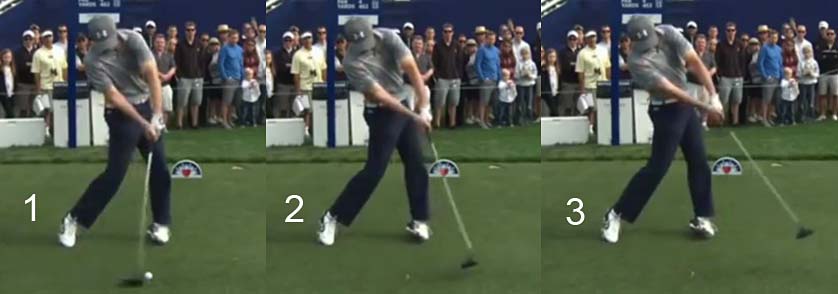
Justin Thomas
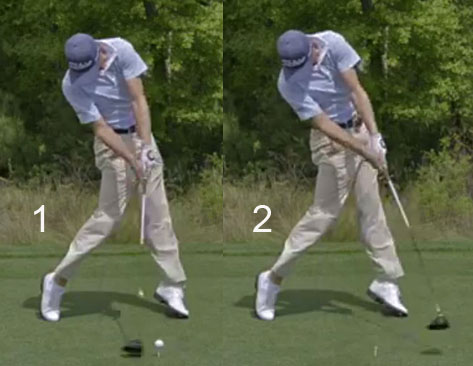
Dustin Johnson
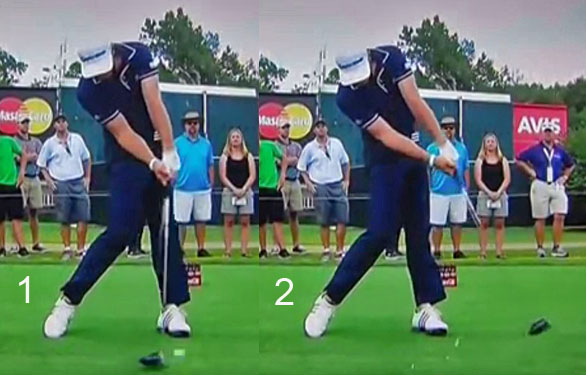
Adam Scott
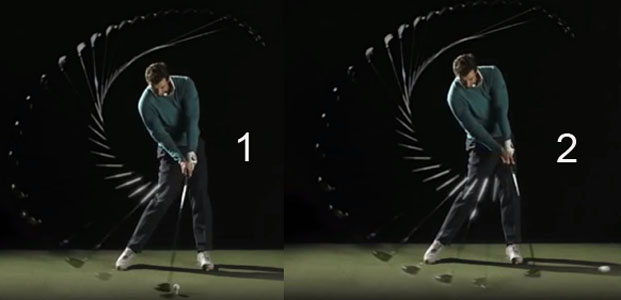
Now, I can readily imagine that many golfers, and golf instructors, are not
going to be convinced that Tommy Fleetwood is not significantly supinating
his left forearm between impact and P7.4 - based on those red dots not
rotating counterclockwise faster than the green dot in those capture images
that I have presented - and they are going to demand 3-D proof that a DHer
can really stop his left forearm supination temporarily between P7 and P7.4
and then suddenly start supinating rapidly again as he transitions into a
finish swivel action during the later followthrough between P7.4 and P8. So,
here is the proof - using the professional golfer, Jon Rahm,
as an example of a DHer (drive-holder).
Consider Jon Rahm's 3-D graph.
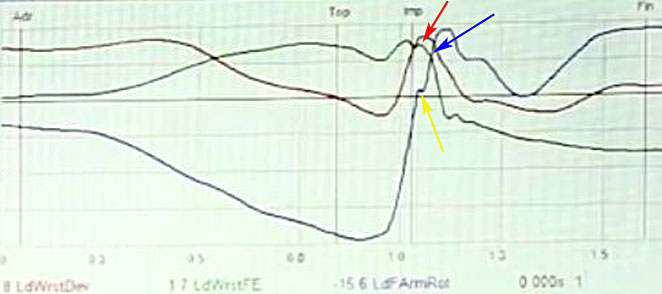
The green graph is his left wrist flexion-extension graph, the red graph is his left wrist radial deviation-ulnar deviation graph and the blue graph (lowest graph) is his left forearm supination-pronation graph. Note that there is a temporary plateau in his left forearm supination graph immediately post-impact (see yellow arrow) which indicates that he is not continuing to supinate his left forearm in a continuously uninterrupted manner for a short time period between impact and P7.2+, before he again starts to rapidly supinate his left forearm again during his finish swivel action. Also, note that there is a plateau in his left wrist flexion graph that happens simultaneously during that same impact to P7.2+ time period (see the green graph between the red arrow and the blue arrow) - where he comes into impact with a bowed left wrist and maintains approximately the same degree of left wrist bowing for a short time period post-impact.
Do capture images of Jon Rahm's early followthrough show the same evidence seen in that 3-D graph?
Here are capture images of Jon Rahm's early followthrough action.
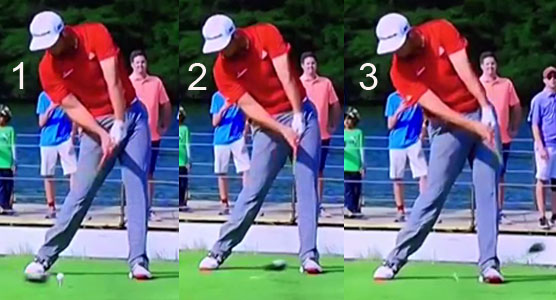
Image 1 is at impact, image 2 is at P7.1 and image 3 is at about P7.3.
Note that Jon Rahm is a perfect example of a DHer by noting that his clubshaft does not bypass his left arm (from an angular rotational perspective) between impact and P7.3 and that he keeps the clubface continuously square to the clubhead arc during the P7 => P7.3 time period.
Note that Jon Rahm comes into impact with a bowed left wrist and that he maintains roughly the same degree of left wrist palmar flexion between impact and P7.3.
Note that there is no visual evidence to suggest that Jon Rahm is continuing to supinate his left forearm in a continuously uninterrupted manner between impact and P7.3 (like Luke Donald). Note that he is controlling the degree of counterclockwise rotation of the back of his bowed left wrist (and therefore clubface) between impact and P7.3 by controllably rotating his left humerus in a counterclockwise direction, and that defines him as using a delayed full-roll subtype of DH-hand release action.
I believe that all professional golfers have to use left forearm supination pre-impact in order to square the clubface by impact and that the amount of required left forearm supination is inversely proportional to left hand grip strength. However, it is possible for a professional golfer to use variable amounts of left forearm supination post-impact between P7 and P8. A professional golfer (like Charley Hoffmann in those capture images of Charley Hoffmann's followthrough action) may decide to use no left forearm supination between P7 and P8 because he uses a no-roll subtype of DH-hand release action and he never transitions into a finish swivel action before P8. Alternatively, a professional golfer (like Jon Rahm) may decide to use a delayed-full roll subtype of DH-hand release action between impact and P7.2 (or even further to P7.4) before transitioning into a finish swivel action at some time point between P7.4 and P8. Alternatively, a professional golfer may decide to use a non-DH hand release action by using a significant amount of left forearm supination between impact and P7.4 (like Luke Donald) and where the left forearm continues to supinate in a continuously uninterrupted manner between ~P6.5 and P7.4. The advantage of using a DH-hand release action (rather than a non-DH hand release action due to the use of a significant amount of left forearm supination between impact and P7.4) is the fact that it allows a professional golfer (or skilled amateur golfer) to have a very low ROC of his clubface through the immediate impact zone between impact and P7.2 (or even better to P7.4+).
I can readily imagine a student golfer (developing golfer), who has never heard of the concept of a drive-hold hand release action, asking this relevant question-: "What are the key features of a drive-hold hand release action and what are the "do's and dont's" that the golfer must perform in order for him to become an exemplary DHer?"
I will offer some brief pointers in an answer to that question.
First of all, a student golfer needs to understand that left forearm supination is obligatory in the late downswing's pre-impact time period in order to acquire a square clubface by impact (as described in topic number 1), and that the amount of required left forearm supination is inversely proportional to left hand grip strength. Secondly, he needs to understand that post-impact left forearm supination is optional and it is only necessary if he wants, or needs, to perform a finish swivel action that swivels the clubshaft back onto the inclined plane after P7.2 (or preferably after P7.4). It requires tremendous flexibility and a very good torso rotation through impact in order to perform a no-roll DH-hand release action (like Charley Hoffmann), who does not perform a finish swivel release action between P7 and P7.8. Most amateur golfers would find it much easier, and much more biomechanically comfortable, to perform a finish swivel action at an earlier stage during their followthrough - but they need to delay that finish swivel action if they want to be a DHer who maintains a stable clubface, that has a low ROC, between P7 and P7.2. To ensure that the clubface remains square to the clubhead arc to at least P7.2 (and even better to P7.4) he should avoid using any significant left forearm supinatory motion, or any significant left wrist flipping type of motion, through the immediate impact zone between P7 and P7.2+.
Consider the following series of capture images of Roger Federer performing a backhanded tennis stroke (where he is hitting a straight shot without slice spin or top spin).

Image 1 shows him at his P4 position. Note that the back of his lead hand and racquet face is not vertical to the ground and it is angled back slightly. To get a square racquet face at impact (image 4), where the racquet face is vertical to the ground, he needs to supinate his lead forearm during his forward swing action. The amount of needed lead forearm supination is very small because Roger Federer adopts a strong lead hand grip for his backhanded tennis shots.
However, look at what he does between impact (image 4) and P8+ (image 5). Note that he abducts his lead arm away from his body without supinating his lead forearm between impact and P8 and that allows him to keep his racquet face continuously vertical to the ground during his followthrough action, and that followthrough technique represents a perfect example of a DH-hand release action (where the racquet never bypasses his lead arm from an angular rotational perspective).
The same principle applies to a golf swing action - so, consider Sasho MacKenzie's one-arm golf swing's followthrough action at https://www.youtube.com/watch?v=GgF_9IfROAU
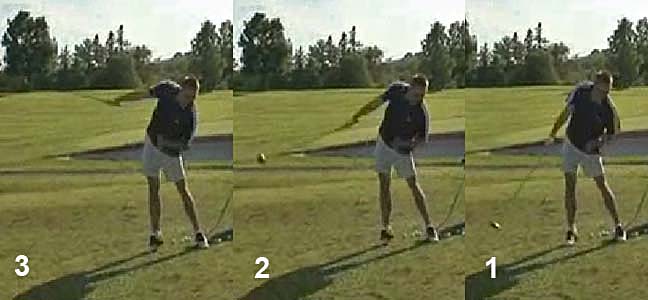
Image 1 is at P7.4, image 2 is at P7.8 and image 3 is at P8.3.
Note that he never bends (extends) his flat lead wrist, or supinates his lead forearm, or externally rotates his lead humerus, during his entire followthrough action - while he abducts his lead arm progressively further away from his body. That no-roll type of followthrough technique allows him to keep the clubshaft straight-in-line with his lead arm during his entire followthrough action and it also allows him to keep the clubface square to his clubhead arc throughout his entire followthrough action. Sasho Mackenzie's followthrough represents a perfect example of a no-roll subtype of DH-hand release action where the clubface is square to the clubhead arc to well beyond P7.4.
Note that his torso is only slightly open to the ball-target line during his entire followthrough action and that he does not continue to rotate his pelvis and upper torso more clockwise during his followthrough action. Note that his rear shoulder remains behind his chin and it never bypasses his chin during his followthrough action. That type of followthrough technique, where the rear shoulder does not move forward under the chin in a targetwards direction, would therefore not be applicable to a two-handed golf swing technique because the golfer would "run-out-of-rear arm" and his rear hand could never reach his lead hand at all time points during the followthrough action.
To perform the same no-roll subtype of DH-hand release action when using two arms, a golfer will need to rotate his pelvis and upper torso much more open during his followthrough action so that his rear shoulder socket can get closer to the target as both arm arms are extended away from the body. To prevent the problem of "running-out-of-rear arm" the golfer will need to keep the rear shoulder moving continuously targetwards throughout the followthrough action - as seen in these capture images of Charley Hoffmann's no-roll subtype of DH-hand release action.

Note how Charley Hoffmann's upper torso and his two shoulder sockets rotate
counterclockwise in a continuous manner between impact (image 1) and
P7.7 (image 5). Note that he can still maintain a slightly bent right wrist
all the way to P7.7, which is a good indicator that he is not
"running-out-of-right arm". Note that he does not bend (extend) his lead
wrist, or supinate his lead forearm, or externally rotate his lead humerus,
between P7 and P7.7 and that allows him to keep the clubshaft
straight-in-line with his lead arm (from an angular rotational perspective)
all the way from P7 to P7.7 and it also allows his to keep his clubface
square to his clubhead arc during that entire followthrough time period.
It takes tremendous flexibility to use that no-roll subtype of DH-hand release action, especially when swinging longer clubs, so many professional golfers only use that technique for their short iron shots.
Consider Tiger Woods performing a more limited version of a no-roll subtype of DH-hand release action in this swing video at https://www.youtube.com/watch?v=NSEfbgRheEA
Here are capture images from the swing video.
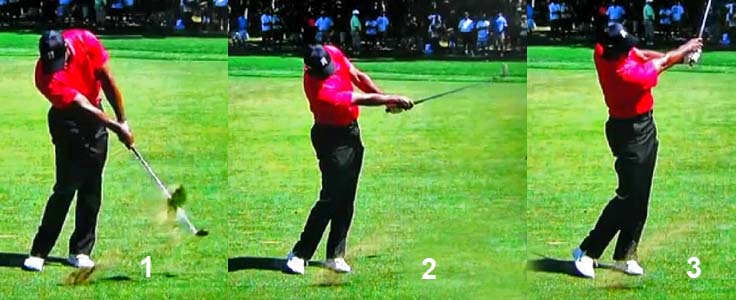
Note that Tiger Woods is using the no-roll subtype of DH-hand release action
from impact to P7.4 (image 1) and that he then subsequently transitions into
a finish swivel action later in his followthrough action (images 2 & 3). Note
that he does not bend his lead wrist, or supinate his lead forearm, or
externally rotate his lead humerus, between P7 and P7.4 - and that allows him
to avoid having the clubshaft bypass his lead arm (from an angular
rotational perspective) and it also allows him to keep the clubface
continuously square to the clubhead arc. Note how much he has to
rotate his upper torso counterclockwise during his P7 => P7.4 followthrough
action, and note how much his right shoulder moves targetwards under his chin,
and that allows him to maintain a slightly bent right elbow and slightly bent
right wrist all the way to P7.4, and thereby avoid a "running-out-of-right
arm" problem.
Because it is physically easier to use the delayed full-roll subtype of DH-hand release action (as seen in those capture images of Tommy Fleetwood's' followthrough action), it is the more common type of DH-hand release action used by professional golfers (like Dustin Johnson, Jon Rahm, Adam Scott and Justin Thomas) who use a DH-hand release action technique. In this subtype of DH-hand release action, a golfer allows the left humerus to abduct and externally rotate at a perfectly controlled speed that ensures that the left arm and clubshaft have the same angular rotational velocity, and that biomechanical action prevents the clubshaft from bypassing the left arm (from an angular rotational perspective) during the early followthrough time period - while the golfer simultaneously avoids any left wrist bending, or left forearm supination, from happening during that early followthrough time period (that precedes the transition to a finish swivel action).
As I have previously mentioned, there are two critical biomechanical actions that a golfer must avoid if he wants to be a DHer - any left wrist flipping, or left forearm supination, biomechanical actions between P7 and P7.2 (or even better to P7.4).
Let's consider what factors could cause left wrist flipping through impact.
Left wrist flipping (left wrist extension) through impact could be an intentional action if the golfer deliberately uses the rotation-about-the-coupling point hand release action recommended by some golf instructors (eg. Brian Manzella, Michael Jacobs and Richard Franklin).
Rotation-about-the-coupling point hand release action - as described in a Richard Franklin video (https://youtu.be/k0r3l0QdAqg).
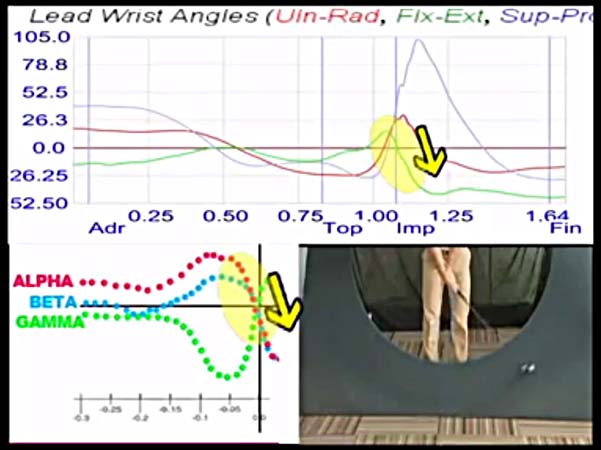
In this illustration, Richard Franklin is demonstrating a rotation-about-the coupling point hand release action. The green graph represents the left wrist flexion => extension graph and one can see how the left wrist extends rapidly through impact (as also seen in the small photo image in the lower right hand corner). In that type of hand release action (which actually start in the late downswing) a golfer is encouraged to i) actively push against the aft side of the clubshaft with the right hand while ii) stalling the forward motion of the left hand through impact as the golfer simultaneously iii) pulls the top of the club handle back (away from the target) with the left hand so that the dual hand motions induce a rotation of the club handle around the coupling point (which is a point midway between the hands on the club handle). Note how a rotation-about-the-coupling point hand release action causes the clubshaft to bypass the hands. If the clubshaft abruptly bypasses the hands through impact, then the fulcrum point of the clubshaft motion becomes situated at the level of the hands (and not at the level of the left shoulder socket as occurs in a DHer). That will cause the clubhead arc's radius to be radically shortened and it will cause the clubhead to move more quickly inside-left thereby causing the clubface to close more relative to the ball-target line even if the golfer avoids any left wrist circumduction motion at the level of the left wrist (= left wrist rolling motion due to the combination of left wrist extension + left wrist radial deviation) that can potentially increase the degree of clubface closure if it happens simultaneously with the left wrist extension phenomenon. There is also the problem of timing the left wrist extension phenomenon so that the golfer can avoid any pre-impact left wrist flipping, but perfect timing is obviously difficult to achieve on a consistent basis when swinging a driver at clubhead speeds of 100-125mph through impact. Hopefully, any reader of this review paper can more easily understand why a rotation-about-the-coupling point hand release action will invariably produce a non-DH hand release action and potentially a higher ROC of the clubface between P7 and P7.2 (if it is associated with a significant degree of left wrist circumductory motion that rolls the club handle while the left wrist bends).
Left wrist flipping between P7 and P7.2 can also be an unintentional action if the golfer stalls the forward motion of the left arm/hand and/or if the golfer unintentionally applies too much push-pressure against the aft side of the club handle (below the coupling point) with the right hand in a slap-hinge manner. That type of non-DH hand release action is much more likely to occur in golfers who use a swing-hitting technique where they actively straighten the right arm and/or right wrist during the late downswing in an inconsistent manner from swing-to-swing.
Now, let's consider factors affecting the amount of left forearm supinatory motion that can happen through impact - starting in the late downswing and continuing in an interrupted manner to P7.4+.
I believe that if a golfer wants to be a DHer who wants to avoid any significant amount of left forearm supination from happening between P7 and P7.4, then he needs to understand the "forces" that can potentially produce a continuously uninterrupted left forearm supinatory motion through impact.
The worst-case scenario that will invariably produce a continuously uninterrupted left forearm supinatory motion through impact, and therefore a non-DH hand release action, is the use of active muscular forces in the late downswing that promote right forearm pronation and/or left forearm supination.
Unfortunately, many golf instructors, like AJ Bonar, are advocates of an active roll motion of the two forearms through impact, which is called a hand crossover release action.
Here is an extract from a golf magazine article where AJ Bonar describes his hand crossover release action: "About two or three feet before your hands reach impact, assertively rotate them toward the target. Imagine you're gripping a screwdriver and turning it counterclockwise. This closes the clubface, generating big-time power."
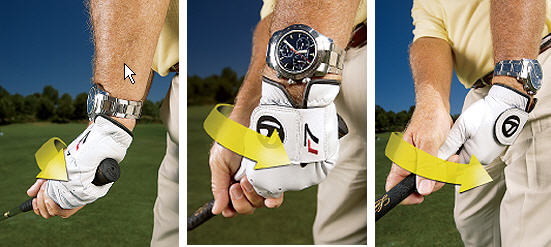
AJ Bonar often states that a golfer should "feel" that he is rolling the top of the clubface over the bottom half of the clubface through impact by using his recommended "active screwdriver move".
I think that AJ Bonar's recommended "hand crossover release action" is irrational golf instructional advice that will invariably produce a high ROC of the clubface through the immediate impact zone between P7 and P7.2, and it is a "move" that any golfer, who wants to learn how to become a DHer, should rigorously avoid using in his golf swing action.
I believe that any left forearm supination happening in the late downswing's PA#3 release action (which is needed to square the clubface by impact) should be passive (and not active).
What do I mean by a passive left forearm supinatory motion?
To better understand the term "passive" with respect to the left forearm's supinatory motion that can happen between P6 and P8, I think that a golfer should try to understand the physical phenomenon called the RYKE effect.
Here is link to a you-tube video where Kevin Ryan describes the RYKE effect - https://www.youtube.com/watch?v=PyeDPyfex9M&t=116s
What Kevin Ryan did was modify the central arm of a double pendulum swing model by inserting a passive cylindrical joint device into the peripheral end of the central arm. That allows the peripheral end of the central arm to rotate about its longitudinal axis thereby mimicking a passive left forearm supinatory motion. If you watch the video, you will note that even a small transverse force that moves the clubshaft off-plane can induce the RYKE effect where the clubshaft's single-in-plane pendular motion is changed to a conical pendular motion, and you will also note that the clubface will rotate through impact in a continuously uninterrupted manner (as seen in the 3D graph presented by Tyler Ferrell).
Here are capture images from Kevin Ryan's video showing what effect the RYKE effect phenomenon will have on a golfer's golf swing action.

Images have been flipped horizontally to convert the left-handed golfer into a right-handed golfer
Image 1 is at P6, image 2 is at P6.6, image 3 is at impact and image 4 is at
P7.5.
Note how his left forearm progressively supinates between P6 and impact, and that is obligatory if this golfer (who uses a neutral left hand grip) wants to square the clubface by impact. However, note how the golfer continues to supinate his left forearm in a continuously uninterrupted manner between impact and P7.5, which produces a rolling subtype of non-DH hand release action where the clubshaft bypasses the left arm (as seen in Luke Donald's early followthrough action).
The speed of rotation of the clubshaft (around its longitudinal axis) through the immediate impact zone between P7 and P7.2 in a non-DH hand release action due to left forearm supination can vary considerably in different golfers because the speed of left forearm supination can vary considerably, and if it happens very fast it will result in an exaggerated rolling subtype of non-DH hand release action, which I call a *roller subtype of non-DH hand release action.
(* When I use the term "rolling" subtype with respect to a non-DH hand release action that is due to left forearm supination, that means that the speed of clubface rolling per unit degree of clubhead travel along the clubhead arc is much slower because the speed of left forearm supination is slower - and when I use the term "roller" subtype that means that the speed of clubface rolling per unit degree of clubhead travel is much faster because the speed of left forearm supination is faster)
Here is an animated gif example of Phil Mickelson performing a roller subtype of non-DH hand release action between P7 and P7.2.
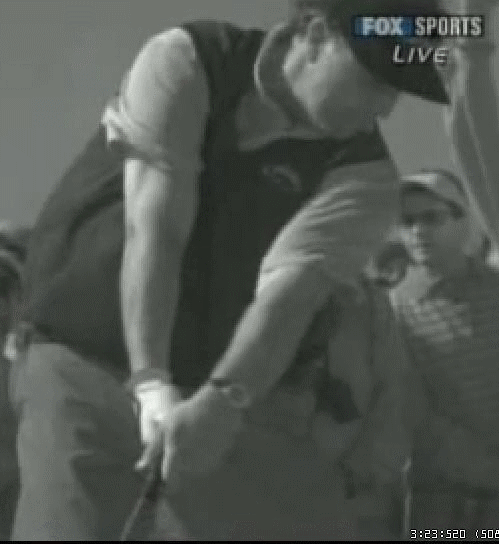
Note how Phil Mickelson's lead hand rotates continuously
clockwise due to an unrestrained lead forearm supinatory motion through
impact. The RYKE effect may be in play, but it cannot be the only factor
responsible for his uncontrolled lead forearm supination through impact
because he has a small accumulator #3 angle at the time of clubshaft rolling,
and he may be subconsciously (non-intentionally) adding some lead forearm
supinatory muscular torque, +/- some rear forearm pronatory muscular torque,
during his late downswing after P6.7.
Some golf instructors actually recommend a rolling type of hand release action by advising golfers to relax their arms/forearms so that the lead forearm can rotate passively through impact under the influence of the RYKE effect - see this you-tube video at https://www.youtube.com/watch?v=UAIdIdWoe9g&t=127s called the "L to L Drill - the Most Important Golf Lesson You Need to Know" by Mike Malaska. Note how Mike Malaska is mimicking a roller hand release action - first with his left arm, then with his right arm, and then with both arms together.
If a golfer wants to become a DHer, then he cannot afford to heed Mike Malaska's advice because it will invariably result in a rolling subtype of non-DH hand release action through impact.
So, what can a student-golfer (developing golfer), who wants to become a DHer, do in his late downswing and early followthrough to avoid becoming a non-DHer, who performs a rolling subtype of non-DH hand release action between P7 and P7.2?
First of all, if a golfer wants to become a DHer, then he needs to use a passive left forearm supinatory motion in his late downswing in order to get a square clubface by impact. If the left forearm supinatory motion is passive, and operating in accordance with the passive dynamics underlying the RYKE phenomenon, then the golfer should think of the counterclockwise rolling motion of the left forearm automatically/naturally slowing down as the left hand approaches impact - as the left forearm gets back to its same resting state of pronation that existed at address. The resting state of pronation at address depends on left hand grip strength, and golfers who have a strong left hand grip at address will naturally have more left forearm pronation at address than a golfer who has a weak-or-neutral left hand grip. In other words, a golfer should not think of deliberately rolling the back of the left hand counterclockwise beyond its resting state of pronation at address. So, if a golfer adopts a weak or neutral left hand grip at address where the back of the left hand roughly faces the target at address, then he should think of getting to impact with the back of his left hand facing the target to roughly the same degree. His second ancillary thought must be the "idea" of avoiding any stalling of the targetwards motion of the left arm/hand at impact and he must ensure that the left arm/hand continuously moves targetwards through impact to P7.2 (or even better to P7.4) at an angular velocity that perfectly matches the targetwards angular velocity of the clubshaft, and that will ensure that the clubshaft remains straight-line-aligned with the left arm all the way to P7.4. Here is an example - Kelli Oride.
Kelli Oride swing video - https://www.youtube.com/watch?v=p7hBadAiMcA
Here are capture images from Kelli Oride's swing video.

Image 1 is at impact, image 2 is at P7.2 and image 3 is at P7.4. Image 4 is
a composite image showing the targetwards motion of her left hand and
clubshaft/clubhead between P7 and P7.4.
The diagram depicts her left shoulder socket in black, her left arm in red and her clubshaft in green. The blue dot represents her left hand and the orange dot represents the clubhead.
Note how Kelli Oride keeps the back of her left hand continuously facing the target between P7 and P7.4 and there is very little counterclockwise rotation of her left hand happening between P7 and P7.4. Also, note that her left hand (represented by the blue dot in the diagram) moves targetwards at an angular velocity that perfectly matches the angular velocity of the clubhead (orange dot) and that action allows Kelli Oride to keep her LAFW intact, and it thereby prevents the clubshaft from bypassing her left arm (from an angular rotational perspective).
Another swing thought that is very useful for a golfer, who wants to become a DHer (like Kelli Oride), is how to usefully use the right arm/hand to synergistically assist the left arm/hand in efficiently performing a DH-hand release action. Note that Kelli Oride does not fully straighten her right arm, or her right wrist, between P7 and P7.4 and she straightens her right elbow at an optimum speed that can allow her right palm to continuously apply push-pressure against PP#1 (which is located over the base of her left thumb) and that small amount of push-pressure that is continuously being applied by the right palm against PP#1 can help her to optimally control the speed of forward (targetwards) motion of the left hand between P7 and P7.4 - while she simultaneously avoids any unwanted right forearm pronation, or left forearm supination, during that same P7 => P7.4 time period. To achieve that goal of fruitfully using the straightening right arm to synergistically assist her left arm/hand to more efficiently execute a DH-hand release action through the immediate impact zone, Kelli Oride must avoid "running-out-of-right arm" by also ensuring that her right shoulder continuously moves forward (targetwards) under her chin at an optimum speed.
Contrast Kelli Oride's perfectly executed DH-hand release action with the roller hand release action often seen in Phil Mickelson's driver swing action.
Here is a capture image of Phil Mickelson's driver swing action at the P7.4 position.
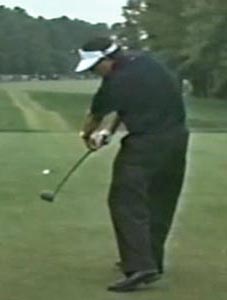
Note that Phil Mickelson is performing a roller subtype of non-DH hand release action, which causes the clubface to roll closed relative to his clubhead arc. Note that his rear palm is not even in contact with his lead thumb at PP#1 because he has "run-out-of-rear arm" - evidenced by the fact that i) his rear shoulder is far back and it has not moved targetwards under his chin and ii) his rear arm is fully straight and iii) his rear forearm has fully pronated and iv) his rear wrist has fully straightened.
If a golfer "runs-out-of-right arm" during the late downswing, or early followthrough, then he cannot usefully use the straightening right arm/hand to synergistically assist the left arm/hand in efficiently performing a DH-hand release action through impact. Now, contrast Phil Mickelson's non-DH hand release action (roller subtype) with Jordan Spieth's superb execution of a DH-hand release action.
Capture images from a Jordan Spieth driver swing video.

Note that Jordan Spieth is performing a perfectly executed DH-hand release action between impact (image 1) and P7.5 (image 3) - note that he keeps the clubface continuously square to his clubhead arc and that he continuously prevents his clubshaft from bypassing his left arm (from an angular rotational perspective). Note how he keeps his right shoulder continuously moving targetwards under his chin while he opens his upper torso more to the target, and note how he maintains a slightly bent right arm and a slightly bent right wrist all the way to P7.5 - and those biomechanical elements are all "indicator signs" of a golfer who is not "running-out-of-right arm".
Here are close-up views of Jordan Spieth's hands between impact and P7.5.
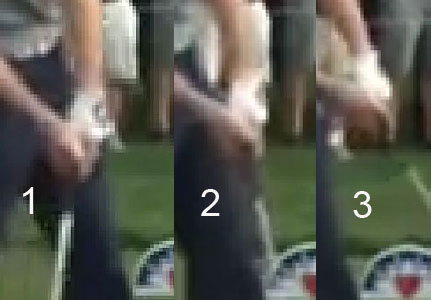
Image 1 is at impact, image 2 is at P7.2 and image 3 is at P7.5.
Jordan Spieth uses a Vardon style of left/right hand grip that allows him to position his right palm over the base of his left thumb at address.
Note that Jordan Spieth's right palm is closely applied against his left thumb throughout his followthrough action, and that allows any push-pressure being continuously applied by his right palm against PP#1 (which is located over the base of his left thumb) to synergistically assist his left hand in more efficiently executing a DH-hand release action between P7 and P7.4 if the right arm straightens at an optimal speed that allows the right hand to move targetwards at the same speed as the left hand. I obviously don't know if Jordan Spieth's right palm is continuously applying a steady amount of push-pressure against the base of his left thumb between P7 and P7.4 because no golf researcher has ever measured the amount of push-pressure being applied by the right palm against PP#1 during a golfer's followthrough action - but I can readily imagine that the continuous application of push-pressure by the right palm against PP#1 (which is located over the base of the left thumb) by exactly the optimum amount could be extremely useful in helping Jordan Spieth's left arm/hand more efficiently perform a DH-hand release action between P7 and P7.4. If a golfer uses a perfectly controlled straightening of the right arm between P7 and P7.4 to work in perfect synchrony with the left arm, which is swinging targetwards at an angular velocity that matches the angular velocity of the released club, then he can also ensure that the right forearm does not excessively pronate during the P7 => P7.4 time period. Note that Jordan Spieth's right palm remains behind the grip between P7 and P7.4 and it never rolls over the left hand (as seen in a hand crossover hand release action) and that helps Jordan Spieth to avoid the automatic/natural "left forearm supination + right forearm pronation" that would happen if the RYKE effect was unrestrained.
In summary, a DHer must constrain the RYKE effect to ensure that it only happens pre-impact, and not post-impact, by using a number of biomechanical elements post-impact that characterise a DH-hand release action.
Those biomechanical elements may include some, or all, of the following features:
i) The golfer must avoid stalling the targetwards motion of the left arm at impact and he must ensure that he continues to swing the left arm targetwards at an angular velocity that matches the angular velocity of the released club, so that the clubshaft does not bypass the left arm between P7 and P7.2 (or even better to P7.4).
ii) The golfer must think of keeping the back of the GFLW (or AFLW) roughly facing the target for longer through impact to at least P7.2, and he must avoid allowing the back of the GFLW (or AFLW) to rotate too much counterclockwise due to an unrestrained RYKE effect (that is manifested biomechanically as a continuously uninterrupted left forearm supinatory motion happening between P7 and P7.2, and even beyond P7.2).
iii) If the golfer decides to use the delayed full-roll subtype of DH-hand release action, then he will be controlling the speed of counterclockwise rotation of his GFLW (or AFLW) between P7 and P7.2 (or even better to P7.4) by modulating his speed of external rotation of the left humerus so that the intact LAFW (= straight left arm and the clubshaft that is continuously straight-line-aligned with the left arm) can rotate counterclockwise at a slow rotational speed that keeps the clubface continuously square to the clubhead arc, thereby generating the lowest possible ROC of the clubface between P7 and P7.2 (or even better to P7.4).
iv) If a golfer decides to use the no-roll subtype of DH-hand release action, then he must rotate his upper torso and the two arms counterclockwise at a rotational speed that keeps the clubface continuously square to the clubhead arc, thereby generating the lowest possible ROC of the clubface between P7 and P7.2 (or even better to P7.4).
v) To improve his control of the speed of counterclockwise rotation of the intact LAFW (= straight left arm and clubshaft that is continuously straight-line-aligned with the left arm), the golfer can potentially use his right arm/hand to help him to more controllably modulate the speed of counterclockwise rotation of the intact LAFW between P7 and P7.2 (or even better to P7.4). To make that enhanced "level of DH-control" biomechanically possible, the golfer must ensure that his right shoulder continues to actively move under his chin in a targetwards direction so that he doesn't "run-out-of-right arm" between P7 and P7.4. He must also ensure that the right arm remains slightly bent and that it doesn't excessively straighten (which indicates a "running-out-of-right arm" scenario) and he must also try to maintain a bent right wrist to at least P7.2 (or even better to P7.4) with the goal of continuously maintaining an optimum level of push-pressure exerted by the right palm against PP#1 (which is located over the base of the left thumb). Optimally, the right palm should be moving targetwards as fast as the left hand is moving targetwards, which means that the targetwards motion of the two hands is perfectly synchronised. Finally, he must control the speed of pronation of his right forearm to avoid any possibility of excessive right forearm pronation inducing an unintentional hand-crossover release phenomenon at any time point during the early followthrough time period.
(* By the way, if you are interested in better understanding the basic differences between a DH-hand release action versus a non-DH hand release action, you can read this short review paper at http://perfectgolfswingreview.net/VP9.html . If you would like to learn even more about the biomechanics of a DH-hand release action, then you can read this detailed review paper at http://perfectgolfswingreview.net/HandRelease.htm or you can view this part 7 video at https://youtu.be/MzW3eCrM5KU where I start discussing the topic of hand release actions at the 21:57 minute time point of that video)
It is interesting that so many golf instructors are not willing to respond to my criticism when I post critical comments in response to their you-tube videos and they simply block my comments from being viewable by the public. So, for example, I posted many critical comments (counterarguments) in the comment section of this Tyler Ferrell video called "Should you supinate in the golf swing release", which is available at https://www.youtube.com/watch?v=mG5vqemOzyg&t=724s . However, you will not see them because Tyler Ferrell has blocked them. Why does Tyler Ferrell block my comments, instead of replying to my criticism and providing a counterargument?
Tyler Ferrell is not the only golf instructor who blocks my comments and makes them invisible to the public. Chuck Quinton (of RotarySwing.com) has done the same with respect to the following two you-tube videos that relate to this topic of the release - i) Are You Being Taught the Wrong Way to Release the Club at https://www.youtube.com/watch?v=F1guwbFWCO4 and ii) Yep - All Tour Pros Release the Club the RotarySwing.com Way! at https://www.youtube.com/watch?v=1GYx7Y6FtTY&t=9s - and my comments in the comment section of those two videos are not visible to the public. Chuck Quinton is making the same claim as Tyler Ferrell in those two videos in that he is claiming that all professional golfers perform a forearm rotational motion (left forearm supination + right forearm pronation) during their followthrough action, but the "real life" reality is that it is obviously only happening when they perform a finish swivel action that is biomechanically needed to swing the clubshaft back onto the inclined plane at some time point during the followthrough time period. Some professional golfers perform their finish swivel action early in their followthrough action (like Luke Donald) while other professional golfers perform it later during their followthrough action (like Tommy Fleetwood). I am not disputing the fact that most professional golfers rotate their forearms when they perform a finish swivel action during their followthrough - because the "video evidence" is indisputable! I am simply providing a counterargument that claims that DHers keep their clubface square to the clubhead arc for a short time period between impact and P7.2 (and sometimes even further to P7.4) by avoiding any left wrist flipping, or any significant left forearm supination, motion from happening during that early followthrough time period, and that they usually delay their finish swivel action so that it only happens during their later followthrough action. Neither Tyler Ferrell or Chuck Quinton seems to be aware of this critically important observation!
Now, let's consider Tyler Ferrell's "real life" golf swing action. Is he continuously supinating his left forearm in an uninterrupted manner between P7 and P7.2 (as seen in this 3D graph) and does he transition immediately into a finish swivel action soon after impact (like Luke Donald)?
Here is a link to Tyler Ferrell's analysis of his personal golf swing action - "Swing Analysis - Tyler Ferrell", which is available at https://www.youtube.com/watch?v=VhlK85qErZ0&t=7s
Here are capture images from that swing video.
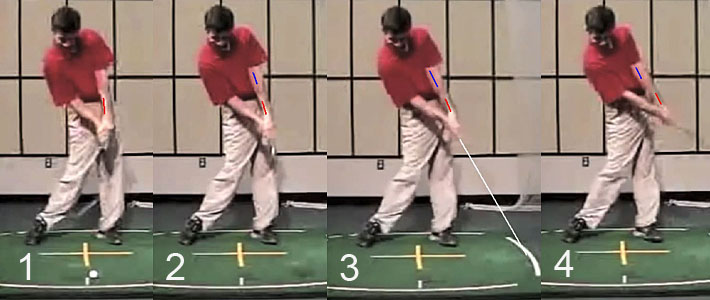
Image 1 is at impact, image 2 is at P7.2, image 3 is at P7.3 and image 4 is
at P7.75.
I have drawn a blue line down the middle of his left antecubital fossa and a red line over his left radial bone just above his left wrist crease. I have drawn a white line to show his clubshaft position in image 3 because his clubshaft's image is very indistinct.
Note that his clubshaft has a small amount of forward shaft lean at impact (image 1) because he has a slightly bowed left wrist. Note that his left antecubital fossa is not visible from a face-on viewing perspective because his left humerus is internally rotated at impact. Note that his left lower radial bone is visible and that indicates that his left forearm is likely slightly supinated at impact, which is not surprising seeing that I have previously demonstrated that a golfer (who adopts a neutral left hand grip) will need more left forearm supination during the late downswing's PA#3 release action in order to get a square clubface by impact - if the left wrist is bowed at impact.
Image 2 shows that his clubshaft has not bypassed his left arm (from an angular rotational perspective) at the P7.2 position. Note that his left antecubital fossa is now visible, which means that he is externally rotating his left humerus. Note that the red line does not appear to have rotated more counterclockwise relative to the blue line suggesting that he is not increasingly supinating his left forearm between P7 and P7.2.
Image 3 is at P7.3 - note that his clubshaft has still not bypassed his left arm (from an angular rotational perspective) which means that he is a DHer. Although it is difficult to see his clubfaee, it looks like he is keeping his clubface square to the clubhead arc and there is no evidence that his clubface is closing rapidly relative to his clubhead arc (as seen in Luke Donald's early followthrough). Note that his left antecubital fossa is continuing to rotate counterclockwise, but there is no evidence that the red line is rotating more counterclockwise relative to the blue line. In other words, Tyler Ferrell is using a delayed full-roll subtype of DH-hand release action - like Tommy Fleetwood. Note that he maintains a slightly bent right elbow, and slightly bent right wrist, all the way between impact and P7.3 and Tyler Ferrell is therefore a perfect example of a DHer who does not prematurely "run-out-of-right arm"!
Image 4 shows that Tyler Ferrell is transitioning into a finish swivel action, which obviously requires a lot of left forearm supination, and that causes the clubshaft to bypass his left arm from an angular rotational perspective. However, his finish swivel action is happening after P7.3 and it is not happening very soon after impact (as recommended by Mike Malaska and as seen in golfers who use a roller subtype of non-DH hand release action).
Here are capture images comparing Luke Donald (image 1), Tyler Ferrell (image 2) and Tommy Fleetwood (image 3) at the ~P7.3 - P7.4 position.
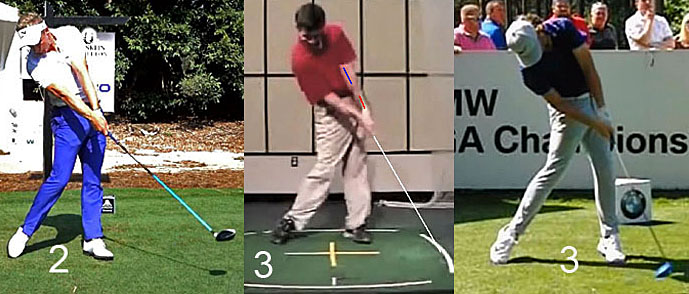
Note that Tyler Ferrell and Tommy Fleetwood are DHers (drive-holders) and note that they have identical DH-hand release elements at the ~P7.3 position. Note that Tyler Ferrell and Tommy Fleetwood both do not allow their clubshaft to bypass their left arm (from an angular rotational perspective) and that their clubface is square to the clubhead arc - while Luke Donald's clubshaft has bypassed his left arm (from an angular rotational perspective) due to an uninterrupted left forearm supination phenomenon happening through impact and his clubface is therefore more closed to his clubhead arc. Note that Tyler Ferrell and Tommy Fleetwood both have a slightly bent right elbow and a slightly bent right wrist and their right palm is more behind their club handle - while Luke Donald has prematurely "run-out-of-right arm" and his right elbow and right wrist have fully straightened while he has also pronated his right forearm more so that the back of his right hand faces the camera. Note that Tyler Ferrell and Tommy Fleetwood both externally rotate their left humerus between P7 and P7.3 - while Luke Donald still has an internally rotated left humerus at P7.4. Externally rotating the left humerus between P7 and P7.2 (or even further to P7.4) at a rotational speed that keeps the LAFW intact and that keeps the clubface square to the clubhead arc is a key element that characterises a DHer who uses the delayed full-roll subtype of DH-hand release action (like Tyler Ferrell and Tommy Fleetwood).
DHers, who use the delayed full-roll subtype of DH-hand release action, vary in their timing as to when they transition to a finish swivel action. So, for example, Dustin Johnson (who is a DHer) sometimes transitions to a finish swivel action soon after P7.4 while sometimes he gets to P7.8 before he overtly transitions to a finish swivel action. With that thought in mind, consider this image from Tyler Ferrell's "Stock Tour Swing" book.
Copy of an image from page 204 of Tyler Ferrell's "Stock Tour Swing" book.
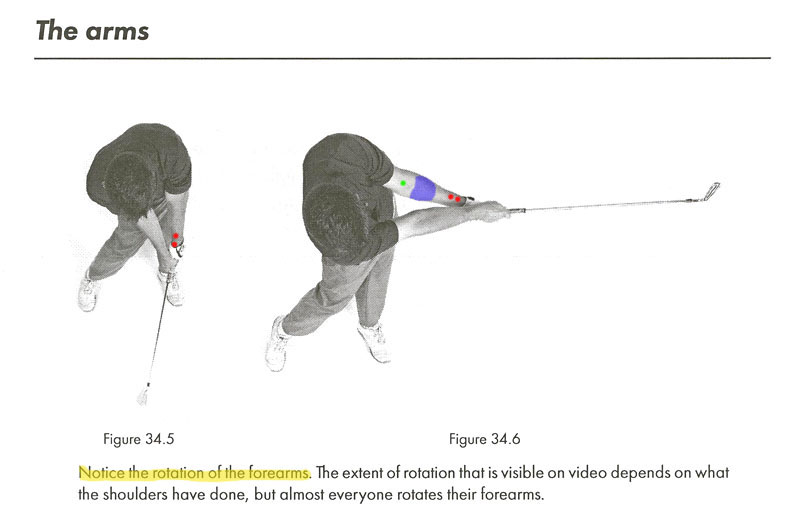
Figure 34.5 represents the impact position (P7 position), while figure 34.6
represents the P8 position (when the clubshaft is parallel to the ground).
Note that I have placed a green dot in the middle of his left antecubital fossa, and two red dots in a straight line over his left lower radial bone just above the level of his left wrist crease.
Note that the ventral aspect (frontal aspect) of his upper left forearm is not clearly visible in figure 34.5 because it is facing away from the target, but it is clearly visible in figure 34.6 and I have colored that ventral aspect of his left upper forearm area in blue - and the difference in rotational orientation of the ventral aspect of his left upper forearm between P7 and P8 means that the upper left forearm has rotated a lot counterclockwise between P7 and P8. What has caused that marked degree of counterclockwise rotation of his left upper forearm between P7 and P8? Note that I have yellow-highlighted Tyler Ferrell's statement where he states -: "Notice the rotation of the forearms". However, if you look carefully at that image, you will note that Tyler Ferrell's claim that there is "rotation of the forearms" (which is the phenomenon of left forearm supination and right forearm pronation) only applies to the right forearm (which is much more pronated at P8 than it was at P7). Note that the red dots are not significantly rotating more counterclockwise relative to the green dot between P7 and P8, which means that there is very little left forearm supination happening between P7 and P8, and secondary proof of that fact is that the back of his left hand is near-vertical at P8 and it is not facing groundwards. Also, you need to remember that left forearm supination changes the rotational alignment of the lower 4" of the left forearm + the rotational alignment of the back of the left wrist/hand relative to the rotational alignment of the left antecubital fossa (and upper left forearm) and any left forearm supination could not possibly account for the fact that the upper left forearm has rotated counterclockwise so much between P7 and P8. The "true cause" of the marked degree of counterclockwise rotation of Tyler Ferrell's left upper forearm is the fact that he has markedly rotated his left humerus counterclockwise between P7 and P8, and that the significant degree of opening of his upper torso makes it biomechanically much easier for him to externally rotate the left humerus to such a marked degree. Secondary proof that external rotation of the left humerus is causing the clubshaft's rotation between P7 and P8 is the fact that the clubshaft has not bypassed his left arm (from an angular rotational perspective) at P8 and the fact that the toe of the clubhead is facing skywards. If Tyler Ferrell had a lot of left forearm supination happening between P7 and P8 (to such a degree that he "maxes-out" his left forearm supination), then the clubshaft would have bypassed his left arm (from an angular rotational perspective) by P8 and his clubface would be rotated closed well beyond vertical and it would be facing groundwards. What Tyler Ferrell is really demonstrating in this image is a DH-hand release action - and not a rolling subtype of non-DH hand release action that is due to a significant amount of left forearm supination.
Consider what Tyler Ferrell claims in his video called "Should You Supinate in the Golf Swing Release", which is available at https://www.youtube.com/watch?v=mG5vqemOzyg&t=724s. He stated that a golfer should "max-out" his left forearm by 90 degrees in his followthrough action and that he should not limit it to 30-40 degrees. He stated that many amateur golfers limit their left forearm supination during their early followthrough and that it predisposes to left wrist flipping.
Here is a capture image from Tyler Ferrell's video showing an amateur golfer flipping post-impact.
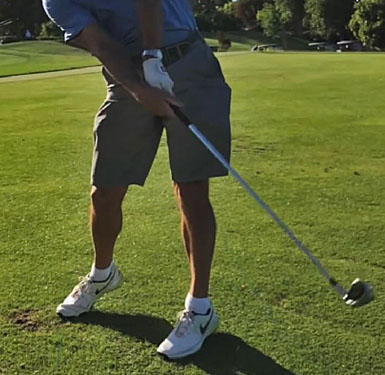
Note that the amateur golfer is flipping (extending/bending his left wrist) through impact and that causes the clubshaft to bypass his left arm (from an angular rotational perspective) and it also causes the clubface to close a lot relative to the ball-target line. What is Tyler Ferrell's golf instructional recommendation for that golfer? In his video Tyler Ferrell recommends "left forearm supination" training drills.
Mike Malaska is a great proponent of "left forearm supination" drills in his video called "L to L Drill - the Most Important Golf Lesson You Need to Know", which is available at https://www.youtube.com/watch?v=UAIdIdWoe9g&t=127 . Here is another golf instructor, Christina Ricci, promoting a "left forearm supination" drill in her video called "Lighting Hands for More Solid Contact & More Distance", which is available at https://www.youtube.com/watch?time_continue=1&v=J_IkoI2LfMg .
Here are capture images from Christina Ricci's video where she demonstrates her "left forearm supination" drill.
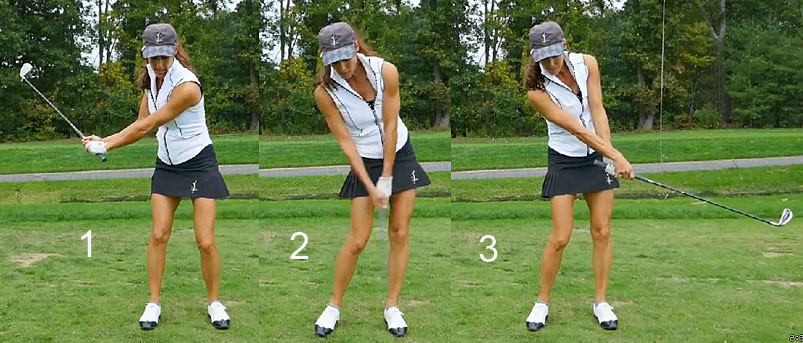
Image 1 is at ~P5.5, image 2 is at impact and image 3 is at ~P7.75
Note that Christina Ricci has to supinate her left forearm a lot between P5.5 and impact in order to get a square clubface by impact, and I readily agree that it is necessary. However, note that she continuously supinates her left forearm in an uninterrupted manner through impact so that she "maxes-out" her left forearm supination by P7.8. Note that her clubshaft has bypassed her stalled left arm (from an angular rotational perspective) and that causes her clubface to close a lot post-impact.
I completely disagree with the idea that a student golfer must solve the swing fault of a stalling left arm and a left wrist flipping phenomenon post-impact (as seen in that amateur golfer who exhibits a left wrist flipping subtype of non-DH-hand release action) with another undesirable type of non-DH hand release action (rolling subtype due to excessive left forearm supination) - because they both produce a high ROC of the clubface through the immediate impact zone between P7 and P7.2+. I think that the better solution is to encourage the student golfer to use a DH-hand release action (like Tyler Ferrell, Tommy Fleetwood and Kelli Oride) where they i) do not stall their left arm's targetwards motion between P7 and P7.2 as they continuously abduct their left arm at an optimal speed that allows them to ii) prevent the clubshaft from bypassing their abducting left arm (from an angular rotational perspective) by ensuring that they match the angular velocity of their abducting left arm to the angular velocity of their clubshaft and iii) where they also keep the clubface continuously square to the clubhead arc by optimally controlling the rotational speed of external rotation of their abducting left humerus so that they can thereby produce the lowest possible ROC of their clubface through the immediate impact zone.
I have watched many swing videos of Tyler Ferrell's
golf swing action and I think that he has a PGA-tour quality golf swing
action (like Tommy Fleetwood) - and they both use a DH-hand release
action, and not a non-DH hand release action (rolling
subtype), between impact and P7.3+. I personally think that Tyler Ferrell
should improve his understanding of the biomechanics of a DH-hand release
action, so that he can better teach his student golfers how best to emulate
his superb DH-hand release action that he personally manifests in his "real
life" golf swing action.
Topic number 3: Clubshaft shallowing during the early-mid downswing.
There are two relevant questions with respect to the topic of clubshaft
shallowing during the early-mid downswing - i) why should a golfer shallow the
clubshaft during the early-mid downswing and ii) how should it be performed from
a biomechanical perspective.
In a video called "Connecting Sasho Arm Shallowing To Supination" (which is available at https://www.youtube.com/watch?v=3pHjRfAyj6g ) Tyler Ferrell states that a golfer should shallow the clubshaft during the early-mid downswing so that it will enable him to supinate his left arm earlier and with more force. However, one cannot supinate the left forearm earlier in the downswing (before P5.5) if one uses the intact LAFW technique where the clubshaft is "on-plane" because it will induce a "tumble action", which is a clubshaft steepening action that will "tumble" the clubshaft over-the-plane. So, we primarily need to address Tyler Ferrell's 2nd claim that clubshaft shallowing during the earlier downswing (between P4 and P5.5) will allow a golfer to perform the left forearm supinatory motion that happens in the later downswing (after P5.5) with more "force". Tyler Ferrell implies in that video that clubshaft shallowing will not be necessary if a golfer doesn't need to supinate the left forearm during the later downswing and early followthrough due to the use of what Tyler Ferrell calls a "hold-off" release in his video. Tyler Ferrell correctly implies that a golfer, who uses a neutral left hand grip, will not have to use a left forearm supinatory motion in his early followthrough time period between impact and P7.2 if he uses a "hold-off" release action (which I prefer to more accurately label a DH-hand release action). However, he will still have to use a left forearm supinatory action in his later downswing between P5.5 and impact in order to get his square clubface by impact - as comprehensively explained in my topic number 1 discussion. I only know of one reason why a golfer will not need to perform a significant amount of left forearm supinatory motion in his later downswing between P5.5 and impact and that is because he uses a very strong (4+ knuckle) left hand grip. When a golfer adopts a very strong left hand grip, then he will have to use very little PA#3 release action (which is biomechanically due to left forearm supination) in his late downswing in order to acquire a square clubface by impact.
Consider an example of a golfer who adopts a very strong (4-knuckle) left hand grip - Jamie Sadlowski.
Here are capture images from a face-on swing video of
Jamie Sadlowski's golf swing action (
https://www.youtube.com/watch?v=ep-qidwgCII ).

Image 1 is at the P6 position, image 2 is at the P6.2 position, image 3 is
at the P6.7 position and image 4 is at impact.
Note that the back of Jamie Sadlowski's left hand is facing the camera, and also the ball-target line, at the P6 position and that the ulnar border of his left hand is facing the target. Note that his clubface is tilted forward beyond vertical and that it is about 60+ degrees closed relative to the back of his left hand and watchface area of his left lower forearm. That marked degree of clubface closure (relative to the back of his left hand and watchface area of his left lower forearm) is due to the fact that he adopted a very strong left hand grip at address - where he markedly pronated his left forearm before gripping the club handle. Most importantly, it is important to appreciate the "fact" that his clubface is closed to the same degree (relative to the back of his left hand and watchface area of his left lower forearm) at P6 than it was at address.
Note that the back of his left hand, and the watchface area of his left lower forearm, is still facing the camera, and also the ball-target line, at P6.2, P6.7 and P7 and that the ulnar border of his left hand is continuously facing the target. In other words, there is no visual evidence that there is any significant degree of counterclockwise rotation of the left hand (due to left forearm supination) happening between P6 and impact.
So, if a significant amount of left forearm supination is not required in Jamie Sadlowski's late downswing action, does that mean that he does not have to use a clubshaft-shallowing action during his early-mid downswing action between P4 and P6 (as Tyler Ferrell implies)?
Consider DTL capture images of Jamie Sadlowski's downswing action.
Jamie Sadlowski's early-mid downswing

The red splined path represents his downswing's hand arc path and it tracks roughly down the TSP (turned shoulder plane).
Note that Jamie Sadlowski's clubshaft also tracks down the TSP and he doesn't shallow the clubshaft during his early-mid downswing. Note that his clubshaft is on the TSP plane at impact.
So, it would seem at first glance that Tyler Ferrell may be correct to imply that Jamie Sadlowski does not have to use a clubshaft-shallowing phenomenon in his early-mid downswing (between P4 and P5.5) because he does not need to use a significant amount of left forearm supination in his late downswing (between P5.5 and impact).
However, I believe that Jamie Sadlowski does not use a clubshaft-shallowing action during his early-mid downswing between P4 and P5.5 for a reason other than the fact that he does not have to use a significant amount of left forearm supination in his later downswing after P5.5.
Before I explain the likely reason, let's consider another professional golfer who also adopts a very strong left hand grip at address - Hunter Mahan.
Here are capture images from a face-on swing video of Hunter Mahan's golf swing action.
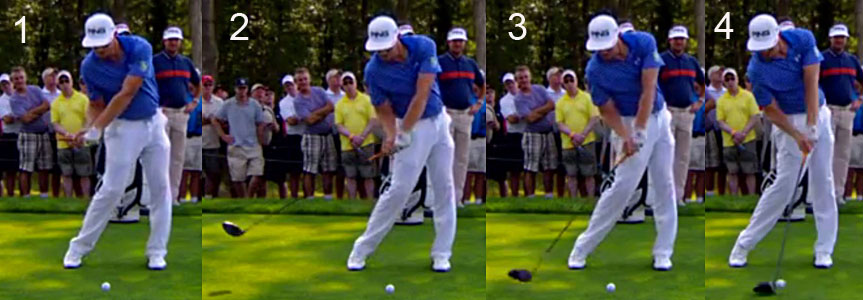
Image 1 is at P6, image 2 is at P6.3, image 3 is at P6.7 and image 4 is at
impact.
Note that the back of Hunter Mahan's left hand, and the watchface area of his left lower forearm, is facing the camera and ball-target line to roughly the same degree throughout his late downswing between P6 and impact and that he comes into impact with the ulnar border of his left hand facing the target - as seen in Jamie Sadlowski's later downswing action. Those capture images suggest that Hunter Mahan (like Jamie Sadlowski) is using an insignificant amount of left forearm supination in his later downswing. Does that mean that Hunter Mahan will not be shallowing his clubshaft during his early-mid downswing between P4 and P5.5?
Consider these DTL capture images of Hunter Mahan's early-mid downswing action.

Image 1 is at address, image 2 is at his end-backswing (P4) position, image
3 is at his P5 position, image 4 is at his P5.5 position and image 5 is at
impact.
I have drawn a red line along his clubshaft at address, and that represents the hand plane. Note that Hunter Mahan stands with his left arm near-vertical at address, and that an extension of the red line points at his body just below his belt buckle. I have drawn a blue line between the ball and his right elbow at address and that represents the elbow plane. I have drawn a yellow line between the ball and his right shoulder socket (when it is at the P4 position) and that presents the turned shoulder plane (TSP). I have drawn a curved green line (using my swing analyser's multispline tool) to show his hand arc path during his early-mid downswing action.
Note that Hunter Mahan's clubshaft is positioned just below the TSP at his P4 position.
Image 3 shows how Hunter Mahan shallows his clubshaft below his hand arc path during his early downswing so that it is already shallowed down to the elbow plane by the end of his early downswing at the P5 position.
Image 4 shows that Hunter Mahan continues to shallow his clubshaft between P5 and P5.5 and that his clubshaft is just below his elbow plane at P5.5. Note that he doesn't shallow his clubshaft more between P5.5 and impact and that his clubshaft is still just below his elbow plane at impact.
So, why does Hunter Mahan shallow his clubshaft to such a significant degree during his early-mid downswing between P4 and P5.5 - if he doesn't need to perform a significant amount of left forearm supination between P5.5 and impact in order to get his clubface square by impact?
I think that the correct "reason" becomes apparent when looking at these comparative images of Jamie Sadlowski and Hunter Mahan.

Image 1 shows Jamie Sadlowski at address, and image 2 shows him at impact. Image 3 shows Hunter Mahan at address, and image 4 shows him at impact.
I have drawn a red line down the length of their left arm at address, and a blue line down the length of their left arm at impact. Note that Jamie Sadlowski's left arm is much more outstretched away from his body at impact - compared to address where it is near-vertical. Note that Hunter Hahan's left arm is still near-vertical at impact and there is very little outstretching of his left arm at impact.
I have drawn a faint yellow arc between their left arm and their clubshaft at impact to represent the angle between the front of their left arm and the clubshaft and that angle is called the accumulator #3 angle in TGM terminology. The magnitude of the accumulator #3 angle at impact is defined as "180 degrees minus that accumulator #3 angle" and it is exactly equivalent to the angle between the clubshaft and the blue line at impact. In Jamie Sadlowski's image 2 the accumulator #3 angle measures 18 degrees, while Hunter Mahan's accumulator #3 angle measures 35 degrees in image 4.
In other words, Jamie Sadlowski has a much smaller accumulator #3 angle at impact (because he comes into impact with his left arm outstretched away from his body) while Hunter Mahan has a much larger accumulator #3 angle at impact (because he comes into impact with his left arm near-vertical and it is not outstretched away from his body). I believe that there is a close correlation between a professional golfer's accumulator #3 angle at impact and whether he shallows the clubshaft during his early-mid downswing action. Professional golfers who come into impact with an outstretched left arm where the accumulator #3 angle is small will likely not shallow their clubshaft much during their early-mid downswing between P4 and P5.5, while golfers who come into impact with their left arm near-vertical and with a large accumulator #3 angle will likely have to shallow their clubshaft much more between P4 and P5.5 in order to make it biomechanically possible. Does my observation also apply to golfers who use a weak-or-neutral left hand grip?
Many professional golfers use a neutral, or weak, left hand grip, and they do not use a very strong left hand grip, and they therefore have to use a PA#3 release action in their later downswing, which is primarily based on the biomechanical phenomenon of left forearm supination, in order to square their clubface by impact. Tyler Ferrell seems to believe that those golfers therefore have to shallow their clubshaft in their early downswing - based on his understanding of the "ideas" of Sasho MacKenzie, who is a golf biomechanist based in Nova Scotia, Canada - in order to either decrease the amount of active left forearm supinatory torque "force" that will be needed during their PA#3 release action, or to increase the total amount of left forearm supinatory "force" that can be applied during their later downswing.
Here is a link to a you-tube video where Sasho MacKenzie explains why he believes that a golfer should shallow his clubshaft during the early-mid downswing - https://www.youtube.com/watch?v=iuJaSM7Kexw .
Here is a capture image from an article that diagramatically explains Sasho MacKenzie's reasoning.
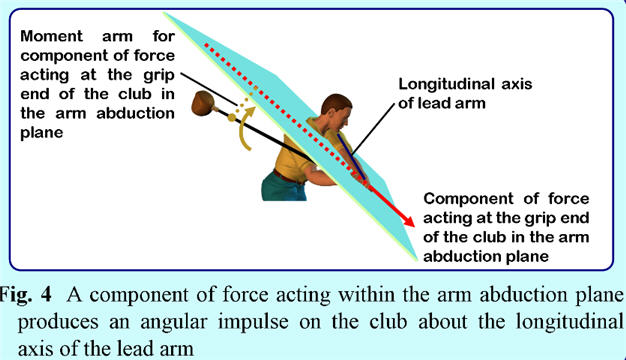
During the early downswing, the left hand is moving down the inclined plane along a path, which is called the hand arc path. The directional shape of the hand arc path between P4 and P6 (from a DTL viewing perspective) is determined by the degree of left arm abduction versus the degree of left arm depression happening per unit time of hand travel. If the golfer deliberately shallows the clubshaft during that same time period it will move the center-of-gravity (COG) of the clubshaft under the plane of the abducting left arm's hand arc path. As the left hand continues to move down the hand arc path between P4 and P6, a "force" is automatically/naturally created that will act to rotate the clubshaft in a counterclockwise direction so that the clubshaft can get back into alignment with the abducting left arm. The magnitude of that "force" depends on the size of the moment arm (as demonstrated in that diagram) and it happens passively according to the laws of physics. In other words, if a professional golfer shallows his clubshaft relative to his hand arc path during his early-mid downswing, then that professional golfer will have to use less active left forearm supinatory muscular force during his PA#3 release action - because the "passive force" will be naturally supplying a significant amount of the energy required to rotate the clubshaft in a counterclockwise (left forearm supinatory) direction. I certainly do not disagree with Sasho MacKenzie's opinion that this "passive force" is operant if a golfer shallows the clubshaft during the P4 => P6 time period, but I do not think that it is the main reason why some professional golfers (who use a neutral left hand grip) choose to shallow their clubshaft during the early-mid downswing time period. To explore this issue further, let's consider two professional golfers who use a neutral left hand grip, but where the one professional golfer (Sergio Garcia) shallows his clubshaft during his P4 => P6 time period while the other professional golfer (Phil Mickelson) does not shallow his clubshaft during his P4 => P6 time period.
Here are DTL capture images of Sergio Garcia's early-mid downswing's clubshaft-shallowing action.

Image 1 is address, image 2 is at his end-backswing (P4) position, image 3
is at approximately the P5.2 position and image 4 is at impact.
I have drawn a red line along Sergio Garcia's clubshaft at address, and that line represents his hand plane. I have drawn a blue line between the ball and his right elbow at address and that line represents his elbow plane. I have drawn a yellow line between the ball and his right shoulder socket when he is at his end-backswing position, and that line represents the turned shoulder plane (TSP).
Note that Sergio has a near-vertical left upper arm at address (image 1) and that an extension of the hand plane line drawn out from the butt end of the club points at his belt buckle.
Note that Sergio Garcia has his left hand and clubshaft just below the TSP at his P4 position (image 2).
Note how much Sergio Garcia shallows his clubshaft between P4 and P5.5 - by noting that his clubshaft has already shallowed down to the hand plane by P5.2 (image 3).
Note that Sergio Garcia's clubshaft is sill on the hand plane at impact (image 4). Note that his left arm is more vertical at impact and that he his hands are closer to his body - compared to his address position scenario.
Here is another capture image showing how much Sergio
Garcia shallows his clubshaft relative to his hand arc path
during his early-mid downswing.
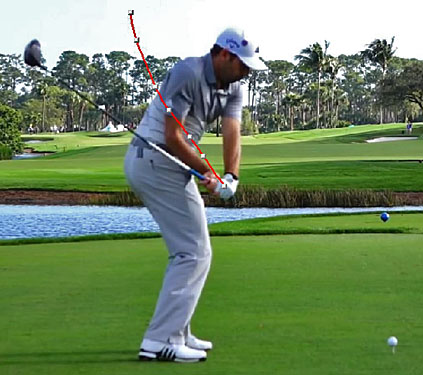
I have traced Sergio Garcia's hand arc path in red. Note that his hand arc
path is very steep initially during his early downswing and that it is
slightly less steep during his mid-downswing time period.
In this capture image, Sergio Garcia is at the P5.5 position. Note how much he has shallowed his clubshaft relative to his hand arc path between P4 and P5.5.
Now, let's consider Phil Mickelson's clubshaft-shallowing action during his early-mid downswing.
Here are DTL capture images of Phil Mickelson's clubshaft-shallowing action during his early-mid downswing.

Image 1 is address, image 2 is at his end-backswing (P4) position, image 3
is at his P5 position, image 4 is at his P5.5 position and image 5 is
impact.
I have drawn a red line along Phil Mickelson's clubshaft at address, and that represents his hand plane. I have drawn a blue line between the ball and his rear elbow at address and that line represents his elbow plane. I have drawn a yellow line between the ball and his rear shoulder socket when he is at his end-backswing position, and that line represents the turned shoulder plane (TSP). Note that there is very little difference in the degree of steepness of his elbow plane relative to his TSP.
Note that his lead arm is near-vertical at address and that an extension of the hand plane line drawn out from the butt end of the club points at his belt buckle.
Note that Phil Mickelson's lead hand and clubshaft are on the TSP at his end-backswing position (image 2).
Note that Phil Mickelson only shallows his clubshaft by a very small (and negligible) amount between P4 and P5 (image 3) as his clubshaft shallows down to the blue line which is not significantly shallower than the yellow line.
Note that his clubshaft is still on the blue elbow plane line at P5.5 (image 4) and at impact (image 5). Note that Phil Mickelson basically does not shallow his clubshaft during his downswing action - note that his clubshaft is minimally shallower than the yellow TSP line at impact. Note how outstretched his lead arm is impact and how his clubshaft is nearly straight-line-aligned with his lead arm at impact because he has a small accumulator #3 angle.
Here is another capture image showing how little Phil Mickelson shallows his clubshaft relative to his hand arc path during his early-mid downswing.
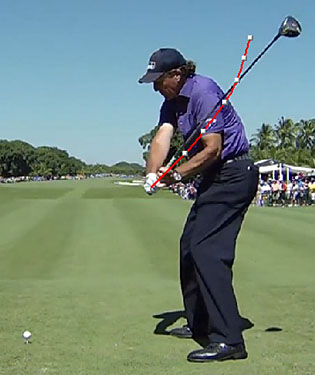
I have traced Phil Mickelson's hand arc path in red. In this image, where
Phil Mickelson is at the P5.5 position. note that he has not
shallowed his clubshaft at all relative to his hand arc path.
Why does Sergio Garcia shallow his clubshaft to such a marked degree during his early-mid downswing time period - while Phil Mickelson does not significantly shallow his clubshaft at all during that same early-mid downswing time period?
I don't think that either Sergio Garcia or Phil Mickelson consciously thought about the value of clubshaft-shallowing on the amount of "force" needed to supinate their lead forearm during their late downswing when they first developed their distinctive, and contrasting, driver swing styles. I simply think that Sergio Garcia evolved a driver swing style that resulted in him coming into impact with his lead arm near-vertical and with a large accummulator #3 angle, while Phil Mickelson evolved a driver swing style where he comes into impact with his lead arm outstretched and with a small accumulator #3 angle.
Consider a comparison between Phil Mickelson and Sergio Garcia at impact.
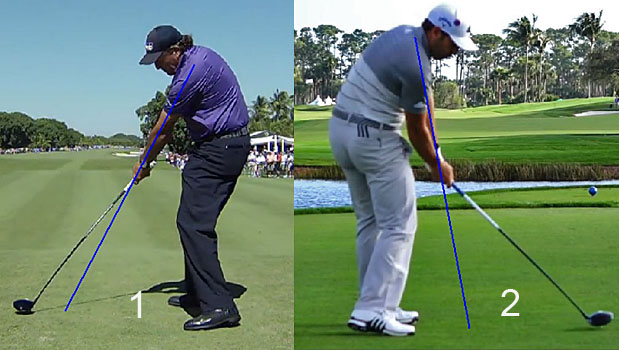
Image 1 shows Phil Mickelson at impact and image 2 shows Sergio Garcia at
impact.
I have drawn a blue line down the length of their lead arm. Note that the blue line intersects the ground far away from Phil Mickelson's feet because his lead arm is outstretched away from his body at impact, while the blue line in Sergio Garcia's impact image intersects the ground closer to his feet because his lead arm is much more vertical at impact.
Note that Phil Mickelson has a small accumulator angle of 10 degrees, while Sergio Garcia has a large accumulator #3 angle of 35 degrees, at impact.
I believe that it is biomechanically natural for Phil Mickelson to not shallow his clubshaft during his early-mid downswing if he has evolved a driver swing style where he comes into impact with an outstretched lead arm and a small accumulator #3 angle of 10 degrees, and where his clubshaft's steepness at impact is close to the TSP - while it makes *perfect biomechanical sense that Sergio Garcia needs to markedly shallow his clubshaft during his early-mid downswing if he has evolved a driver swing style where he comes into impact with a near-vertical lead arm and a large accumulator #3 angle of 35 degrees, and where his clubshaft lies on the shallower hand plane at impact.
(* the biomechanical concept of matching the degree of clubshaft-shallowing during the early-mid downswing to the magnitude of one's accumulator #3 angle at impact in order to allow for a smoothly efficient left arm/wrist/hand motion as one's left hand "turns-the-corner" between P5.5 and P6.5 is primarily applicable to golfers who use an intact LFFW swing technique and it is not necessarily applicable to golfers who disrupt their intact LFFW by bowing their left wrist in such a way that it angles the clubshaft below the plane during their early-mid downswing)
Now, let's consider what effect their different clubshaft-shallowing swing styles (that happen during their early-mid downswing) have with respect to the biomechanics/mechanics of their PA#3 release action that they are both obliged to perform in their late downswing - because they have both adopted a neutral left hand grip.
As I have previously stated, all professional golfers who adopt a neutral left hand grip will have to supinate their left forearm during their late downswing's PA#3 release action in order to get their clubface square by impact. However, the timing and speed of left forearm supination can vary considerably - depending on whether the professional golfer shallows, or does not shallow, his clubshaft significantly during his early-downswing action.
Let's first consider Phil Mickelson's PA#3 release action that happens during his late downswing.
Here are DTL capture images of Phil Mickelson's late downswing action.

Image 1 is just bypassed the P6 position. Note that his clubface is still
open to the clubhead arc and that the toe of his clubhead is pointing up
(skywards) and that it is also tilted slightly backwards away from the
ball-target line. Note that the clubface is parallel to the back of his lead
hand and watchface area of his lead lower forearm because he has maintained
an intact LFFW. Note that the back of his lead hand, and watchface area of
his lead lower forearm, is parallel to the inclined plane, which has a
degree of steepness roughly equivalent to the steepness of the TSP because
he did not shallow his clubshaft during his early-mid downswing.
Image 2 is at the P6.7 position. Note that the clubface is still wide open relative to the ball-target line and also relative to the clubhead arc. Note that the back of his lead hand, and watchface area of his lead lower forearm, is still roughly parallel to the inclined plane, which has roughly the same degree of steepness as the TSP because he is not shallowing his clubshaft between P6 and P6.7. Note that there is no evidence that Phil Mickelson is significantly supinating his lead forearm between P6 and P6.7. Note that he has significantly uncocked his lead wrist and thereby released PA#2 (in the plane of his intact LAFW) between P6 and P6.7 and that the clubshaft has nearly caught up to his lead arm by P6.7.
Image 3 is at impact, where he has squared his clubface by supinating his lead forearm by the amount needed to acquire a square clubface by impact. In other words, Phil Mickelson delays his PA#3 release action and he only significantly supinates his lead forearm between P6.7 and impact. If virtually all of his lead forearm supinatory motion happens in that short pre-impact time period between P6.7 and impact, that means that the amount of clubface roll per unit degree of clubhead travel is very large as his clubhead travels along the last 18" of his clubhead travel path just before impact. That large amount of ROC (rate-of-closure) of his clubface in the last 18" of clubhead travel along the clubhead arc (just before impact) is potentially a great disadvantage because it makes it much more difficult for him to time his clubface roll so that the clubface can be guaranteed to be square at impact. What aggravates the timing of his clubface-squaring phenomenon is the fact that Phil Mickelson needs to use an active muscular force to perform his PA#3 release action's left forearm supinatory motion. Why can Phil Mickelson not use passive forces to square his clubface by impact? First of all, Phil Mickelson cannot use the passive "torque force" (described by Sasho MacKenzie) because he does not shallow his clubshaft during his early-mid downswing. Secondly, he cannot use the passive RYKE phenomenon (described by Kevin Ryan) because he has too small an accumulator #3 angle between P6.7 and impact. So, he is dependent on using an active muscle force derived from an active muscular contraction of his lead forearm's supinator muscles (+/- his rear forearm's pronator muscles if they are used synergistically to assist in the clubface-squaring phenomenon). The amount of active muscular force is very small because the *moment-of-inertia is very small - and that is because the clubshaft has nearly caught up to his straight lead forearm by P6.7.
(* see the 15:10 minute time point of the Sasho MacKenzie and Chris Como video at https://www.youtube.com/watch?v=iuJaSM7Kexw if you want to better understand the moment-of-inertia issue)
Although Phil Mickelson may not require a large amount of lead forearm supinatory muscular force during his PA#3 release action between P6.7 and impact (because the moment-of-inertia is small), he still has to regulate that "muscular force" during a very short time period immediately pre-impact so that it does not continue to remain active post-impact (which will predispose to a roller hand release action immediately post-impact between P7 and P7.2). That requisite "turn-on" and then immediately "turn-off" phenomenon as it applies to his lead forearm's supinatory muscular force is obviously very difficult to achieve, and to also consistently time! Secondly, if he simultaneously "runs-out-of-right arm" then he cannot fruitfully use a controlled rear forearm pronatory motion during his rear arm's straightening action to synergistically assist him in smoothly, and controllably, performing his PA#3 release action. Phil Mickelson often "runs-out-of-right arm" during his later downswing's immediate pre-impact time period - as "evidenced" by noting that his rear palm often loses close physical contact with PP#1 that is located over the base of his lead thumb between P6.8 and impact, or sometimes only just through impact.
Now, let's consider Sergio Garcia's PA#3 release action.
Here are capture images of Sergio Garcia's late downswing action.

Image 1 is at the P5.5 position. Note that Sergio Garcia has already shallowed his clubshaft down to his desired impact plane - the hand plane.
Note that his clubface is wide open relative to his clubhead arc - but that his clubface is straight-line-aligned relative to the back of his left hand, and the watchface area of his left lower forearm, because he has an intact LFFW.
Image 2 is at the P6 position. Note that the back of his left hand, and watchface area of his left lower forearm, is more vertically oriented and that means that he has rotated his left forearm counterclockwise by a significant amount between P5.5 and P6. What makes it biomechanically easier for him to rotate his intact LFFW so much counterclockwise between P5.5 and P6, when he still has a large moment-of-inertia (due to the fact that he still has large amount of clubhead lag present), is the "fact" that he can utilise the passive torque force (described by Sasho MacKenzie) that is secondary to the fact that his clubshaft's plane of motion is below his hand arc path's plane of motion. Note how much he has squared his clubface relative to his clubhead arc by P6 due to his early left forearm supination phenomenon.
Image 3 is at P6.5. Note that he is continuously, and progressively, supinating his left forearm between P6 and P6.5, and that his clubface is becoming progressively more square to his clubhead arc. Look at his clubhead path between P5.5 and P6.5 and note that his clubhead moves *under his hands at about P6 as the clubhead moves from being behind his hands at P5.5 to being in front of his hands at P6.5.
(* By contrast, Mike Malaska recommends that the clubhead should move over the hands in his "Malaska Move" maneuver - see these capture images of Mike Malaska demonstrating his "Malaska Move" maneuver)
Image 4 is at impact where he presumably has a square clubface.
During the P6 => P7 time period, his clubshaft is
tracing a conical pendular path and it is probably under the beneficial
influence of the passive RYKE effect phenomenon because
he has a large accumulator #3 angle (which is exactly equivalent in
magnitude to the RYKE angle). That means that he doesn't have to use much
left forearm supinatory muscular force during his PA#3 release action -
because so many beneficial passive clubface-squaring forces
are operant. Most importantly, note that the amount of clubface roll
happening per unit amount of clubhead travel during his late downswing
between P6.7 and impact is very small because his clubface rolling
action (due to left forearm supination) happens very gradually, and very
steadily, over a much longer time period of clubhead travel between P5.5 and
impact - and that is potentially of great benefit to Sergio Garcia when it
comes to consistently timing his late downswing's clubface-squaring action
(compared to Phil Mickelson's delayed clubface-squaring action that happens
very fast between P6.7 and impact).
I have used Sergio Garcia and Phil Mickelson as extreme examples of contrasting clubshaft-shallowing styles when it comes to professional golfers who use a neutral left hand grip, but most PGA tour golfers (who use a neutral left hand grip) manifest an intermediate degree of clubshaft-shallowing action during their early-mid downswing because they come into impact with a moderate-sized accumulator #3 angle.
Consider three examples - Adam Scott (image 1), Justin Rose (image 2) and Rory McIlroy (image 3).
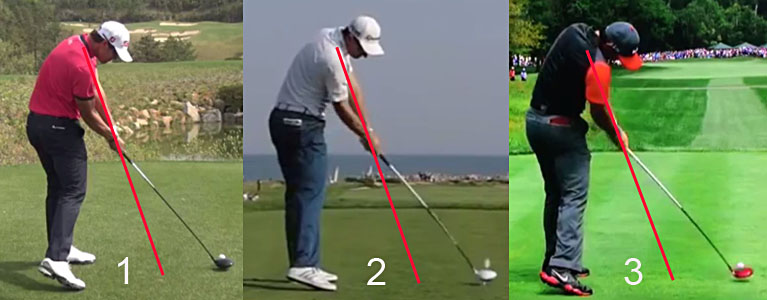
I have drawn a red line down the length of their left arm, and the angle
between that red line and their clubshaft demonstrates that they have a
moderate-sized accumulator #3 angle at impact. Note that their left arm is
also less vertically-oriented at impact when compared to Sergio Garcia, but
note that they do not outstretch their left arm far away from their body at
impact like Phil Mickelson.
Here are capture images showing that they shallow their clubshaft (relative to their hand arc path) to a moderate degree during their early-mid downswing action.
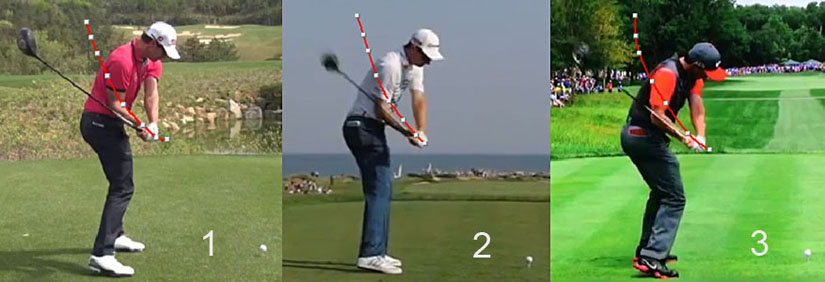
The red splined path arc represents their hand arc path. Note that all three
golfers shallow their clubshaft by a moderate amount during their early-mid
downswing, and that the amount correlates directly with the size of their
accumulator #3 angle at impact. Note that their right palm is under
the club handle at their P5.5 position and that it is parallel to their
shallowed inclined plane.
The next question that arises is how does a professional golfer biomechanically shallow the clubshaft during the early-mid downswing? In other words, what advice can a golf instructor provide to a student golfer on how best to biomechanically perform a clubshaft-shallowing action during the early-mid downswing?
Tyler Ferrell discusses this issue in his video called "Major Movements That Shallow the Clubshaft During the Transition" which is available at his golfsmartacademy.com website. He mainly talks about how a golfer needs to externally rotate the right humerus and pronate the left forearm. It is true that a golfer needs to perform those two biomechanical actions in order to execute a clubshaft-shallowing action, but how does that limited amount of advice help a student golfer better envisage how to optimally execute the biomechanics of a clubshaft-shallowing maneuver?
I think that there is a better method of describing the core biomechanical motions that are needed in order for a golfer to efficiently shallow the clubshaft during the early-mid downswing. I believe that the core clubshaft-shallowing motion is induced by the golfer performing an active right arm adduction move at the start of the downswing that is combined with a right elbow pitch motion. During that right arm adduction motion the right elbow must lead the hands so that the golfer performs a right elbow pitch motion. The right humerus must externally rotate as the right humerus adducts, and the right forearm must also supinate to ensure that the right palm remains continuously parallel to the progressively shallowing inclined plane (swingplane). The amount of right forearm supination required will be directly proportional to the amount of clubshaft shallowing happening during the P4 => P5.5 time period. If the degree of clubshaft-shallowing is moderate, then the "feel" of the right elbow pitch motion will "feel" more like a side-arm throwing motion using the right arm, while it will "feel" more like an underhand throwing motion (stone-skipping throwing motion) if the degree of clubshaft-shallowing is greater.
Consider Ben Hogan's clubshaft-shallowing action.

The left arm is colored in yellow and if the clubshaft is straight-in-line with the left forearm, then it represents an intact LFFW. Note how Hogan shallows his LFFW during his early-mid downswing action. Note that the clubshaft is positioned just below the TSP at his end-backswing position (image 1) and that Hogan shallows the clubshaft down to the hand plane by P5.5 (image 5).
Note that his right palm is continuously parallel to the undersurface of his inclined plane as his GFLW/clubshaft descends down a progressively shallowing swingplane (inclined plane). Note that the right palm is more horizontal in image 5 (compared to image 2) and that requires a pitch elbow motion of the adducting right arm during the early-mid downswing where the right humerus externally rotates while the right forearm supinates. Note that the right forearm is significantly supinated at the P5.5 position (image 5) and that the right palm is under the club handle.
Another swing thought that may be useful to a certain subset of student golfers, who are trying to learn the "feel" of a clubshaft-shallowing maneuver, is the mental concept of performing a "horizontal tug and vertical drop" maneuver as described by Moe Norman, and which he apparently learned from reading Paul Bertholy's golf instructional book ( http://jamesowallace.blogspot.com/2011/10/paul-bertholy-moe-norman-connection.html ).
Here is a link - https://www.youtube.com/watch?v=r5LEelOEbQg - to a Craig Shankland-produced video (which Kirk Junge has edited) where Moe Norman demonstrates his "master move", which he calls a "horizontal tug and a vertical drop" move. In his inimitable way, Moe Norman is exaggerating his "master move", which is essentially a clubshaft-shallowing move where he "feels" that the clubshaft is falling in a groundwards direction while he pulls the club handle forwards with his left hand. The "vertical drop" motion needed to cause the clubshaft to shallow-out during the early-mid downswing is secondary to the active right arm adduction maneuver using a right elbow pitch motion.
Here is another you-tube video example - https://www.youtube.com/watch?v=4vufUWKS9hs - that may help a student golfer mentally perceive the biomechanics underlying a "horizontal tug and vertical drop" maneuver (which was originally described by Paul Bertholy). In that you-tube video, Doug Ferreri (who purchased Paul Bertholy's golf estate) demonstrates the "horizontal tug and vertical drop" maneuver.
Here are capture images from the video where Doug Ferreri is demonstrating the "horizontal tug and vertical drop" maneuver in a bunker.
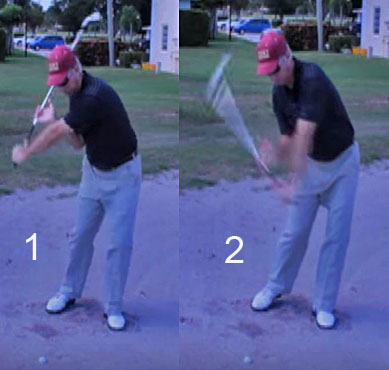
Image 1 shows Doug Ferreri approaching the P5.5 position. Note that he is
pulling the club handle down the inclined plane (swingplane) with his left
hand and that represents the "horizontal tug" component of the "horizontal
tug and vertical drop" maneuver. Note that he is simply supporting the
weight of the shallowing clubshaft with his right palm, which is continuously
parallel to the shallowing swingplane on which the clubshaft descends
between P4 and P6. Note that he needs to keep his right palm
continuously parallel to a shallowing swingplane if the clubshaft
is going to shallow-out during the P4 => P6 time period, and keeping the
right palm continuously parallel to a shallowing plane requires a right arm
adduction move where the "right elbow leads the right hand" secondary to a
pitch elbow motion and where the
right forearm supinates by the exact amount needed to keep the right palm
continuously under the club handle and continuously
parallel to the shallowing swingplane (and that action represents the "vertical
drop" component of the "horizontal tug and vertical drop" maneuver).
Image 2 shows him releasing the club and that represents the release of PA#2
in TGM terminology. Note that his right palm remains under
the club handle while the club releases.
The most dramatic example of a "vertical drop" maneuver can be seen in Sergio Garcia's golf swing action.
Here are capture images from a back-view Sergio Garcia video.
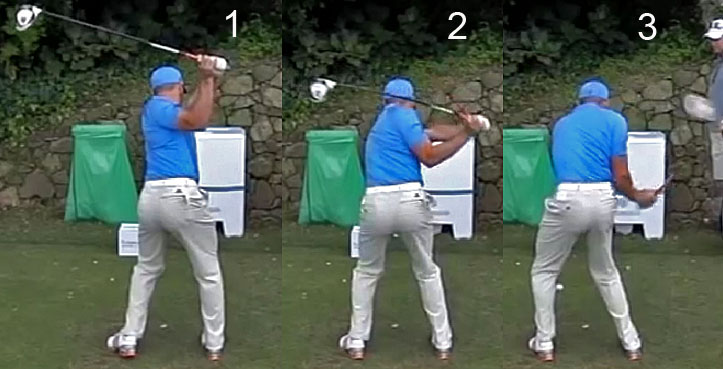
Image 1 is at his end-backswing (P4) position, image 2 is at his P5 position and image 3 is at his P5.5 position.
Note that his right upper arm is abducted slightly away from the right side of his upper torso at his P4 position (image 1). Note how quickly he adducts his right upper arm towards the right side of his upper torso between P4 (image 1) and P5 (image 2) and note how his "right elbow leads his hands". Note how he continues to drive his right elbow downwards between P5 and P5.5 so that his right elbow reaches its pitch position alongside his right hip area by P5.5 (image 3). Note how his clubshaft "falls back" to a shallower plane as a result of his "vertical drop" maneuver. Note that his right forearm is very supinated at the P5.5 position and note that his right palm is under the club handle.
I think that the "vertical drop" maneuver is the exact opposite of the "Malaska Move" maneuver and so, in jest, I sometimes call it the "Anti-Malaska Move" maneuver.
Mike Malaska, a golf instructor based in Scottsdale Arizona, is famous for his "Malaska Move" golf instructional teaching, which he describes in this video produced by Brendon DeVore ( https://www.youtube.com/watch?v=nGAw-wOmgec ). The "Malaska Move" is often referred to as a "clubshaft-tipping" move, or a "clubshaft standing-up" move, or a "clubshaft-steepening" move.
Here are capture images from the Brendon DeVore video, where Mike Malaska demonstrates the biomechanics underlying his "Malaska Move".
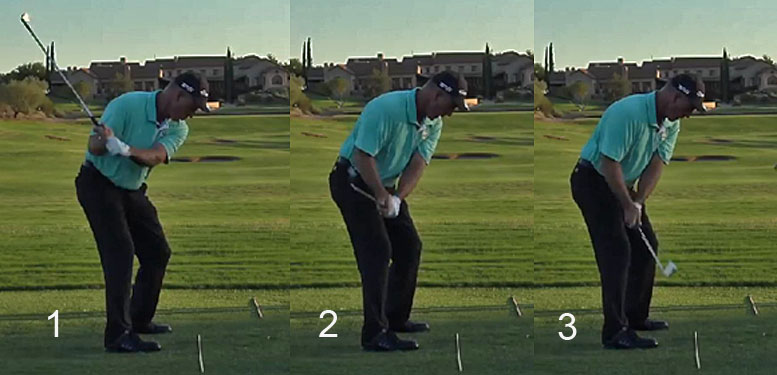
Image 1 shows Mike Malaska using a short backswing action. Note that his right palm is parallel to the inclined plane (swingplane) on which he clubshaft lies at that P position.
Image 2 shows him starting to perform the "Malaska Move" where he drops his hands to a point just outside his right thigh and where his hands are very close to his body and behind the toe line. Note that his right palm is now more vertical, and therefore parallel to a more steeper plane, than it was in image 1.
Image 3 shows how he swings the clubhead over his hands in order to get the clubhead outside his hands - using a "tumble action" ("clubshaft-steepening" action). Note that his right palm is partially on top of the club handle and it is not under the club handle in image 2 and image 3 (as seen in Sergio Garcia's "horizontal tug and vertical drop" clubshaft-shallowing action).
I believe that the "Malaska Move" maneuver
is a sub-optimal golf instructional concept and I have analysed the Malaska
Move" in i) a short review paper (
http://perfectgolfswingreview.net/MalaskaMove.html ), ii) a Newton Golf
Institute golf forum thread (
http://newtongolfinstitute.proboards.com/thread/674/mike-malaskas-misinterpretation-reality
) and iii) in a 2 hour 14 minute you-tube video called "Critical
Review: Analysing the "Malaska Move" Golf Swing Action". I definitely
believe that golfers must avoid using the "Malaska Move" golf swing
technique if they want to efficiently shallow the clubshaft in the early-mid
downswing like many professional golfers (eg. Sergio Garcia, Henrik Stenson, Adam Scott, Justin
Rose and Rory McIlroy) who all have their right palm under
the club handle at the P5.5 (and also the P6) position and where the
clubshaft is continuously on-plane throughout the entire early-mid
downswing. The "feel" of the "Malaska Move" may be suitable for golfers who
have the problem of the clubshaft falling back too much during the early-mid
downswing when they shallow their clubshaft, so that their clubshaft gets
too underplane (and an imaginary extension line drawn outwards from the butt
end of the club points well outside the ball-target line). However, that
swing fault should not plague skilled golfers who have successfully learned
how to keep their clubshaft continuously on-plane throughout their entire
downswing action.
Topic number 4: How to optimally move the pelvis during the early downswing
action between P4 and P5.
Tyler Ferrell believes that the optimal pelvic motion in the early downswing
starts with
a left-lateral pelvic shift followed by a rotary motion of the pelvis.
Here are capture images of Tyler Ferrell demonstrating his "shift-then-rotate" pattern of pelvic motion in his "real life" golf swing action.
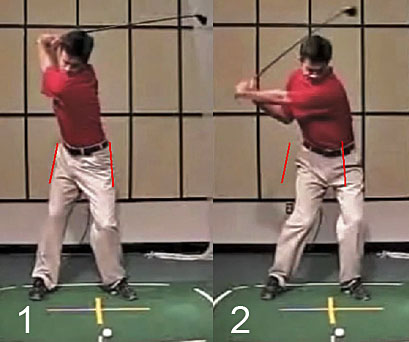
Image 1 shows Tyler Ferrell at his end-backswing position. I have drawn red lines along the outer border of his pelvis and upper thighs.
Image 2 shows Tyler Ferrell at his P5 position (lead arm parallel position). Note how much his pelvis has shifted targetwards while his pelvis has simultaneously rotated counterclockwise to become square to the ball-target line by P5. Note that his right thigh has a definite slant towards the target secondary to the left-lateral shift of his pelvis and that he does not have the "symmetrical dual-external rotation of the femurs" look that characterises the classic Sam Snead "sit-down" look pattern of pelvic motion. Note that he has shifted his pelvis left-laterally to such a significant degree that the outer border of his left pelvis is outside the outer boundary of his left foot's heel.
To get the pelvis to shift-laterally at the start of the downswing, Tyler Ferrell states that golfer should push off the inside of the right foot in a targetwards direction. In a golfsmartacademy.com website video called "Trail Leg Push Drill", Tyler Ferrell uses a furniture mover under his right foot to bank his right foot so that he can better push off his right foot. Tyler Ferrell's desired amount of left-lateral pelvic shift is small and in a golfsmartacademy.com website video called "How Much Lower Body Bump in Transition", Tyler Ferrell states that the amount of pelvic shift should be about 1/3 the width of the pelvis or just enough left-lateral shift to get a significant amount of secondary axis tilt. Tyler Ferrell states that the "feel" of the left-lateral pelvic shift (which is often called a "hip bump") can be relatively passive and be more like a "feel" of "falling onto the lead foot" - rather than being too assertively active, which can cause too much left-lateral pelvic shift that will cause the outer border of the left side of the pelvis to move too far outside the outer border of the left foot. Tyler Ferrell believes that if a golfer rotates the pelvis first, before shifting the pelvis leftwards, that it can either lead to a "hanging back" swing fault where the golfer pivots around the right foot instead of moving over to the left foot, or it can cause the right pelvis to rotate counterclockwise and produce a right hip spinning type of swing fault or it can predispose to an "over-the-top" move type of swing fault because it leaves the upper body too stacked over the lower body. I personally don't believe that rotating the pelvis first will predispose a golfer to manifesting those swing faults if the pelvis is rotated by the "correct" pelvic girdle muscles (which I will describe later in this topic's review section).
During the left-lateral pelvic shift action that happens between P4 and P5, Tyler Ferrell states that he wants the golfer to shift his weight onto his lead foot, so that he has 70% of his weight-pressure (70% of the overall center-of-pressure measurement) under the lead foot by P5. However, many skilled professional golfers have approximately 70-80% of their weight-pressure under the right foot at the end-backswing position and only 20-30% under the left foot, and Tyler Ferrell is advising golfers to shift their weight-pressure very fast from right foot-to-left foot during the early downswing time period between P4 and P5.
If you look at Tyler Ferrell's pelvic motion in those capture images above, you will note that he is also rotating his pelvis counterclockwise between P4 and P5 so that he squares his pelvis by P5. Let's presume that his pelvis is rotated 50 degrees clockwise at his end-backswing (P4) position and that it is square at the P5 position (when his lead arm is parallel to the ground), then that means that he is rotating his pelvis 50 degrees counterclockwise between P4 and P5, while he is also shifting his pelvis leftwards. What advice does Tyler Ferrell give a student golfer (developing golfer) that will help him to learn how to rotate his pelvis counterclockwise during the P4 => P5 time period so that he can square his pelvis by P5? In his golfsmartacademy.com website video called "Trail Leg Push Drill", Tyler Ferrell states that when a golfer pushes off the right foot, he should also twist his right foot in an external direction (clockwise direction away from the target) and he infers that it will cause the right hip joint to rotate in a diagonal direction towards first base. Tyler Ferrell does not describe which muscles are used to twist the right foot clockwise against the resistance of the ground, and whether they are located in the right foot area, right ankle area, right leg, right thigh or right pelvic girdle region. He also does not explain how twisting the right foot clockwise against the ground can cause the right hip joint area of the pelvis to move in a counterclockwise direction. In another golfsmartacademy.com website video, called "Side Bend Through the Ground", Tyler Ferrell states that a golfer should also push against the ground under the right foot in a 2 o'clock direction (with 12 o'clock being the position of the right foot's toes) and he asserts that it will cause the left hip joint area of the pelvis to rotate counterclockwise so that the left buttocks moves counterclockwise towards the tush line - although he does not explain how this phenomenon is biomechanically possible. These right foot's twisting-shear forces that Tyler Ferrell is describing are happening in the horizontal plane. However, Tyler Ferrell also seems to believe that he can cause his pelvis to rotate counterclockwise between P4 and P5 by pushing down into the ground in a vertical direction, thereby generating what are called vertical ground reaction forces. How can variations in vertical ground reaction forces, due to a golfer varying the amount of vertical push-pressure being exerted down into the ground under the two feet, rotate the pelvis counterclockwise?
Tyler Ferrell seemingly derives his "belief" - that by varying the push-pressure that he exerts in a vertical direction down into the ground under both his right foot and his left foot during his early downswing, that he can cause his pelvis to rotate counterclockwise - from Mike Duffey and Dr. Young Hoo Kwon (http://drkwongolf.info/drkwon.html). Here is a link to Dr. Kwon's website's html document where he describes the vertical ground reaction forces - http://drkwongolf.info/biom/grf.html ; and here a link to a html document where he describes how these vertical ground reaction forces can rotate a human golfer's body around its COM - http://drkwongolf.info/biom/fgmom.html . You can read that latter document in its entirety, or you can simply read the following extracts from that latter document. Also, here is a link to a you-tube video featuring an animated hypothetical golfer, where the GRM moments are constantly changing during the backswing and downswing - https://www.youtube.com/watch?v=fB2FQi1FyMg
In that latter document, Dr. Kwon makes the following series of statements-: "According to Newton's 2nd Law of Motion, only the external moments acting on the body can alter the angular momentum of the body. Potential sources of external moments include the external forces acting on the body (such as the ground reaction forces [GRFs] and the gravity of the body) and the external moments directly acting on the body (such as the ground reaction moments [GRMs]). Among these, the gravity acts through the body COM and cannot generate a moment about the body COM. Therefore, only the GRFs and the GRMs provide external moments to the body."
How do the GRFs produce external moments that cause pelvic rotation? Consider the following diagram that I copied from Dr. Kwon's document.
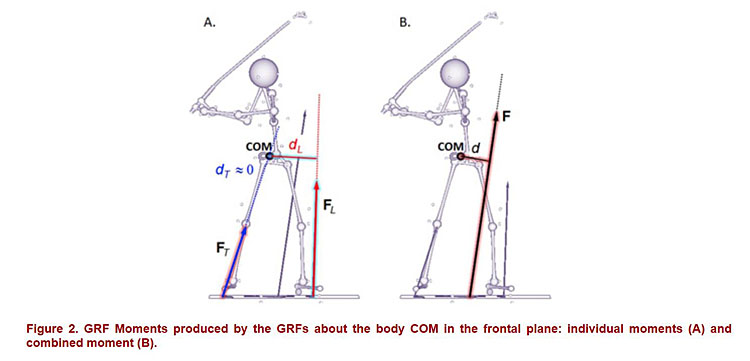
In his html document, Dr. Kwon states the following with respect to figure
2-: "Figure 2 shows the GRF moments produced by the GRFs acting on the
golfer's feet. The GRF moments are those produced by the GRFs about the COM
of the body. Figure 2A shows two GRF moments produced by the individual GRFs
acting on the feet in the frontal plane (face-on view). The moment produced
by the lead-foot GRF about the COM (lead-foot GRF moment) is equal to its
moment arm (dl) times the magnitude of the lead-foot GRF (Fl).
Moment arm is the perpendicular distance from the COM to the line of action
of the force (dotted line). The trail-foot GRF moment thus is equal to its
moment arm (dr)
about the COM times the magnitude of the trail-foot GRF (Fr).
The moment arm of the trail-foot GRF is almost 0 in this particular case as
it passes near to the COM. The frontal-plane GRF moment therefore is mostly
coming from the lead foot in this example. Figure 2B, in contrast, shows the
combined GRF moment in the frontal plane which is equal to the moment arm of
the combined force (d) times the magnitude of the combined GRF (F).
The combined moment is equal to sum of the individual GRF moments."
In the most basic explanatory way of describing this complex issue, I think that Dr. Kwon is asserting that the combined GRF (F), that is produced by vertical ground reaction forces that occur secondary to the golfer pushing down vertically into the ground under both the right foot and left foot, can cause a counterclockwise rotation of the pelvis because these F forces act through a moment arm (d) that is equal to the perpendicular distance between the F force vector and the COM (center-of-mass) of the body. Dr. Kwon does not describe which body muscles are used to create these ground reaction forces (GRFs) that are produced by the golfer pushing down vertically against the ground under his two feet and he does not explain how he can prove that those same muscles are not actually causing the pelvic rotation rather than his theoretically-conceived Newtonian forces. Also, Dr. Kwon states that "According to Newton's 2nd Law of Motion, only the external moments acting on the body can alter the angular momentum of the body". Do you believe Dr.Kwon's claim that "external moments" are the only forces that can cause an angular counterclockwise rotation of the pelvis in the horizontal plane between P4 and P5? What about the role of the lateral pelvic rotator muscles that have evolved over millions of years of human evolution and that are anatomically designed to rotate the pelvis in the horizontal plane of motion? Why does Dr. Kwon not mention their role in the counterclockwise pelvic rotation that happens between P4 and P5?
Consider the anatomy of the 6 lateral pelvic rotator muscles by viewing this superbly animated you-tube video
Anatomy Zone you-tube video (watch the first 7:29
minutes) -
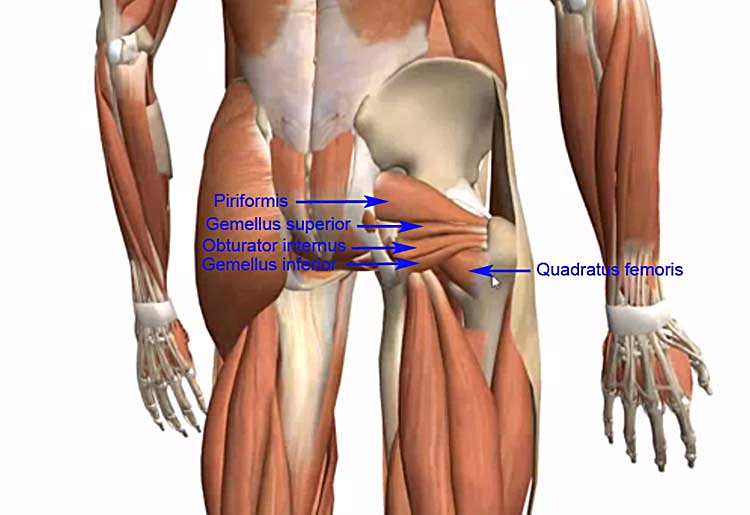
When these 6 right-sided lateral pelvic rotator muscles contract at the start of the downswing, with the right leg/foot stabilised, they cause the pelvis to rotate counterclockwise away from a weight-pressure loaded, and thereby "stabilised", right leg/foot. How does it work from a biomechanical perspective?
When the pelvis is rotated clockwise during the backswing action, thereby driving the right (trailing) hip joint into a condition of significant internal rotation by P4, then the right-sided lateral pelvic rotator muscles will become increasingly stretched - as demonstrated in this next image.
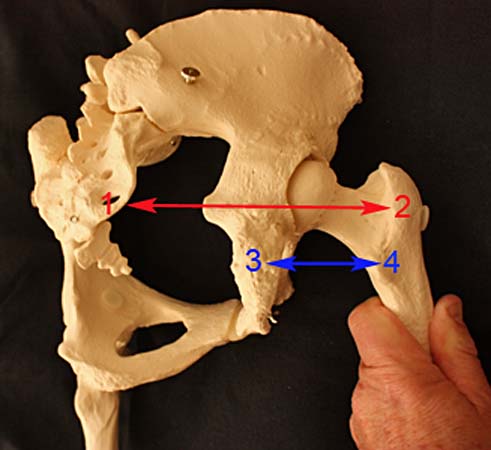
Note that I rotated the plaster-cast pelvis model about 50 degrees clockwise
before I took this photograph of my plaster-cast pelvis model. Note that I
have prevented the right femur from rotating clockwise by the same amount,
so that the right femur becomes internally rotated in the right hip joint.
When the right femur is internally rotated in the right hip joint, that
means that the points of insertion of the lateral pelvic
rotator muscles (points 2 and 4) are further away from their points
of origin (points 1 and 3). The points 1 - 2 represent the points
of origin and insertion of the piriformis muscle and the points 3 - 4
represent the points of origin and insertion of the quadratus femoris
muscle. I have only referred to those two lateral pelvic rotator muscles as
representative examples, but all the 6 lateral pelvic rotator muscles on the
right side are similarly stretched at the end-backswing position when the
right femur is internally rotated in the right hip joint.
When the 6 right-sided lateral pelvic rotator muscles are stretched at the end-backswing position, they are ready to contract during the early downswing. If they contract and shorten (thereby decreasing the distance between their points of origin and their points of insertion) they can cause external rotation of the right femur in the right hip joint assuming that the pelvis is stabilised or a counterclockwise rotation of the pelvis away from the right femur assuming that the right femur is stabilised. This is a critical point that one needs to fully understand - so I will discuss this issue in greater detail.
I stated that if
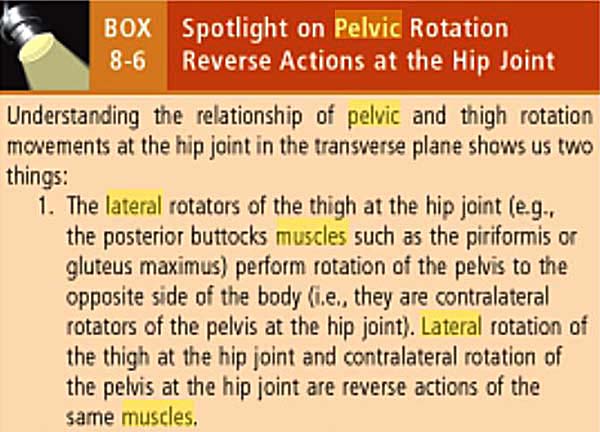
Now, consider those differential (reverse) actions in diagrammatic form.
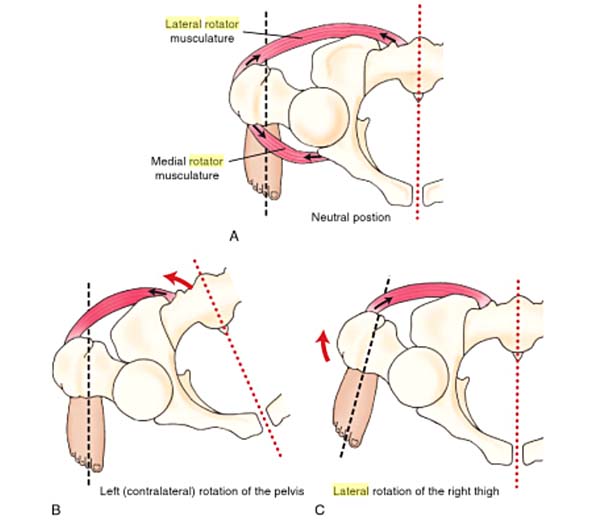
Diagram A shows the pelvis and ipsilateral femur in a neutral position. The black arrows shows that if the muscles contract and shorten, that they will cause the muscle's origin (on the pelvis or sacrum) and the muscle's insertion (on the upper femur) to move closer towards each other. Diagram B shows that if the right femur is "stabilised" that contraction of the right-sided lateral pelvic rotator muscles will cause the pelvis to rotate counterclockwise away from the "stabilised" right femur. Diagram C shows that if the pelvis is "stabilised" that contraction of the right-sided lateral pelvic rotator muscles will cause the right femur to laterally (externally) rotate in the right hip joint. I believe that diagram B is very applicable to the right hip joint/femur between P4 and P4.5 if weight-pressure loading of the right leg (due to the golfer actively pushing down into the ground under the right foot) causes the right leg to become "stabilised". At the end-backswing position, a pro golfer has roughly 70-80% of his overall COP-measurement under his right foot and if he maintains, or even slightly increases, his degree of weight-pressure loading of his right leg/foot at the start of the early downswing, then he can very effectively stabilise the position of the right femur in space between P4 and P4.5. Then, when the right-sided lateral pelvic rotator muscles contract, they will cause a counterclockwise rotation of the pelvis away from the "stabilised" right femur.
Here is an example of a world long-drive champion golfer - Jamie Sadlowski - rotating his pelvis counterclockwise between P4 and P5 by actively contracting his right-sided lateral pelvic rotator muscles.
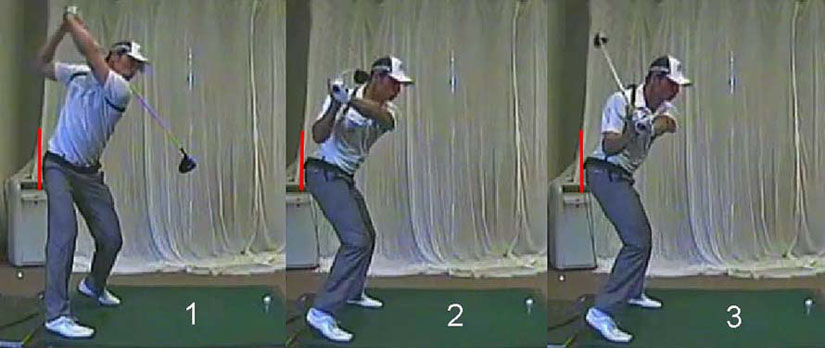
Image 1 is at Jamie Sadlowski's end-backswing (P4) position. Note that he has
rotated his pelvis about 60-70 degrees clockwise during his backswing. I
have drawn a red line against the back of his right buttock, and I call that
red line the tush line.
Image 2 and 3 show the counterclockwise rotation of his pelvis that happens between P4 (image 1) and P5 (image 3).
Note that Jamie Sadlowski rotates his left buttocks (left hip joint area of his pelvis) counterclockwise back towards the tush line while he still keeps his right buttocks against the tush line. That biomechanical combination is due to the fact that he is rotating his pelvis counterclockwise secondary to a contraction of his right-sided lateral pelvic rotator muscles while he maintains weight-pressure loading of his right leg/foot. If he didn't maintain weight-pressure loading of his right leg/foot during his hip-squaring phase between P4 and P5, then his right buttocks would prematurely leave the tush line. Note that he also has increased right hip joint flexion during his hip-squaring action due to activation of his right hip flexor muscles (primarily the iliopsoas muscle) while his right hip extensor muscle (right-sided gluteus maximus muscle) remains isotonically inactive (although it could be isometrically active). If he activated his right-sided gluteus maximus muscle in an isotonic manner between P4 and P4.5, then it would likely cause right hip extension +/- right hip spinning where the right buttocks (right hip joint area) would prematurely leave the tush line.
If you believe that Jamie Sadlowski's counterclockwise pelvic rotation, which is happening between P4 and P5, is entirely due to Dr. Kwon's theoretically-conceived Newtonian forces, then how would you explain why his right buttocks stays against the tush line while his left buttocks rotates back towards the tush line between P4 and P5? Surely, if the only "forces" causing the pelvis to rotate counterclockwise between P4 and P5 are "external moment forces" secondary to the combined GRF (F) acting via a moment arm around his COM, then one would naturally expect that his pelvis would rotate counterclockwise as a symmetrically rotating unit where the right buttocks would rotate forward away from the tush line while the left buttocks would simultaneously rotate back towards the tush line in a symmetrical manner.
Consider another two PGA tour golfers who have a superb pelvic rotary motion between P4 and P5 - Luke List and Cameron Champ. At the time of writing of this review paper (December 2018), Luke List and Cameron Champ have the longest "average" driving distance on the PGA tour - see https://www.pgatour.com/stats/stat.101.html - and I suspect that their superb pelvic rotary action during their early downswing is partly responsible for their prodigious swing power.
Let's first consider Luke List's pelvic rotary action between P4 and P5.
Here are capture images from a you-tube video (
https://youtu.be/40aU9Xm3QWw )
where Sasho MacKenzie is analysing Luke List's COP (center-of-pressure)
measurements during his downswing action.
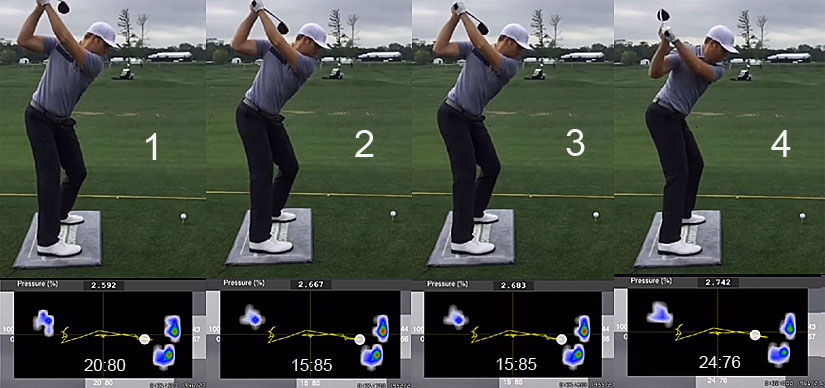
The COP readings are in a white font in that light-grey area, but they are
difficult to see, so I have repeated the COP readings in a larger white font
in the black area.
Image 1 is at his end-backswing (P4) position. Note that Luke List has 80% of his overall COP measurement under his right foot and 20% under his left foot.
Image 2 is when he starts his downswing's pelvic rotation. Note that he has 85% of his overall COP measurement under his right foot and 15% under his left foot. That means that he is actually increasingly weight-pressure loading his right foot as he starts the downswing's pelvic rotation.
Image 3 is fractionally later. Note that he still has 85% of his overall COP measurement under his right foot and 15% under his left foot. Note how much he has rotated his pelvis counterclockwise between image 1 and image 3.
Image 4 shows him reaching the end of his hip-squaring phase, which happens much earlier than P5 in his super-efficient pelvic rotary action. Note that he still has 76% of his overall COP measurement under the right foot and only 24% under the left foot.
I believe that Luke List is primarily using his right-sided lateral pelvic rotator muscles to rotate his pelvis counterclockwise between P4 and P5 and I think that he is super-efficient with respect to his ability to use his right-sided lateral pelvic rotator muscles to rotate his pelvis counterclockwise because he is "stabilising" his right leg/foot by maintaining a large degree of weight-pressure loading of his right leg/foot during his hip-squaring action. If he followed Tyler Ferrell's advice and quickly transferred his weight-pressure loading from the right foot => the left foot during the early downswing's P4 => P5 time period so that he already had 70% of his overall COP-measurement under his left foot, and only 30% of his overall COP-measurement remaining under his right foot, by the P5 position, then it is very likely that he could not use his right-sided lateral pelvic rotator muscles to rotate his pelvis counterclockwise with such great efficiency between P4 and P5.
If you currently believe that Dr. Kwon's theoretically-conceived Newtonian forces are causally responsible for rotating the pelvis counterclockwise during the hip squaring phase, then how might you explain Luke List's counterclockwise pelvis rotation that happens between P4 and P4.5? For example, it has been shown that Luke List still has 76-85% of his overall COP measurement under his right foot during the hip-squaring phase between P4 and P4.5, which means he has only 15-24% of his overall COP measurement under his lead foot during this time period. With this in mind, consider this video produced by Dr. Kwon - https://www.youtube.com/watch?v=fB2FQi1FyMg - and carefully watch what is happening between the 0.50 - 0.54 minute time point of the video. Note how the ground reaction force (GRF) moment produced by the right foot decreases between P4 and P4.5 while the GRF moment produced by the left foot dramatically increases. The moment arm also increases because the left foot's GRF moment is producing most of the GRF for the overall GRF moment (F), which surely necessitates that the theoretical golfer model must have most of his COP measurement under his lead foot during that hip-squaring time period. However, Luke List only has 15-24% of his overall COP measurement under his lead foot during his hip-squaring phase and thus it is unclear how he could be generating the necessary GRF moment force that Dr. Kwon's theoretical model requires in order for it to induce a counterclockwise rotation of the pelvis that happens during his hip-squaring phase. How might the contradiction between Luke List's actual COP data and Dr. Kwon’s theoretical model be explained?
Now, let's consider Cameron Champ's superb pelvic rotary motion between P4 and P5. Here is a link to a you-tube video - https://www.youtube.com/watch?v=BxLsFyJnkuo&t=218s - where Jeremy Wells is analysing Cameron Champ's Trackman figures, and also his golf swing action, and where he opines that Cameron Champ's prodigious swing power is partly derived from his downswing's very assertive pelvic rotary motion.
Here are capture images from a face-on swing video of
Cameron Champ's driver swing.
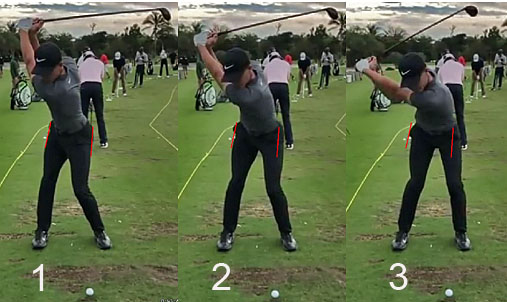
Image 1 is at his end-backswing (P4) position. I have drawn red lines
alongside the outer borders of his pelvis.
Image 2 is at the start of his downswing's pelvic rotary motion. Note that he is rotating his pelvis counterclockwise without any preliminary left-lateral pelvic shift motion (which is recommended by Tyler Ferrell who promotes a "shift-then-rotate" pattern of pelvic motion).
Image 3 is at the end of his hip-squaring phase, which happens well before P5. Note how little he has shifted his pelvis left-laterally during his hip-squaring phase and note that the outer border of his left pelvis is still well within the outer boundary of his left foot's heel (while Tyler Ferrell has the outer border of his left pelvis well outside the outer boundary of his left foot's heel at the end of his hip-squaring phase). Note that he has the "Sam Snead sit-down look" where his pelvis is still roughly centralised between his feet and where both thighs are in a state of symmetrical external rotation in their respective hip joints. I strongly suspect that Cameron Champ is using his right-sided lateral pelvic rotator muscles with maximum efficiency in order to rotate his pelvis counterclockwise during his early downswing's "rotate-and-shift" pattern of pelvic motion, while Tyler Ferrell cannot possibly be using his right-sided lateral pelvic rotator muscles very efficiently in his personal golf swing action because he is using a "shift-then-rotate" pattern of pelvic motion. I much prefer Cameron Champ's "rotate-and shift" pattern of pelvic motion where any small amount of left-lateral pelvic shift motion happening during the hip-squaring phase happens simultaneously during the early downswing's counterclockwise pelvic rotary motion (that is primarily due to an efficient contraction of the right-sided lateral pelvic rotator muscles). Note that there is no preliminary left-lateral shift of the pelvis happening before his pelvis starts to rotate, and there is no evidence to suggest that he is pushing off the inside of his right foot in a targetwards direction so that he can propel his pelvis in a left-lateral direction towards the target. I think that he is basically pushing vertically down into the ground under his right foot in images 1 and 2 so that he can "stabilise" his right leg/foot in space and I believe that he is not trying to push-off the inside of his right foot in a targetwards direction (as Tyler Ferrell recommends).
Jamie Sadlowski's pelvis and Cameron Champ's pelvis remain very centralised between their feet during their hip-squaring phase, while Luke List has significantly more left-lateral pelvic shift happening during his hip-squaring phase.
Here are capture images from a face-on swing video of Luke List's driver swing action.
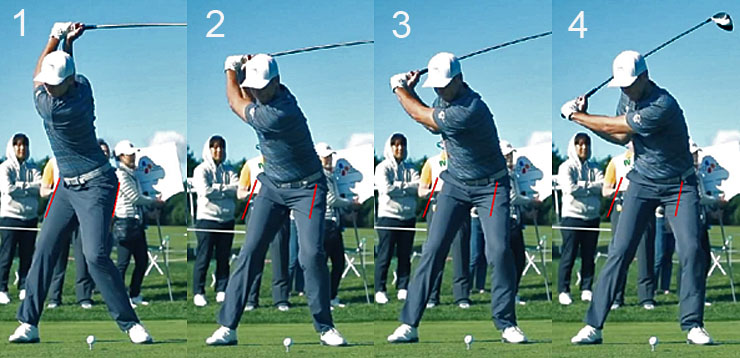
Image 1 is at his end-backswing (P4) position. I have drawn red lines
alongside the outer border of his pelvis.
Images 2, 3 and 4 show his pelvic rotary motion during his hip-squaring phase and you can clearly note that he has significantly more left-lateral pelvic shift motion happening during his hip-squaring motion (compared to Cameron Champ), but the outer border of his left pelvis is still well within the outer border of his left foot's heel at the end of his hip-squaring phase (image 4).
I think that it is perfectly acceptable for the pelvis to shift left-laterally to a small degree during the hip-squaring phase that happens between P4 and P5 (as seen in Luke List's golf swing action) - as long as the primary pelvic motion pattern is a "rotate-and-shift" pelvic motion pattern, rather than a sub-optimal "shift-then-rotate" pelvic motion pattern. I believe that it is biomechanically impossible to maximally use the right-sided lateral pelvic rotator muscles to rotate the pelvis counterclockwise between P4 and P5 if one uses Tyler Ferrell's recommended "shift-then-rotate" pelvic motion pattern - because it is impossible to optimally weight-pressure load, and thereby "stabilise" the right leg/foot, between P4 and P4.5 if the overall COP measurement moves too fast from the right foot to the left foot as a result of a preliminary left-lateral shift motion of the pelvis that happens before the right-sided lateral pelvic rotator muscles are activated.
During the past two decades, there has been a rapid development of new technological devices (eg. Trackman radar devices, force plate technology and 3D camera systems) that are now frequently used by golf instructors. The problem is that these new technological devices produce new data (new information) that a golf instructor still has to correctly interpret. For example, force plate technological devices can measure COP readings under both feet in the vertical plane, and some of the more sophisticated versions of these force plate devices can also measure shear forces produced under the feet in the horizontal plane. What these sophisticated force plate devices have discovered is the "fact" that professional golfers are generating a shear force (twisting force) under the right foot at the start of the downswing that is directed in a clockwise direction away from the target. Tyler Ferrell is aware of this "fact" and in his golfsmartacademy.com website's "Side Bend Through the Ground" video he states that it causes the left side of the pelvis to rotate counterclockwise back towards the tush line. Tyler Ferrell is not the only golf instructor who harbors this "belief" and Michael Jacobs (a golf instructor based in Long Island, NY) also harbors that "belief".
Here is an image that I copied from Michael Jacobs' book called "Swing Tips You Can Forget".
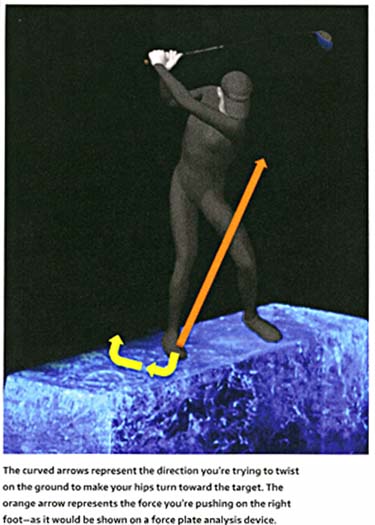
Here is the text from Michael Jacobs' book that accompanies this image-:
"Suspend reality for a second and imagine you're standing on a sheet of ice.
Without using a ball get in your normal stance. Now, make a slow backswing,
and as your body gets close to the end of its turn away from the ball, feel
it slow down even more while at the same time push with your right
(trailing) foot as though you are trying to spin it away from the target.
With your foot flat on the ground and spikes on, it won't actually spin out,
but the pressure you are creating will trigger your hips to
translate and turn in the opposite direction - toward the target".
It is understandable that Michael Jacobs and Tyler Ferrell might believe that generating a twisting-shear force under the right foot in a clockwise direction ("as though you are trying to spin it away from the target") would indeed cause a counterclockwise rotation of the pelvis towards the target. However, it is often valuable for golf instructors to be able to explain how a given swing motion is biomechanically, or mechanically, possible and they both fail to explain how this is biomechanically, or mechanically, possible!
Dr. Kwon described how foot contact moments can produce a GRM in his html document at http://drkwongolf.info/biom/fgmom.html .
Here is a copy of his description of foot contact moments from that html document.
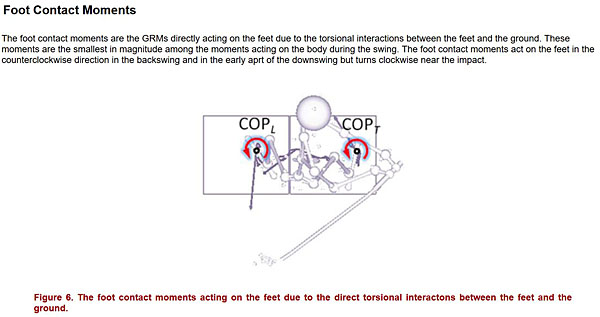
Note that Dr. Kwon wrote that these foot contact moments are very small in magnitude, and in a subsequent post in the "Facebook Golf Biomechanists" forum, I noted that he thought that they were insignificant in terms of importance when it comes to his ideology that Newtonian forces are causally responsible for inducing a pelvic rotation during the early downswing action. Thus, it appears that the premise of twisting the right foot in a clockwise direction against the ground in order to cause a counterclockwise pelvic rotation at the start of the downswing is an idea with little scientific merit.
It is also important to understand that golfers who weight-pressure load their right leg/foot during the P4-P4.5 time period (like Luke List) can also manifest a twisting-shear force under their right foot (that is directed clockwise away from the target) when measured using force plate technology, but that clockwise twisting force experienced under the right foot does not cause the pelvis to rotate counterclockwise and it is actually an "effect" of the muscular contraction of the right-sided lateral pelvic rotator muscles that are causally responsible for rotating the pelvis in a counterclockwise direction away from the weight-pressure loaded right leg/foot. When the right-sided lateral pelvic rotator muscles start to contract (shorten), they produce a muscular force that will attempt to externally rotate the right femur in the right hip joint. That muscular force torques the right femur in a clockwise direction away from the target and it causes the golfer to experience a "twisting force" under the right foot that is directed in a clockwise direction away from the target. However, the right foot does not visually twist clockwise against the ground because the right leg/foot is weight-pressure loaded and therefore "stabilised", and if the golfer has spikes/cleats under his right foot's shoe the right foot will not actually move outwards in a clockwise direction. What will happen instead, is that the pelvis will rotate counterclockwise away from the weight-pressure loaded right leg/foot secondary to the muscular contraction (shortening) of the right-sided lateral pelvic rotator muscles. So, the "feel" of a clockwise twisting force that is experienced under the right foot is actually an "effect" of the muscular contraction of the right-sided lateral pelvic rotator muscles and that "feel" will automatically/naturally dissipate when the pelvis progressively moves counterclockwise away from the weight-pressure loaded right leg/foot due to the progressive shortening of the right-sided lateral pelvic rotator muscles.
Now, consider yet another scenario, and consider what happens when Arnold Palmer starts his pelvic rotary motion at the start of his downswing action - by studying these capture images.
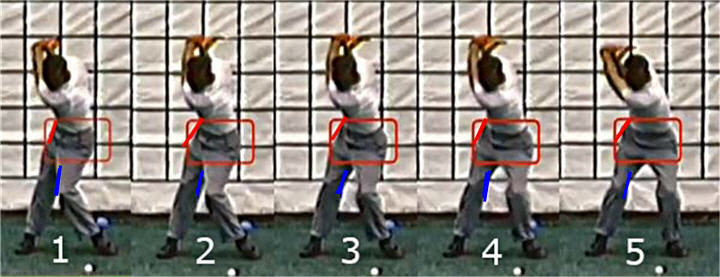
Image 1 shows Arnold Palmer at his end-backswing position. Note that his
pelvis is centralised between his feet; that he has adducted his left thigh
so his left knee gets very close to his right knee which causes his left
heel to lift-up off the ground; that he has rotated his pelvis clockwise by
about 60-70 degrees during his backswing; and that he has "turned his pelvis
into his right hip joint" creating marked internal rotation of the right
femur in the right hip joint. To highlight this, I have drawn a red line
alongside the outer border of his right pelvis and a blue line alongside the
right border of his left knee.
Images 2, 3, 4 and 5 show how he rotates his pelvis counterclockwise during his early downswing so that he completes his hip-squaring phase well before his lead arm gets to become parallel to the ground (which defines the P5 position). Note that there is very little left-lateral shift of his pelvis happening during the hip-squaring phase of his downswing. Also, note how much his left knee moves in a targetwards direction between image 1 and image 5; that his pelvis has rotated much more counterclockwise between image 1 and image 5 than his upper torso (shoulders) have rotated counterclockwise during the same time period; and that because of this, he is generating an increased degree of torso-pelvic separation (greater degree of dynamic X factor stretch) during his early downswing.
What might be causing Arnold Palmar's pelvis to rotate more than his mid-upper torso? According to Dr. Kwon, only a Newtonian "external moment" force (which can generate angular momentum of the body around its COM) can cause the golfer's body to rotate or pivot. But how can these potential Newtonian forces cause his pelvis to rotate much more than the mid-upper torso during the early downswing? And, what causes his left knee to move targetwards much faster, and by a greater amount, than the pelvis is rotating targetwards during that same time period?
In contrast, I believe it makes more sense to explain rotary body motions that happen during the golf swing by referring to the muscular contractions of specific body muscles. Consequently, I believe Arnold Palmer's pelvis rotates counterclockwise in his early downswing due to the muscular contraction of his right-sided lateral pelvic rotator muscles. I also believe his left knee moves targetwards (independently of the counterclockwise pelvic rotary motion that is happening at the same time) because he is externally rotating his left femur in his left hip joint socket due to a muscular contraction of his left-sided lateral pelvic rotator muscles. Finally, I think it is only logical that his shoulders (upper torso) do not rotate as much as his pelvis during his early downswing (between P4 and P4.5) because he has yet to significantly contract his abdominal oblique muscles that are responsible for rotating his shoulders (upper torso) during his mid-late downswing action.
Arnold Palmer certainly has an extraordinarily powerful, and efficient, counterclockwise rotary motion of his pelvis at the start of his downswing. Because of this, he manages to rotate his pelvis counterclockwise by 60-70 degrees during his hip-squaring phase that ends well before the P5 position (see image 5 where his left arm looks like it is still at the P4.25 position). How is this possible? I can only posit one possible mechanism to explain his superb pelvic rotary motion - the super-efficient muscular contraction of his right-sided lateral pelvic rotator muscles!
What is amazing to me is that many professional golfers in the Arnold Palmer era of the 1950s were employing a "rotate-and-shift" pattern of rotary pelvic motion during their early downswing's hip-squaring phase. They certainly were not using the "shift-then-rotate" pelvic motion pattern that some golf instructors recommend today.
Consider this golf instructional video that was filmed in 1953 (long before the era of force plate technology and the era of COP-measurements)
https://www.youtube.com/watch?v=yHvCzmi8FzU
It's an interesting video that is worth watching - if only to see the swings of famous golfers like Sam Snead, Ben Hogan and Lew Worsham.
Here is a link to a shorter (unedited) version of that video that shows the golf instructor teaching a "no-weight shift" type of pivot motion.
https://www.youtube.com/watch?v=Hk33ksSHFvc
That golf instructor uses Lew Worsham as an example of how a golfer should only think of performing a centered rotary pelvic motion during the downswing - without ever thinking of deliberately shifting any body weight (COM) from right-to-left in a targetwards direction. He states that any small degree of weight shift that may happen during the downswing will happen naturally during the rotary pivot motion. I think that it is highly likely that there is very little body weight shift (COM-shift) happening during Lew Worsham's downswing action - although there is likely to be a significant shift of his overall COP-measurement from right-to-left during his downswing action. Lew Worsham likely has 70-80% of his overall COP measurement under his right foot at his end-backswing position and then 70-80% of his overall COP-measurement under his left foot at impact. That represents a large shift from right => left in terms of COP-measurements (which are a measure of weight-pressure loading into the ground and not a measure of COM-shift), and there is no apparent targetwards shift of his torso during his downswing action. His torso remains remains roughly centered between his feet during his entire downswing action.
Here are birds-eye view capture images of Lew Worsham's early downswing action (from that video).
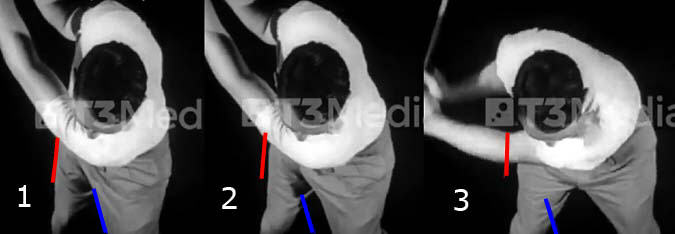
Image 1 shows Lew Worsham at his end-backswing position (P4 position). I have drawn a red line against the outer border of his right pelvis and a blue line against the right side of his left lower thigh.
Image 2 and 3 show his early downswing's rotary pelvic motion. Note how he squares his pelvis by P5 (image 3) - presumably by contracting his right-sided lateral pelvic rotator muscles (that rotate his pelvis counterclockwise away from his "stabilised" right leg) - and note that there is very little left-lateral pelvic shift motion of his pelvis away from that red line during his rotary pelvic motion. His pelvis only shifts a few inches left-laterally and it happens while he is rotating his pelvis counterclockwise, and there is no preliminary left-lateral shift of the pelvis (as recommended by Tyler Ferrell). Note that his left thigh is being abducted and externally rotated away from that blue line due to the muscular contraction of his left-sided lateral pelvic rotator muscles (in combination with the fact that his pelvis, and therefore left hip joint, is rotating counterclockwise back towards the tush line as a result of the contraction of the right-sided lateral pelvic rotator muscles). Note how his pelvis remains roughly centered between his feet during his early downswing's rotary pelvic motion.
A fair number of professional golfers in the modern-day era are using a "shift-then-rotate" pattern of pelvic motion where they get 70% of their overall COP-measurement under their left foot at the P5 position, and many modern-day golf instructors (like Tyler Ferrell and Mike Granato of Athletic Motion Golf) are teaching this "shift-then-rotate" pelvic motion pattern, but I much prefer the "rotate-and-shift" pattern of pelvic motion manifested by golfers like Sam Snead, Lew Worsham, Arnold Palmer, Jamie Sadlowski, Luke List and Cameron Champ.
Finally, if you, as the reader, would like more
information on how muscular forces (and not theoretically-conceived
Newtonian forces) are causally responsible for rotating the pelvis
counterclockwise during the early hip-squaring phase of the downswing
(between P4 and P5), please refer to my review paper called "Critical
Update: How to Optimally Rotate the Pelvis during the Downswing" and
also my 1 hour 48 minute video called "How
to Optimally Rotate the Pelvis During the Downswing".
Topic number 5: Biomechanical and mechanical factors that produce swing
power generation in a professional golfer's driver golf swing action.
In chapter 25 of his "Stock Tour Swing" book Tyler Ferrell discusses many biomechanical movements that
he believes contribute to swing power generation.
Here is a description (using copies of images from Tyler Ferrell's "Stock Tour Swing" book) of the many biomechanical movements that Tyler Ferrell believes are causally responsible for generating swing power in a driver golf swing action.
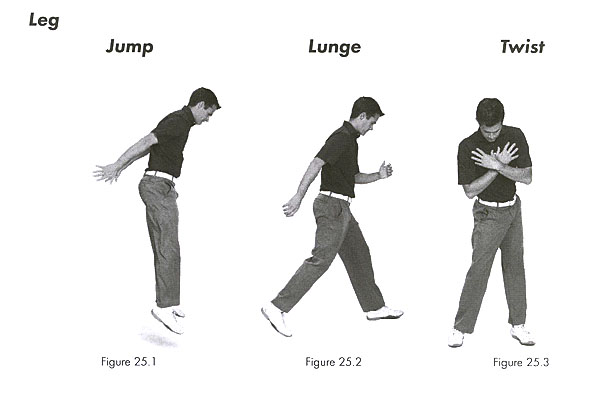
Tyler Ferrell first describes how swing power is derived from the "legs".
The first biomechanical movement he describes is the "jump" and he states that the "jump" itself is a firing of the loaded knees, hips and ankles. Tyler Ferrell does not specifically describe how the "jump" action can increase swing power. Many professional golfers have increased knee and hip joint flexion during their early downswing between P4 and P5, and that biomechanical phenomenon causes their head to drop a few inches. They then straighten both their knees and acquire more hip joint extension in their later downswing between P5.5 and impact, which represents a "jumping up" type of motion. However, I cannot understand how the "jump" motion happening between P5.5 and impact can increase swing power, other than through the phenomenon of parametric acceleration (which I will discuss later in this topic).
The second biomechanical movement he describes is the "lunge". He is primarily referring to the lateral lunge of the pelvis during the early downswing when the pelvis shifts left-laterally towards the target. However, I cannot understand how a left-lateral pelvic shift between P4 and P5 can increase swing power. In fact, I think that the premature transfer of the overall COP-measurement from the right foot to the left foot between P4 and P4.5 prematurely unloads the weight-pressure loading of the right leg/foot and that will make it more difficult for a golfer to contract the right-sided lateral pelvic rotator muscles with maximum efficiency, and I believe that it will therefore decrease the overall efficiency of counterclockwise pelvic rotation between P4 and P5.
The third biomechanical movement he describes is the "twist". Although he lists that motion under "legs", he is actually referring to the counterclockwise pelvic rotation happening during the hip-squaring phase between P4 and P5. Tyler Ferrell states in his book that "this is a powerful movement sourced from your glutes and thigh muscles" and "that it makes your full body rotate like a top". I agree that an active counterclockwise pelvic rotation during the early downswing can contribute to a better rotation of the entire torso (pelvis and mid-upper torso), but I believe that it should be secondary to the contraction of the right-sided lateral pelvic rotator muscles, and not the right-sided gluteus maximus muscle, which can induce an undesirable right hip spinning pattern of pelvic motion +/- the swing fault of "early extension".
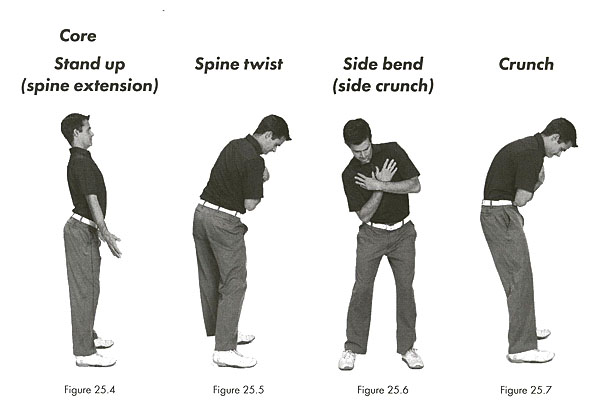
Tyler Ferrell then describes how swing power is generated from the "core".
The first biomechanical movement he describes is "spine extension" which is a "standing up" motion primarily due to hip joint extension. I cannot understand how spine extension can increase swing power because most of a golfer's swing power is generated between P4 and P5.5, and I do not believe that a golfer should be "standing up" and losing their spinal bend inclination during that time period.
The second biomechanical movement he describes is "spine twist", which is basically the active counterclockwise rotation of the upper torso that happens throughout the downswing and followthrough. I can readily agree that the "spine twist" is a major source of swing power in a pivot-induced TGM swinging action (which is the swing technique used by the majority of professional golfers).
The third biomechanical movement he describes is "side-bend", which he also calls a "side-crunch". I refer to the biomechanical phenomenon of right-sided "side-bend" as the phenomenon of right lateral bending and I think that it is a very useful biomechanical movement in the early-mid downswing action because it makes it easier for a golfer to shallow the clubshaft during the early-mid downswing and it also makes it easier for a golfer to generate an "in-to-square" clubhead path during the downswing rather than an "out-to-in" clubhead path due to an over-the-top swing action. However, I cannot envisage how it actually contributes to increasing a golfer's driver swing power if the golfer uses a TGM swinging action.
The fourth biomechanical movement that he describes is the "crunch". In his book, Tyler Ferrell states that the "crunch" is a "powerful movement from the abs but tends to pull the upper body towards the lower body". I personally cannot envisage how bending the thoracic spine at the level of the mid thoracic spine so that the thoracic spine becomes more kyphotic (hunch-backed) can increase swing power, and I do not see that type of biomechanical phenomenon happening in professional golfers.
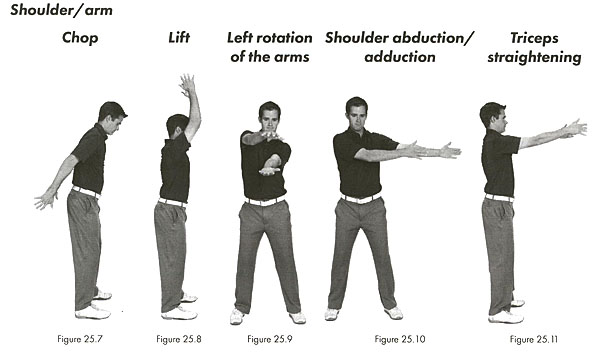
Tyler Ferrell then describes how swing power is generated by the "shoulders/arms".
The first biomechanical movement that he describes is the "chop". Tyler Ferrell states that it is due to activation of the latissimus dorsi muscles and that it causes a downward movement of the arms. I can readily agree that the downwards movement of the left arm and right arm during the downswing is a major swing power source.
The second biomechanical movement that he describes is the "lift". Tyler states in his book that "a lift is the opposite of a chop; it involves raising the arms and uses the shoulders as the primary engine". I do not really understand what Tyler Ferrell is talking about in his description. I can agree that the left shoulder socket elevates during the downswing's P5.5 => P7 time period, and I can envisage how it can produce parametric acceleration of the club, but I do not know if Tyler Ferrell is referring to that swing power generating phenomenon.
The third biomechanical movement that he describes is "left rotation of the arms", which he also calls "trail shoulder internal rotation". Tyler Ferrell states in his book that "this is loaded by external rotation in the backswing and powered by the pecs and lats". I can understand how internal rotation of the right upper arm can generate swing power in a right arm swinging action and a TGM hitting action if a golfer uses a punch elbow motion of the right elbow, but I personally do not perceive that it can be a significant swing power source in a TGM swinging action where the golfer should be using a pitch elbow motion of the right elbow.
The fourth biomechanical movement that he describes is "shoulder abduction/adduction". Tyler Ferrell states in his book that "This is the arm working across your body, as seen in a back-hand shot in tennis, or a back hand throw with a Frisbee". I can readily agree that the left arm motion of abduction during the downswing is a major source of swing power in a TGM swinging action.
The fifth biomechanical movement that he describes is "triceps straightening". In his book, Tyler Ferrell states "In golf, this movement is seen in the right arm and combines with right wrist flexion". I can readily agree that an active contraction of the right triceps muscles is an active swing power source in a TGM hitting action and in certain variants of a right arm swinging action, but I do not believe that it can contribute to swing power in a TGM swinging action. In a TGM swinging action, the right arm only straightens passively after P5.5 and it cannot produce swing power in the later downswing by causing the right palm to produce push-pressure against the aft (back) side of the clubshaft because the club is traveling faster than the right hand after P6 in a TGM swinging action - see the discussion of positive alpha torques versus negative alpha torques later in this topic.
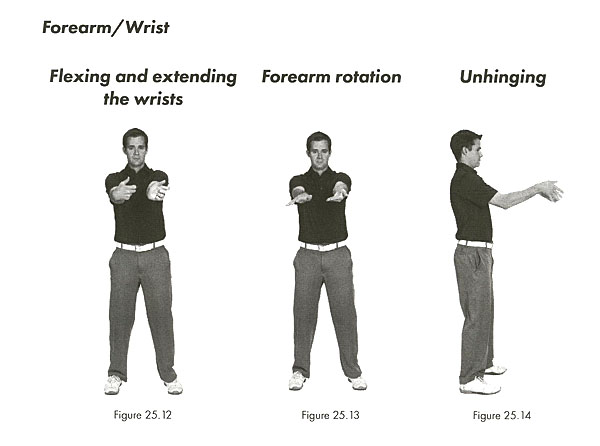
Tyler Ferrell then describes how swing power is generated by the "forearms/wrist".
The first biomechanical movement he describes is "flexing and extending the wrists". In his book, Tyler Ferrell primarily refers to "flexion of the trail wrist", which he also calls a "scoop" or a "flick". I personally believe that an active right wrist straightening action in the late downswing cannot contribute to swing power in a TGM swinging action, and I believe that it represents a major swing fault that can cause a positive alpha torque and even clubshaft-flipping if it happens pre-impact.
The second biomechanical movement that he describes is "forearm rotation". Tyler Ferrell is referring to the phenomenon of forearm pronation and supination. I personally do not think of left forearm supination and right forearm pronation, which happen during the downswing, as a swing power source, and I think that their major function is related to the obligatory clubface-squaring action that happens in the late downswing (and which I described in topic number1).
The third biomechanical movement that he describes is "unhinging". Tyler Ferrell is basically describing the phenomenon of how the left wrist moves from radial => ulnar deviation during the mid-late downswing and I can readily agree that it is a major swing power source in a TGM swinging action.
After describing all the biomechanical movements that
can potentially contribute to swing power, Tyler Ferrell then describes
which of those biomechanical movements are used in his "Stock Tour Swing"
model's swing action - see the following "common combinations" list from page 156 of his
book that lists the body movements responsible for swing power generation in
different golf swing styles.
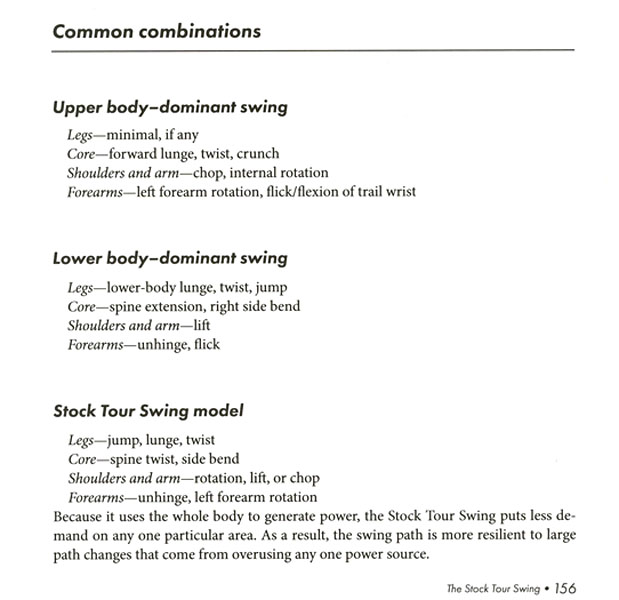
Note the combinations of biomechanical movements that Tyler Ferrell recommends for his Stock Tour Swing model. If you (as a reader of this review paper) decide that his list of swing power sources will help you to improve your driver golf swing action from a swing power perspective, then you have a very different perspective than me. I have a totally different way of thinking about how to maximise swing power in a driver golf swing action and I will now describe my personal opinions so that you (as a reader of this review paper) can consider an alternative approach on how best to maximise your swing power in your driver golf swing action.
I think that Homer Kelley's power accumulator (PA) loading/unloading approach, which he described in his TGM book called the "The Golfing Machine", is the most useful way of thinking about how swing power is generated during a golf swing action. Homer Kelley described three different golf swing techniques - i) TGM swinging (also called "lead arm swinging" or "left arm swinging") which is based on the loading/unloading of PA#4 => PA#2; ii) TGM hitting which is based on the loading/unloading of PA#1 and iii) Right arm swinging, which is based on the loading/unloading of PA#5 (which is a PA-term that I personally coined). I have described these three different golf swing techniques in two review papers called "How to Power the Golf Swing" and "Power Mechanics of Swinging, Hitting and Swing-hitting".
I will now only refer to a pivot-induced TGM swinging golf swing technique (during the rest of this topic's discussion about biomechanical factors that can potentially increase swing power) because I believe that it is the primary golf swing technique used by the majority of professional golfers.
I will start off by describing how a golfer loads/unloads PA#4, and then how he loads/unloads PA#2, and I will then subsequently describe a number of biomechanical and mechanical factors that a golfer can use to increase the amount of swing power that can be generated by the efficient loading of PA#4 and PA#2 and the subsequent efficient sequential unloading of PA#4 => PA#2.
To understand Homer Kelley's PA-concept as it applies to a TGM swinging action, it is important to understand that a golfer's only connection with the golf club is through his two hands, which are basically the end-extension of his two arms. To generate swing power, and to maximise clubhead speed at impact, a golfer (who uses a TGM swinging technique) essentially powers the golf swing during the downswing by a swinging motion of the left arm (lead arm), which will pull the golf club towards the ball via the left hand's attachment to the grip handle. At address, the left arm usually hangs down near-vertically (or slightly extended away from the body) and it is connected to the body at the level of the left shoulder socket, which is the fulcrum point of the left arm swinging motion. During the backswing, the left shoulder moves backwards away from the target by a finite amount due to torso rotation, while the left arm is simultaneously elevated and adducted across the upper body. At the end-backswing position, the left arm is adducted to a variable degree across the front of the upper torso, and it may be closely adducted against the left pectoral area or there may be a significant gap between the left upper arm and the left upper chest wall. Also, when the left arm is elevated, it can be elevated to a level where the left hand is roughly at the level of the right shoulder socket at the end-backswing position, or the left hand can end up being slightly below, or significantly above, the level of the right shoulder socket. Positioning the left arm at its end-backswing position, where the left arm is elevated and also adducted across the upper chest, represents the loading of PA#4 (which Homer Kelley called the "master" power accumulator - presumably because it supplies most of the swing power during a TGM swinger's full golf swing action).
Here is an image from Homer Kelley's TGM book showing the loaded/unloaded position of PA#4.
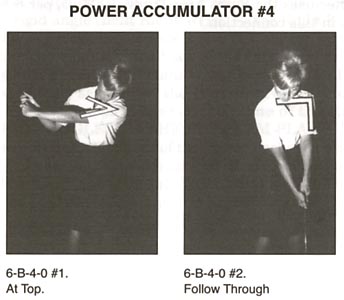
At the end-backswing position (top) one can see that the left arm has been elevated to a level that is roughly parallel to the shoulder turn angle, and that it is also adducted across the front of the upper torso at roughly the level of the pectoral area. Note that Homer Kelley has drawn two lines - one line representing the front of the upper torso (and that line is drawn from the left shoulder socket towards the right shoulder socket) and the second line represents the left upper arm - and that there is an acute angle between those two lines, which meet at the position of the left shoulder socket. At that end-backswing position, a golfer has a loaded PA#4. During the downswing, the left arm will move downwards, and also away from its adducted position at P4 to become significantly abducted away from the body at impact. Note that the angle between those two drawn lines changes to a less acute angle during the downswing, and the change in that drawn angle between the left arm relative to the upper body reflects the unloading (release) of PA#4. Many TGM literalists think of PA#4 unloading as being due to a change in that acute angle between the left arm and the upper chest wall in the plane of adduction => abduction, and they think of swing power being generated during the downswing by the left arm moving away from its adducted (loaded) position at P4 to its abducted (unloaded) position at impact. I personally hold a significantly different opinion regarding the specific direction of the unloading of PA#4, and I prefer to think of the left arm's PA#4-unloading motion happening three-dimensionally in "real life" 3-D space due to the left arm unloading motion happening simultaneously in two planes - i) moving from the left arm being adducted at P4 to the left arm becoming more abducted at impact and ii) moving from the left arm being elevated at P4 to the left arm becoming near-vertical by impact. To best measure the degree of PA#4 unloading at any time point during the downswing, I prefer to think of the distance traveled by the left hand in 3-D space away from its end-backswing position (where it was close to the right shoulder socket area) towards its impact position (where it is far away from the right shoulder socket area) and I do not only think of the change in that acute angle drawn between the left upper arm and the front of the upper chest (as depicted in that 2-D representational image from the TGM book). If one thinks of the PA#4 release (unloading) action as happening when the left hand moves further away from the area of the right shoulder socket, then when does the start of the PA#4 release action first happen?
It is obviously possible for PA#4 to start being released from the very start of the downswing if the left arm is pulled away from its adducted/elevated P4 position - as happens in Leslie King's left arm swinging methodology where the left arm is swung independently down-and-forwards towards the ball and where the golfer uses a reactive pivot action. That type of driver golf swing action is limited in power because it only uses muscular power derived from the shoulder girdle muscles to swing the left arm across the front of the reactively rotating body. By contrast, most PGA tour golfers use an active pivot action-induced TGM swinging action, which starts with a lower body (pelvis) counterclockwise rotation followed shortly thereafter by an upper torso counterclockwise rotation. When the upper torso starts to rotate counterclockwise around the rightwards-tilted spine, the left shoulder socket primarily moves in a horizontal (targetwards) direction during the early downswing and it pulls the left humeral head in the same direction. However, there is often a time delay before the left arm moves away from its adducted and elevated position during the transition phase to the downswing, which means that the distance between the left hand and the right shoulder socket doesn't necessarily increase in the first half of the early downswing (between P4 and P4.5).
Consider an example of that phenomenon - featuring the downswing of Gary Woodland.
Capture images from a Gary Woodland swing video taken from an elevated camera-viewing perspective.

Image 1 shows Gary Woodland at his end-backswing position. Note that he has
a loaded PA#4 where his left arm is both adducted and elevated so that his
left hand is behind and just above his right shoulder socket area.
Image 2 shows his early downswing where he is starting to rotate his pelvis counterclockwise, but where there has been very little counterclockwise rotation of his upper torso happening during that transitional time period. Note that his PA#4 is still fully loaded.
Image 3 is at the end of his early downswing (P5 position). Note that he has already squared his pelvis, and his upper torso has started to rotate counterclockwise. Note that there is visual evidence that the distance between the left hand and the right shoulder socket is starting to increase, and this represents the start of the release of PA#4.
Image 4 is at the P5.5 position. Note that there is now clear evidence of the left hand moving away from the right shoulder socket area as the left arm moves downwards (groundwards) and also targetwards in a left arm abductory direction - secondary to the pivot action causing the left shoulder socket to move targetwards, which pulls the left upper arm in the same direction; and secondary to activation of the left shoulder girdle muscles, which helps to pull the left arm in a more groundwards direction; and secondary to an active right arm adduction maneuver, which is associated with a pitch elbow motion of the right elbow and that causes the right palm to apply a finite level of push-pressure against PP#1, which is located over the base of the left thumb.
Although the release of PA#4 is the major source of swing power in a driver golf swing action, a professional golfer can get a significant amount of additional clubhead speed by impact by upcocking his left wrist during the backswing, which will load the club relative to the left arm (in the left wrist's plane of radial-ulnar deviation) so that there is a ~90 degree angle between the clubshaft and the left arm at the end-backswing position, and that club-loading phenomenon (relative to the left arm) represents the loading of PA#2. The release (unloading) of PA#2 is often referred to as the unhinging of the wrists or the "release of the club", which usually happens in the later phase of the mid-downswing, often starting when the golfer reaches nearer to the P5.5 position. When the club releases it should preferably release within the plane of the intact LFFW, which is in the plane of left wrist radial => ulnar deviation, so that the club release phenomenon doesn't disrupt an intact LFFW alignment. What causes the club to release in a TGM swinging action? I believe that the club will automatically/naturally release in a TGM swinging action according to the principle-of-physics underlying the release mechanics of a double pendulum swing model, and I believe that it should not occur manually secondary to any active left wrist uncocking action, or due to any push-pressure being applied against the aft side of the club handle below the coupling point by the right hand's distal palm and index finger. The best explanation that I have presently discovered to explain the physics causing the club release action was originated by "nm golfer" - see his mathematical explanation here . The mathematical explanation is complicated, so to express the mathematical club release concept (which is based on the D'Alembert principle) in very simplistic terms, one can think of the club automatically releasing when the left hand arc path changes its directional shape from being a straight-line curvilinear hand arc path (where the left hand and COG of the club are moving roughly straight-in-line in the same general direction along roughly the same curvilinear path) to becoming much more circular in shape and where the hand arc path's direction is changing constantly as it traces along the circumference of an imaginary circle that has a small radius. Secondly, it is important to understand that the club will release with a greater degree of releasing power if the change in the circular-shaped left hand arc path is "tighter" ( = smaller radius), which means that the amount of change in left hand direction per unit distance of travel of the left hand down the hand arc path, is greater.
Here is Jamie Sadlowski's (a previous world long
drive champion's) hand arc path.
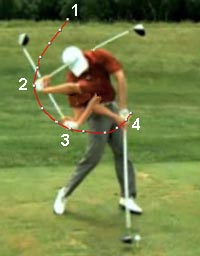
The red splined path is Jamie Sadlowski's hand arc path.
Point 1 is the position of his hands at his end-backswing position. Point 2 is the position of his hands at the P5 position (when the left arm is parallel to the ground). Note that his hands are moving slightly backwards (away from the target), but mainly downwards, between point 1 and point 2 due to rotation of the upper torso that happens prior to the release PA#4. That section of the hand arc path is relatively straight, and it doesn't induce the club to release because there is very little change in the direction of left hand travel during that straight-line section of the hand arc path. Note that Jamie Sadlowski therefore still has an enormous amount of clubhead lag at the P5 position. Point 3 is when his hands are at the P5.5 position. The hands are still moving downwards, but now much more targetwards, between point 2 and point 3, and the change in his hand path direction becomes much more abrupt as his left hand bypasses point 2, and this next section of his hand arc path between point 2 and point 3 is representative of a small radius circular hand arc path where the left hand path changes its direction constantly as the left hand tracks along a circular path that has a small radius, and that "tight" circular hand arc path phenomenon causes his club to release with a greater degree of club releasing-power (according to the D'Alembert principle described by nm golfer). Note how much his club has released at point 3 compared to point 2. The club then continues to release during the remainder of the downswing until it finally catches up to the left arm by impact (point 4).
After having briefly explained the TGM concepts regarding the loading/unloading of PA#4 and PA#2, I will now start to describe many biomechanical factors that can potentially increase the amount, or speed, of release of PA#4 and then PA#2.
Consider these capture images of Jamie Sadlowski's driver golf swing action.

Image 1 is at his end-backswing (P4) position where he has a fully loaded PA#4 and a fully loaded PA#2 and where he also has a fully loaded pivot action, which he is going to use as the "workhorse" that will unload PA#4 very fast between P4 (image 1) and P5.5 (image 4).
Let's first analyse his pivot action that must have happened during his backswing in order for him to acquire a fully loaded pivot action by his P4 position (image 1). During his backswing, Jamie Sadlowski rotated his pelvis clockwise by approximately 60+ degrees while he rotated his upper torso (shoulders) much more clockwise. According to some 3-D data that I have seen, Jamie Sadlowski can rotate his upper torso (shoulders) to ~140 - 160 degrees, which means that he has acquired a static X-factor of approximately 80 - 100 degrees by his P4 position. That prodigious amount of static X-factor is due to the fact that he has a remarkable degree of thoracic spine flexibility that allows him to rotate each thoracic vertebra by about 6 - 8 degrees relative to its neighboring thoracic vertebra. That remarkably high degree of acquired static X-factor by P4 is a great advantage from a swing power perspective - because it pre-stretches his abdominal oblique muscles and paraspinal muscles to their maximum stretchable length. Those optimally pre-stretched core muscles can then be used during his downswing in order to rotate his mid-upper torso with maximum efficiency and speed. Note that he has rotated his pelvis by 60+ degrees during his backswing thereby driving his right hip joint into internal rotation, and it is very likely that his right-sided lateral pelvic rotator muscles are optimally pre-stretched by his P4 position (image 1). Accordingly, he can therefore optimally activate these muscles during his downswing in order to rotate his pelvis with maximum efficiency and speed.
It is incredible how much Jamie Sadlowksi adducts his left arm during his backswing to get his left arm to approximately the 12 o'clock position by P4. That represents a fully loaded PA#4 scenario. He also simultaneously prefers to elevate his left arm to a P4 position on a steeper plane, where his hands are high above his right mid-clavicle area. Many long-drive competitors use this "high hands" P4 position because it allows them to position their clubshaft behind their back to achieve an even greater degree of clubhead lag. And, because Jamie Sadlowski has an extremely flexible left wrist (which allows for a much greater degree of radial deviation), he is able to point his clubshaft toward the ground at his P4 position, and achieve much more clubhead lag than most professional golfers.
Note that I have placed a green circle marker over his left shoulder socket area when he is at the P4 position (image 1) to show the position of his left shoulder socket. Note that I have placed a yellow circle marker over his left shoulder socket area when he is at his P4.5 position (image 2), and that I have placed a blue circle marker over his left shoulder socket area when he is at his P5 position (image 3). If you look at the motion of his left shoulder socket between P4 and P5, you can see that it is moving in a relatively horizontal direction towards the target. The amount of left shoulder socket motion (in a targetwards direction) happening between P4 and P5 is a major swing power factor when it comes to a golfer's ability to unload PA#4 with maximum efficiency because the targetwards motion of his left shoulder socket is causally responsible for pulling his left humeral head, and therefore his left upper arm, in a targetwards direction. However, the targetwards range of motion of the left shoulder socket happening between P4 and P5 is only one swing power factor that determines the speed of release of PA#4 and it is also very important to move the left shoulder socket, and therefore the left upper arm, very fast between P4 and P5. The speed of left shoulder socket motion happening between P4 and P5 is directly proportional to the speed of rotation of the upper torso happening during that time period. Jamie Sadlowski, like most professional golfers, uses an optimised kinematic sequence, that allows him to maximise his speed of upper torso rotation between P4 and P5.
Consider Jamie Sadlowski's kinematic sequence 3D graphs.
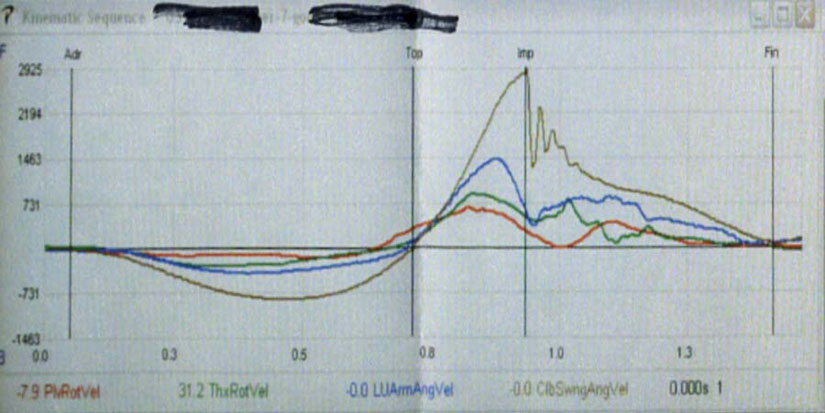
The black vertical line at "top" represents his P4 position, while the black vertical line at "imp" represents his P7 position. The red graph represents his pelvic rotation graph, the green graph represents his upper torso (thorax) rotation graph, and the blue graph represents his left arm angular velocity graph. The horizontal black line represents the zero line. Note that Jamie Sadlowski's red graph gets above the zero horizontal black line before the red graph reaches the "top" vertical black line, which means that he is starting to rotate his pelvis counterclockwise while his arms and clubshaft are still moving back to their final end-backswing position. Note that his green graph crosses the horizontal zero line fractionally later, which means that there is a slight delay in the counterclockwise rotation of his upper torso (relative to the counterclockwise rotation of his pelvis) and that "fact" allows Jamie Sadlowski to generate a greater degree of torso-pelvic separation (greater degree of dynamic X-factor) at the start of his downswing. Many golf instructors believe, probably correctly, that generating a larger degree of dynamic X-factor can increase the speed of upper torso rotation that happens during the early downswing, which is causally responsible for moving the left shoulder socket in a targetwards direction at a fast speed.
The steepening slope of the red graph line during his late backswing and early downswing illustrates a very fast moving pelvic rotation, which is most likely being driven by the very efficient contraction of his right-sided lateral pelvic rotator muscles. Jamie Sadlowski uses the "rotate-and-shift" pattern of pelvic motion during his early downswing between P4 and P5 and he acquires the "Sam Snead sit-down look" of a square pelvis with a symmetrical degree of external rotation of his right and left thighs at his P5 position (image 3). When he is rotating his pelvis counterclockwise between P4 and P5 using an active rotary pelvic motion with very little left-lateral pelvic shift, he is rotating his lumbar spine counterclockwise by roughly the same amount as his pelvis between P4 and P5. The counterclockwise rotation of his thoracic spine and upper torso is fractionally delayed, but by the time he gets to the P4.5 position, he is already contracting his core muscles very actively and that causes his thoracic spine and upper torso to start rotating very fast. By the P5 position, his upper torso has rotated fractionally more counterclockwise than his pelvis has rotated counterclockwise during the same P4 => P5 time period, and the rotational speed of motion of his upper torso is now likely the major factor that is causally responsible for the speed of targetwards motion of his left shoulder socket during the early downswing's P4 => P5 time period. Note that his blue left arm graph is not rotating faster than his green upper torso (thorax) rotation graph between P4 and P4.5, which partly explains why the distance between his hands and his right shoulder socket is not increasing between P4 (image 1) and P4.5 (image 2) and that means that he has not yet released PA#4 in a targetwards (left arm abductory) direction. He starts to release PA#4 in a left arm abductory direction between P4.5 and P5.
A question that often comes up in golf forums is how much swing power is derived from the pelvic rotation component of an active pivot action (which is due to the combination of pelvic rotation + upper torso rotation). Many golf instructors attempt to answer this question in a crude manner by performing a golf swing when kneeling on the ground, which significantly limits pelvic rotation.
Here are capture images of Lucas Wald hitting a
driver from a kneeling position.
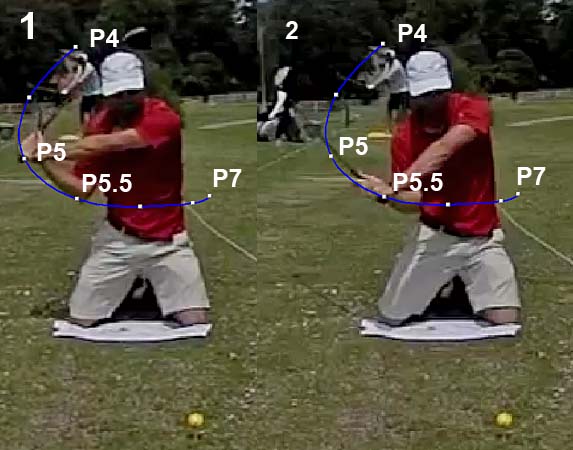
The blue curved line represents his hand arc path and one can see that it is possible to generate a good quality hand arc path (that can generate a large amount of club-releasing power) from a kneeling position simply by rotating the upper torso and using its counterclockwise rotation to release PA#4. The white-colored P values alongside the hand arc path show where his hands are located along the hand arc path during his downswing action. Note that he can maintain a large amount of clubhead lag by P5 because his hand arc path is not "tightly" curvilinear between P4 and P5. Note that his club first starts to release between P5 and P5.5 because his hand arc path (which was directed slightly away from the target, but mainly downwards between P4 and P5) changes direction quite abruptly as it moves much more towards the target while it still continues to simultaneously move slightly downwards. The major factor causing the sudden change in direction of his hand arc path is the left arm abduction component of the release of PA#4 which moves the left arm more targetwards, rather than mainly groundwards, between P5 and P5.5.
Let's presume that Lucas Wald drives the ball 80% as far as his regular driving distance when driving from a kneeling position, does that prove that the pelvic rotation is only responsible for 20% of a professional golfer's swing power during his regular driver swing action? I think that it is far too simplistic to come to that conclusion because it is possible to compensate for a lack of pelvic rotation by simply rotating the upper torso faster than usual. Also, the percentage of swing power derived from the pelvis rotation component of the overall pivot action in a professional golfer's "real life" driver golf swing action depends on the efficacy of his pelvic rotational motion in contributing to the counterclockwise torqueing of the upper torso around a rightwards-tilted spine and I think that the pelvic rotation contribution (as a percentage measurement) will likely be much greater if a golfer maximises his efficacy of contraction of his right-sided lateral pelvic rotator muscles (like Jamie Sadlowksi and Cameron Champ). By contrast, I think that Tyler Ferrell's "shift-and-rotate" pattern of pelvic motion likely contributes far less to his overall torso's swing power contribution (via what Tyler Ferrell calls a core torso "twist" biomechanical phenomenon) because he is not maximising his use of his right-sided lateral pelvic rotator muscles that can generate an active rotary torqueing force that can actively rotate the pelvis and lumbar spine/mid-torso, and thereby contribute much more rotary torqueing power to his overall torso rotation (which includes the combined rotation of the lower torso [pelvis], the mid-torso [lumbar spine zone] and the upper torso [thoracic spine zone]).
It is equally difficult to assess how much torso-pelvic separation (dynamic X-factor) contributes to the pivot action's rotary power in terms of efficiently moving the left shoulder socket very fast in a targetwards direction between P4 and P5.5. Professional golfers vary considerably with respect to the amount of torso-pelvic separation that they generate during the early downswing between P4 and P5, and I am not convinced that a golfer should try to maximise his degree of torso-pelvic separation during that time period because it is possible for the pelvis to "out-run" the upper torso if one has an inordinate amount of spinal flexibility. This phenomenon is often seen in LPGA golfers who have a lot of spinal flexibility (often called hula hula flexibility) and who are often also very supple and lithe. I think that if the pelvis "out-runs" the upper torso, that it may actually decrease the efficacy of the pivot action's contribution to swing power and it may even cause the arms/club to get trapped behind the right hip area of the pelvis during the mid-downswing.
When I refer to a golfer's upper torso rotation (thoracic spine zone rotation), I sometimes use the terms "shoulder rotation" and "upper torso rotation" interchangeably, and I usually equate the two terms "upper torso rotation" and "shoulder rotation". However, it is actually possible to get the shoulders to move slightly faster than the upper torso's rib cage because of a golfer's ability to slide the scapula across his back independently of the rotation of his rib cage.
John Dunigan discusses this issue in the following vimeo video - https://vimeo.com/172824002
In this video, John Dunigan states that there are independent scapula motions happening at the level of the shoulders due to the fact that the scapula can move independently of the rib cage - and that these scapular motions include scapula retraction, scapula protraction, scapula elevation and scapula depression. He also talks about flexion and extension, but they are due to motions of the humeral head within the shoulder socket and they are not due to scapula motions. John Dunigan mainly focuses his attention on the right scapula, and he states that a golfer can "correct a power leak" by retracting his right scapula during his backswing action. However, it is difficult for me to understand how increasing the degree of right scapula retraction can increase swing power in a TGM swinger's golf swing action unless it somehow helps to promote a bigger left shoulder turn due to left scapula protraction - with the left shoulder socket moving farther away from the target by the end-backswing position. One can actually see that increased degree of left shoulder joint motion away from the target, due to left scapula protraction, happening in Jamie Sadlowski's backswing action (see image 1 above). I would also advise a student-golfer to be very cautious about adopting John Dunigan's suggested idea of markedly retracting the right scapula during the backswing action because it could possibly "trap" the right upper arm and right elbow too far behind the right-side of the upper torso at the end-backswing position, and that could make it more difficult to get the right elbow to move fluidly/efficiently down to its pitch right elbow position during the early-mid downswing action. I think that the right upper arm should be slightly separated away from the right shirt seam area of the right upper torso at the end-backswing position, and I think that the right elbow should be positioned more in front of the right upper body at the P4 position, rather than being too "tucked-in" behind the right upper body at the P4 position.
John Dunigan also shows this graph obtained from his mySwing 3-D system in his video presentation.
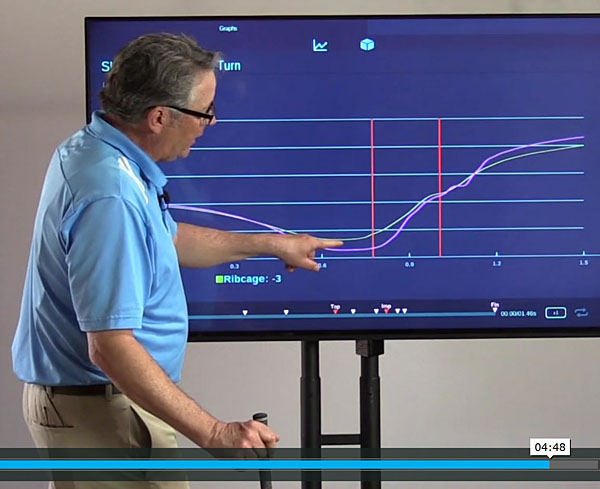
The vertical pink line represents the end-backswing position while the
thicker vertical red line represents the impact position. The blue graph
line represents the rate and direction of rib cage rotation during the
swing, while the violet graph line represents the rate and direction of
shoulder rotation during the swing. In the photo, John Dunigan is pointing out how the graphs
separate during the later backswing due to the biomechanical combination of
right scapula retraction and left scapula protraction that causes the
shoulder sockets to rotate more clockwise than the upper torso's rib cage.
Note that the gap between the two graphs narrows during the early-mid downswing
due to right scapula protraction combined with left scapula retraction.
Also, note
that Jamie Sadlowski's left scapula retracts between P4 and P5 (see
image 3 above), and that causes his left
shoulder socket's range of motion in a targetwards direction to be slightly
greater during the early downswing's P4 => P5 time period. Whether this
increased range of targetwards motion of the left shoulder socket during the
early downswing can increase the speed of release of PA#4 is unknown, but I
am willing to accept the generic "idea" that left scapula retraction during
the early downswing should be considered to be a biomechanical movement that
could potentially increase swing power to a small degree in a TGM swinger's
action.
I previously stated that it is best to think of the release of PA#4 (release of the left arm) as happening in a three dimensional space, where the left arm not only moves targetwards, but also downwards (groundwards). The targetwards motion of the left arm happens secondary to the left arm's abduction-motion, while the groundwards motion is due to the left arm's downwards-motion - with both of these motions happening simultaneously during a PA#4 release action. However, when you look at Jamie Sadlowski's hand arc path, you will note that his left hand moves slightly farther away from the target between P4 and P4.5. Why does the left hand move further away from the target at the start of the early downswing?
Consider yet again these capture images of Jamie Sadlowski's early downswing action.

Note that Jamie Sadlowski's left hand is vertically positioned above his
head at his end-backswing position (image 1) when his left arm is at the 12
o'clock position, and that it then moves well to the right of his head at
the P4.5 position (image 2). This indicates that his left hand is moving away
from the target between P4 and P4.5. But what is causing that motion of his left
hand away from the target at the start of his downswing
action?
In a video called "Ideas About the Release", Brian Manzella demonstrates his recommended "out-toss maneuver".
Here are capture images from the video showing Brian Manzella demonstrating his "out-toss maneuver".
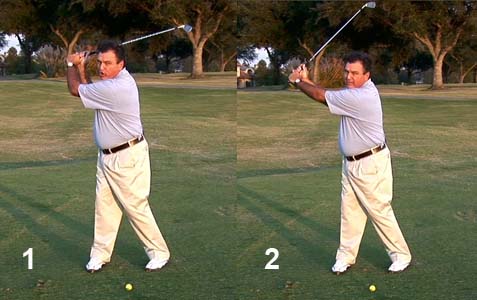
Image 1 shows Brian Manzella at his end-backswing position with a slightly
bent left arm.
Image 2 then shows Brian Manzella straightening his left arm by pushing his left hand outwards away from his body (and away from the target) - as a result of a deliberate straightening action of his bent right elbow. I think that his right elbow straightening action is an "artificial maneuver" that has no value, and it has the great disadvantage that a premature right elbow straightening action can possibly lead to casting and a premature release of PA#2 if the right hand pushes against the aft side of the clubshaft below the coupling point.
I think that there is a simple explanation that can easily explain why Jamie Sadlowski's left hand moves farther away from his head, and the target, between P4 and P4.5 - and it has nothing to do with an artificial "out-toss maneuver".
When Jamie Sadlowski is at his end-backswing position, his left arm is near-vertical, and it is at the 12 o'clock position relative to his left shoulder socket (image 1). During the P4 => P5 time period he is lowering (depressing) his left arm in his left shoulder socket and that must cause his left hand to automatically/naturally move farther away from the target so that it is much farther away from the target when his left arm becomes progressively more parallel to the ground - note how far his left hand is away from his head in image 3 when his left arm is horizontal relative to the ground (and therefore at the 9 o'clock position relative to his left shoulder socket). Although his left hand has moved away from his head in a horizontal direction between P4 and P5 as a result of lowering (depressing) his left arm, it has not moved his left hand equally far away from the target during that same time period. Why? To correctly answer that question, you must take into account the fact that his left shoulder socket is simultaneously moving targetwards by ~15" during that same left arm-lowering time period - as a result of the counterclockwise rotation of his upper torso that is happening between P4 and P5.
So, look again at these capture images of Jamie Sadlowski's early downswing action.

Image 1 is at his end-backswing position (P4 position). Note that his hands
are vertically above his left shoulder socket (see green circle marker)
because his left arm is at the 12 o'clock position relative to his left
shoulder socket. If he then lowered his left arm so that it became parallel
to the ground at his P5 position (image 3) while keeping his left
shoulder socket in the same position as the green circle marker,
then the extra distance that his hands would be further away from the target
would be equal to the length of his left arm. However, his left shoulder
socket has moved targetwards between P4 and P5 in his "real life" golf swing
action and it is now at the blue circle marker position at his P5 position.
That means that the extra distance that his left hand has moved further away
from the target between P4 and P5 is equal to the length of his left arm
minus the length of the
distance between the green circle marker and the blue circle marker.
What biomechanical actions cause Jamie Sadlowski's left arm to lower (depress) during the P4 => P5 time period?
I believe that three biomechanical phenomena play a role in Jamie Sadlowski's left arm-lowering action that happens during his early downswing.
First of all, when Jamie Sadlowski's upper torso rotates counterclockwise around his rightwards-tilted thoracic spine, thereby causing his left shoulder socket to move targetwards, it produces a targetwards pull on the left arm because the left humeral head must move along with the left shoulder socket. Because Jamie Sadlowski's left arm is near-vertical at the P4 position, the pulling motion due to the targetwards motion of the left shoulder socket passively pulls the left arm downwards as well as targetwards. Secondly, I can well imagine that Jamie Sadlowski is activating his left shoulder girdle muscles (eg. left latissimus dorsi muscle) and that its isotonic muscular contraction can synergistically assist him in lowering (depressing) his left arm. Thirdly, I can readily imagine that Jamie Sadlowski's right palm may be applying a certain amount of push-pressure against pressure point #1 (PP#1), which is located at the base of the left thumb, in a downwards direction when he actively adducts his right arm during the early downswing's P4 => P5 time period.
Here is an image showing PP#1, PP#3 and the position of the coupling point.
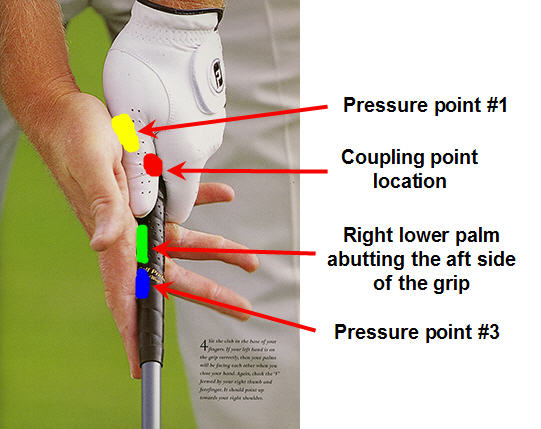
The coupling point (red dot) is a point on the club handle
that is midway between the two hands and if the golfer adopts a baseball
style grip, where the two hands are not overlapping, the coupling point is
located just below the position of the left hand's left 2nd knuckle, and the
entire right hand will be positioned below the coupling point. However, many
professional golfers adopt a Vardon, or overlapping, grip style (rather than
a baseball grip style) and that means that the right hand is positioned
further up the grip in such a manner that the base of the right palm abuts
against the base of the left thumb at PP#1 (yellow area). That means that
any push-pressure being applied by the right palm is primarily being applied
above the coupling point against PP#1, and it is not
mainly being applied against the aft side of the club handle below the
coupling point. Any push-pressure being applied by the lower right palm, or
right index finger, is being applied against the aft side of the club handle
below the coupling point, and it can predispose to a
casting-flipping motion of the clubshaft if it is wrongly applied during the
early downswing action.
Note that Jamie Sadlowski actively adducts his right upper arm during his early downswing between P4 and P5, while maintaining an unchanging bent right elbow and unchanging bent right wrist, and I can readily imagine that his right palm could be applying a certain amount of push-pressure against PP#1 in a partially groundwards direction, and that this push-pressure could synergistically help him to efficiently lower (depress) his left arm during his PA#4 release action. Unfortunately, it is unknown how much push-pressure is being exerted by the right palm against PP#1 during the early downswing in professional golfers, because no golf researchers have placed pressure sensors at PP#1 and PP#3 in order to study this phenomenon.
Let's look again at Jamie Sadlowski's left arm motion happening between P5 and P5.5.

Note the position of Jamie Sadlowski's hands at the P5 position (point 2)
and at the P5.5 position (point 3). Note that his hands have moved
both targetwards and also downwards between P5 and P5.5 secondary to the release of PA#4.
As such, the left arm moves both downwards (due to the "left arm
depression" component of the PA#4 release action) and targetwards (due to
the "left arm abduction component" of the PA#4 release action).
However, there is much more downward movement of his hands, than targetwards
movement of his hands, so that his hands get down to below the level of his
waist by the P5.5 (position point 3). Note that his hand arc path crosses his right
thigh at the level of his right mid-thigh, which is well below waist level.
Now, let's consider some possible biomechanical factors that may allow a golfer to get his hands below waist level by his P5.5 position.
I previously stated that a major source of swing power in a TGM swinging action is derived from the pivot-induced release of PA#4, and I asserted that the degree of pivot-induced PA#4 releasing power probably correlates with the range, and speed, of motion of the left shoulder socket between P4 and P5. I still think that the left shoulder socket's motion in a targetwards direction is particularly effective in moving the left arm in a targetwards direction (left arm abductory direction) so I can imagine that it is the primary source of swing power for the horizontal component of the PA#4 release phenomenon. I also stated that the targetwards motion of the left shoulder socket between P4 and P5 can depress (lower) the left arm if the left arm is angled upwards to the 11 - 12 o'clock position at the P4 position. However, I now increasingly suspect that the left and right shoulder girdle muscles play a much more important role. Also, I now think that the downward component of the PA#4 release phenomenon is much more important in generating clubhead speed than the horizontal component, which represents a new development in my thinking regarding how to optimise the "release of PA#4" in order to maximise swing power. For example, look at the shape of Jamie Sadlowski's hand arc path between point 1 (P4 position) and point 3 (P5.5 position), and note that it is mainly directed downwards (groundwards) and that there is significantly less targetwards motion of the hands between point 1 and point 3 (note that point 3 is not closer to the target than point 1). I now increasingly think that a TGM swinger's left arm speed between P4 and P5.5 mainly correlates with the speed of left hand motion in a more vertical direction towards the ground, and that there is potentially a great advantage by having the arms in a "high position" at the P4 position because it increases the range-of-length of the P4 => P5.5 hand arc path in a more vertical direction. That increased range-of-motion in a vertical direction can potentially increase swing power if the golfer has the muscle power, and optimised swing technique, to maximally move his hands very fast down the hand arc path between P4 (point 1) and P5.5 (point 3). I now also think that by moving point 3 on the hand arc path (hand position at P5.5) to a lower position that is closer to the ground, that it can potentially increase a golfer's ability to maintain clubhead lag for longer and it can also potentially speed up the release of PA#2 between P5.5 and P6 because it will create a "tighter" (more abrupt) turn of the hand arc path between P5.5 and P6. To test my new hypothesis, let's evaluate the hand arc paths of some PGA tour golfers who have the reputation of driving the ball very far.
Let's first look at Dustin Johnson's hand arc path.
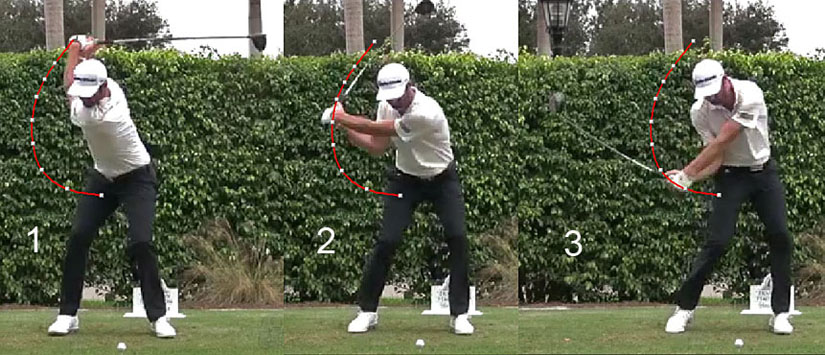
Image 1 is at P4, image 2 is at P5 and image 3 is at P5.5. The red splined
line represents his hand arc path.
Note that Dustin Johnson's hand arc path is very vertically-oriented relative to his swingplane and that there is long downward distance that his hands travel along between P4 and P5.5. Also, note that his hands are not closer to the target at P5.5 than they were at P4, which means that his hands do not move significantly targetwards during his early-mid downswing.
What causes his hands to move very fast between P4 and P5? I think that a significant factor is the fast speed of motion of his left shoulder socket in a targetwards direction that pulls the left humeral head in the same direction. If the left humeral head moves targetwards very fast between P4 and P5, it must exert a considerable downward pull on the left arm because his left arm is angled upwards to the 12 o'clock position at his P4 position. However, note that Dustin Johnson maintains an unchanged degree of right elbow bend between P4 and P5 and his right elbow is dropping in a groundwards direction very fast due to an active right arm adduction maneuver. I can readily imagine that his right palm, which is moving downwards very fast between P4 and P5, could be applying a certain amount of push-pressure against PP#1 (which is located over the base of his left thumb), thereby synergistically helping him to move his left hand (which is pulling the club handle) in a groundwards direction at an optimally fast speed.
What causes his hands to continue to move very fast between P5 and P5.5? The left shoulder socket is now moving upwards, rather than targetwards, and therefore I do not think that it is contributing more swing power to the release of PA#4, which is now happening between P5 and P5.5. I strongly suspect that the continued muscular contraction of his shoulder girdle muscles (particularly the right, and left, latissimus dorsi muscles) are the major swing power sources that cause his hands to continue to move very fast between P5 and P5.5.
Note that Dustin Johnson maintains a bent right elbow and bent right wrist down to P5.5 and that allows him to more efficiently retain clubhead lag for longer (although his club is starting to release a little as his hands get closer to the P5.5 position). Note that his hands are below waist level at P5.5, and that his hand arc path after P5.5 is more horizontal. That means that there is going to be a "tighter" turn (more abrupt turn in his hand arc path) between P5.5 and P6, which is very desirable when it comes to releasing PA#2 with greater efficiency and speed (according to the D'Alembert principle).
Now, let's consider Cameron Champ's hand arc path.
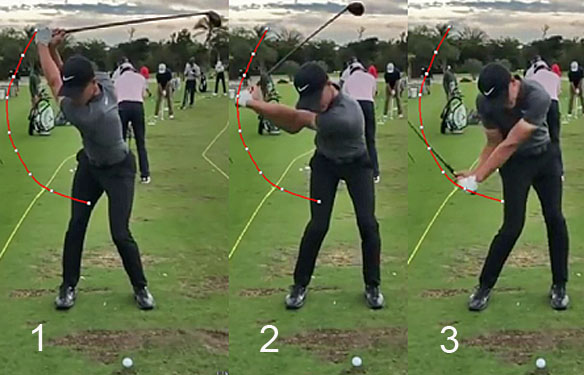
Image 1 is at P4, image 2 is at P5 and image 3 is at P5.5. The red splined
line represents his hand arc path.
Note that his hand arc path between P4 and P5.5 looks
nearly identical to Jamie Sadlowski's and Dustin Johnson's hand arc path and
that there is long vertical distance that his hands travel down between P4
and P5.5. However, note that his hands are not closer to the target at P5.5
than they were at P4, which means that the hands do not move significantly
targetwards during his early-mid downswing. Note that his hands are well
outside his right thigh at his P5.5 position.
What causes his hands to move very fast between P4 and P5? I think that a significant factor is the fast speed of motion of his left shoulder socket in a targetwards direction that pulls the left humeral head in the same direction. If the left humeral head moves targetwards very fast between P4 and P5, it must exert a considerable downward pull on the left hand because his left arm is angled upwards to the 12 o'clock position at his P4 position. However, note that Cameron Champ maintains an unchanged degree of right elbow bend between P4 and P5 and his right elbow is dropping in a groundwards direction very fast due to an active right arm adduction maneuver. I can readily imagine that his right palm, which is moving downwards very fast between P4 and P5, could be applying a certain amount of push-pressure against PP#1 (which is located over the base of his left thumb), thereby synergistically helping him to move his left hand (which is pulling the club handle) in a groundwards direction at an optimally fast speed. Note that he has not yet released PA#4 very much in a left arm abductory direction between P4 and P5.
What causes his hands to continue to move very fast between P5 and P5.5? The left shoulder socket is now moving upwards, rather than targetwards, and therefore I do not think that it is contributing more swing power to the release of PA#4, which is now happening between P5 and P5.5. I strongly suspect that the continued muscular contraction of his shoulder girdle muscles (particularly the right, and left, latissimus dorsi muscles) are the major swing power sources that cause his hands to continue to move very fast in a downwards direction between P5 and P5.5.
Note that Cameron Champ does not get his right elbow in front of his right hip area at P5.5 (as well as Dustin Johnson), but he does get his hands well below the level of his waist at P5.5. In fact, his hands are closer to the ground than Dustin Johnson's hands at the same P5.5 position. From that P5.5 position, his hands are going to start traveling more horizontally towards the target and that abrupt change in hand direction between P5.5 and P6 will induce his release of PA#2 with great efficiency and speed.
Now, let's consider Jon Rahm's hand arc path.
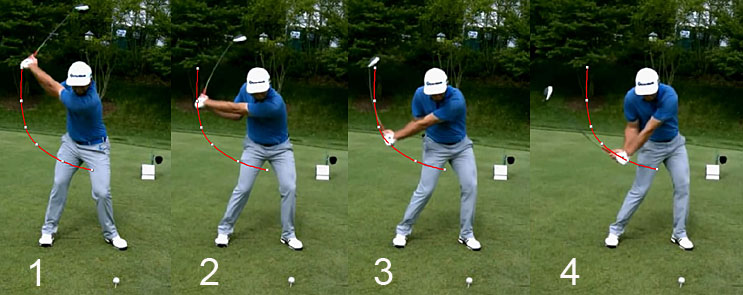
Image 1 is at P4, image 2 is at P5, image 3 is at P5.25 and image 4 is at P5.5.
What is amazing about Jon Rahm is that he is a surprisingly long driver of a golf ball - even though he has a much-shortened backswing action where his left arm only gets back to the 10 o'clock position at his P4 position (image 1).
Note that his hands are moving vertically downwards between P4 and P5, and it continues to move mainly downwards between P5 and P5.25. Note that Jon Rahm does not have the transition phase where the hand arc path is directed slightly away from the target at the very start of the downswing, and the reason for this is that his left arm is positioned at 10 o'clock, and not at 12 o'clock, at his P4 position. Note that Jon Rahm only rotates his upper torso about 70 degrees clockwise during his backswing and he therefore does not generate much left shoulder socket motion in a targetwards direction between P4 and P5.25 and I therefore suspect that his left shoulder's targetwards motion between P4 and P5.25 may not be the major causal factor that causes his hands to move very fast downwards along his hand arc path. In other words, although Jon Rahm has a very fast pelvis and upper torso rotation happening during his early downswing, it may not be the major factor responsible for his obviously very fast left hand speed that is happening mainly in a downwards direction during his early-mid downswing action between P4 and P5.5. I strongly suspect that his shoulder girdle muscles (both left and right) could be his major swing power sources that move his hands very fast down his hand arc path between P4 and P5.5 - and they could be considered to the major swing power source for the vertical component (left arm depression component) of his PA#4 release action while his upper torso's rotation is likely to be the major swing power source for the transverse component (left arm abductory component) of his PA#4 release action.
Note that he gets his hands well below waist level by P5.5 (just like Cameron Champ). Note how he maintains an unchanging bent right elbow all the way to P5.5 and his right elbow is well positioned in a pitch elbow location at P5.5. That allows him to retain clubhead lag for longer, and he is also well positioned at the P5.5 position to release PA#2 very efficiently and fast between P5.5 and P6.
Now, let's cover an interesting observation about Jon Rahm's left arm motion during his downswing action that may never have been previously discussed.
Consider Phil Cheetham's discussion of the kinematic sequence frequently seen in professional golfers - http://www.mytpi.com/articles/biomechanics/the_linear_kinematic_sequence
Here is a copy of his rotational kinematic sequence graph that he featured in that article.
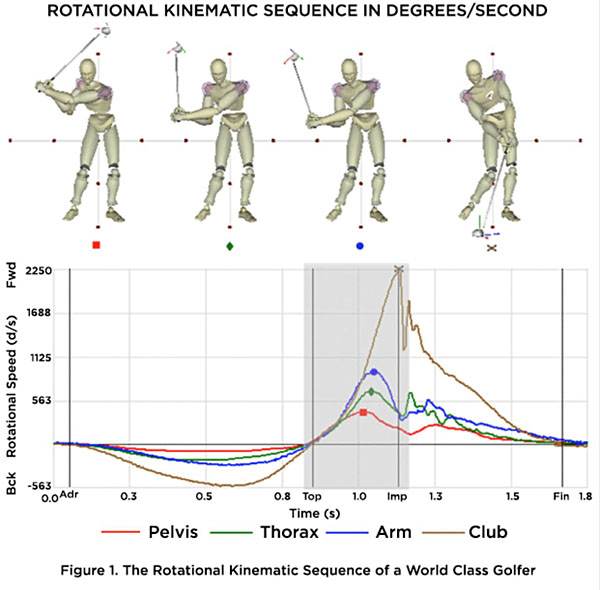
Note that the pelvis, thorax and left arm graphs have the same rotational speed during the early downswing, and if you look at the slope of the graphs during the early downswing they appear to be identical. As the downswing proceeds, the slope of the left arm graph (blue graph line) gets steeper, which means that the left arm is now moving faster than the thorax (green graph line).
To get a better look at the early downswing (when the three graphs are seemingly on the same slope line), I found this other TPI-produced image.
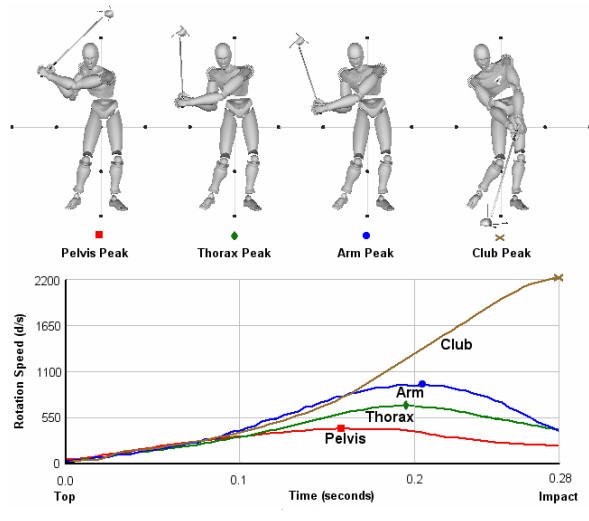
Note that the three graphs (pelvis, thorax and left arm) are superimposed on
each other during the first 0.1 seconds of the downswing. Note that the left
arm graph separates from the thorax graph after 0.1 second and it becomes
marginally steeper than the thorax graph between the 0.1 - 0.2 second time
period of the early downswing. This kinematic sequence pattern is actually
expected in a pivot-induced TGM swinging action where the pivot starts
happening between P4 and P5 (or even before P4 in some professional golfers)
and where PA#4 is only released when the golfer gets closer to the P5
position. When PA#4 first starts to release, the left arm will obviously
travel faster than the thorax as it is catapulted away from the body.
Here is a link to a you-tube video - https://www.youtube.com/watch?v=P9ddiGd_xUQ - where the TPI "experts" Greg Rose and Dave Philips analyse Jon Rahm's golf swing action.
Now, let's examine Jon Rahm's kinematic sequence graph (which I copied from that TPI video).
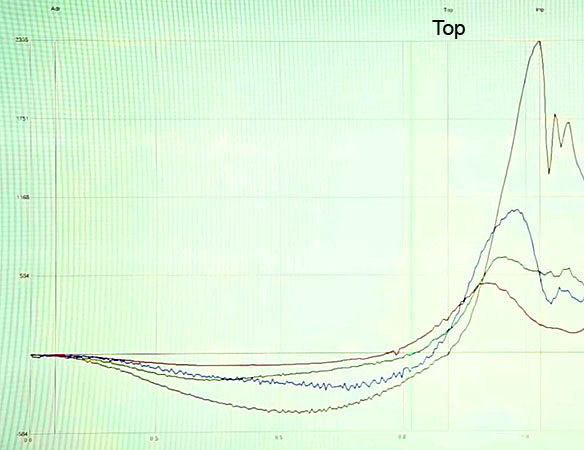
The vertical line under the word "top" represents the start of the
downswing. The red graph line represents pelvis motion. The green graph line
represents thorax motion. The blue graph line represents left arm motion.
Note that the pelvis starts to rotate counterclockwise during the late backswing (before the P4 position) so that the pelvis is rotating faster than the thorax at the start of the downswing. That phenomenon increases Jon Rahm's dynamic X-factor, which many golf instructors believe is a desirable phenomenon. However, that degree of torso-pelvic separation is not unusual in a professional golfer.
Note that his left arm and thorax are rotating at the same speed at the P4 position, and therefore at the very start of the transition to the downswing. However, note that the blue graph line (representing left arm motion) immediately becomes much steeper than the green graph line (representing thorax motion), which means that the left arm is accelerating much faster than the thorax from the very beginning of his downswing. This observation suggests to me that his left arm is not being exclusively pulled downward-and-forward by the pivoting thorax via the left arm's attachment to the upper torso at the left shoulder socket, and that it is moving somewhat independently, and faster, than the left shoulder socket. This observation suggests to me that his left arm's downward motion at the start of his downswing is mainly being powered by his shoulder girdle muscles (both right and left) that are both causally responsible for moving the left arm in a mainly downwards direction between P4 and P5.25 (as seen in Jon Rahm's hand arc path image) and that it is not primarily due to the pivot action's counterclockwise rotation of the upper torso that passively pulls the left arm around the body via the left arm's connection to the upper torso at the left shoulder socket. It also suggests to me that the peak speed of his left arm motion (which probably happens at ~P5.5) will probably better correlate with the efficiency/speed of contraction of his shoulder girdle muscles rather than the efficiency/speed of rotation of his pelvis and upper torso.
A very pertinent question arises if I am postulating that Jon Rahm may be powering the vertical (downwards) component of his PA#4 release action via an active right arm adduction maneuver that causes him to apply push-pressure against PP#1 and the aft side of the adjacent club handle between P4 and P5.5 - and that question is whether Jon Rahm could be a right arm swinger who actually powers the golf swing via a right arm swinging action rather than via a pivot-induced TGM swinging action (lead arm swinging action)?
Here is another view of Jon Rahm's early-mid downswing action.
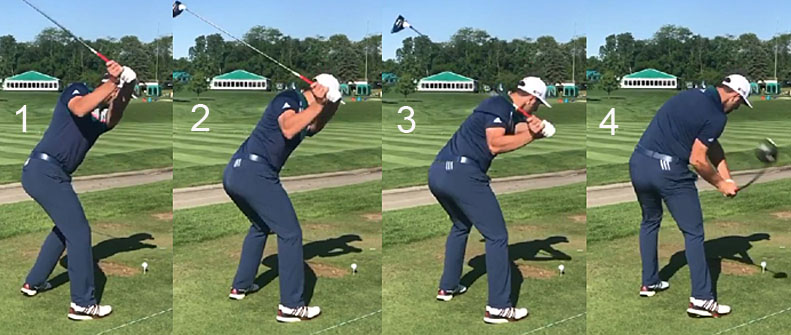
Image 1 is at P4, image 2 is at P4.5, image 3 is at P5 and image 4 is at
P5.5.
One can clearly see that Jon Rahm is actively adducting his right arm between P4 and P5.5 and that he is using a right elbow pitching pattern of right arm motion (side-arm type of right arm throwing motion) during that early-mid downswing time period. Note that he is also seemingly actively rotating his pelvis and upper torso counterclockwise during that time period and I suspect that it causes a targetwards motion of his left shoulder socket between P4 and P5.5 that pulls his left arm both downwards (in a "left arm depressing" direction) and targetwards (in a "left arm abductory" direction). However, I imagine that the golf instructor, Tony Luczak (of Reactionary Golf), could look at those same capture images and suggest that Jon Rahm is actually using a right arm swinging action and a reactive pivot action. So, how can one resolve this dilemma?
Tony Luczak of Reactionary Golf believes that most PGA golfers are using a right arm swinging action - in contrast to my "belief" that they are using a pivot-induced TGM swinging action. What is the scientific basis for Tony Luczak's opinion that most professional golfers are using a right arm swinging technique, where swing power is applied entirely via a right arm swinging motion? Tony Luczak's thinking is summarised in the following paper at https://www.bebettergolf.net/home/tony-luczak-making-the-case-for-a-right-arm-lead-motion .
Here is an extract from Tony Luczak's paper-: "The development of a clearer understanding of proximal-to-distal sequencing has been described by Putnam (1993) as “the distal segment is subsequently accelerated forward primarily by the interactive moment resulting from the angular velocity of the proximal segment and by the joint moment at the proximal end of the distal segment”, which when applied to the golf swing is the right arm (right handed golfer) begins its acceleration from the proximal musculature of the brachium performing adduction and internal rotation (shoulder joint), antebrachium extending (elbow joint) , and hands moving from extension to flexion and deviation (wrist joints) in the forward and acceleration phases of the golf swing. Thus, the movement of the torso minimally contributes to the velocity of the arms and its role is to position the proximal segment (arms) to create alignments allowing distal end segments to move at high speeds based on their muscular activation (Putnam, 1993)".
Note that Tony Luczak is suggesting that the right arm is mainly responsible for powering the golf swing and that the "movement of the torso minimally contributes to the velocity of the arms and its role is to position the proximal segment (arms) to create alignments allowing distal segments to move at high speeds based on their muscular activation".
To further elaborate on his conviction that the golf swing is powered by the right arm, Tony Luczak provides "evidence" based on EMG (electromyography) studies, and he makes the following statements in his paper-: "The use of electromyography (EMG) may offer additional insight into the neuromotor mechanisms that drive the golf swing. EMG evidence that the arms are a main contributor to forward and acceleration phase control has been reported by Jobe, Perry, & Pink (1989) study of 6 men and 7 women professional golfers in that both male and female golfers reported combined right pectoralis major (PM) activation of 64% and left PM 18% during the forward swing and increasing to 93% PM bilaterally during the acceleration phase as a percentage of their manual muscle test. Evidence that the right arm plays a key role in delivering the golf club is that the pectoralis major is the most active than any other muscle tested by Pink, Jobe, & Perry (1990), which provides power to the swing through adduction and internal rotation. These findings seem to indicate that golf instructional methodologies need to be reassessed and possibly be based on learning strategies that mimic proper muscle activation patterns not just kinematic observation."
Note that Tony Luczak justifies his conclusion that the right arm powers the golf swing by stating that EGM studies show that the right pectoralis muscle is the most active of any of the muscles tested by Pink, Jobe and Perry, and that it provides power to the swing motion through right arm adduction and internal rotation.
Do Tony Luczak's observations and conclusions make any sense?
First of all, let's look at the results of Jobe's EMG study on shoulder girdle area muscles.
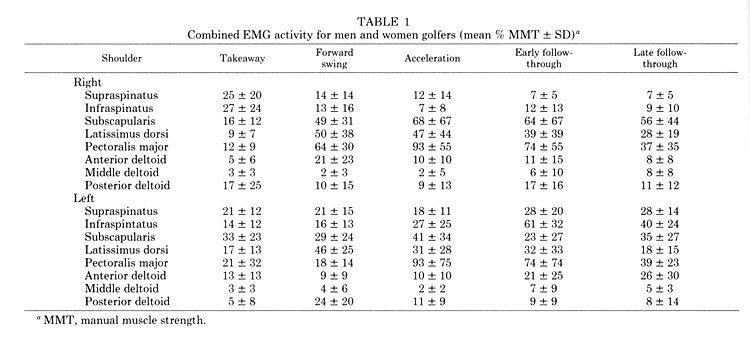
Note that Jobe uses the term "forward swing" for the P4 => P6 time period of the downswing and the term "acceleration" for the P6 => impact time period of the downswing.
Note that the right pectoralis muscle reaches its peak EMG activity between P6 and impact. That is fully expected in both right arm swingers and TGM swingers (like Dustin Johnson) because that is when the right upper arm is being maximally adducted across the front of the rotating torso. However, swing power is actually being generated between P4 and P6 in both right arm swingers and left arm swingers. Note that the most active right shoulder girdle muscles during that P4 => P6 time period are the right subscapularis muscle (which pulls the right arm downwards), the right latissimus dorsi muscle (which pulls the right arm downwards and also adducts the right arm towards the right side of the torso) and the right pectoralis muscle (which adducts the right arm towards the right side of the torso). What does this EMG data suggest? The data only suggest that the right arm is being actively adducted towards the right side of the torso between P4 and P6 in most professional golfers who efficiently get their right elbow down to a pitch location alongside the right hip area by P6. However, that doesn't prove that a professional golfer is solely using a right arm swinging action because TGM swingers (lead arm swingers) are also going to be actively adducting their right arm between P4 and P6 in order to i) more efficiently shape their hand arc path by increasing the efficiency/speed of the downward-component of their PA#4 release action (as I demonstrated when I analysed the hand arc path of the driver swings of Jamie Sadlowski, Dustin Johnson, Cameron Champ and Jon Rahm) and ii) to optionally shallow the clubshaft (as described in topic number 3). Therefore, I believe it is impossible to conclude that EMG data of the right-sided shoulder girdle muscle can differentiate the difference between right arm swingers and TGM swingers who use an active right arm adduction maneuver during their early-mid downswing.
I believe that if golf researchers want to more clearly differentiate between professional golfers who use a right arm swinging action from professional golfers who use a TGM swinging action that is combined with an active right arm adduction maneuver, then they need to perform the following type of golf research study. They first need to place pressure sensors at PP#1, PP#3 and on the aft side of the club handle adjacent to those two pressure points so that they can accurately measure the amount of push-pressure being exerted by the right hand during all phases of the downswing. Secondly, they also need to place strain gauges into the butt end of the club handle (where the left hand grips the club handle) so that they can accurately measure the amount of torque being exerted in the X, Y and Z planes by the left hand (which is pulling the club) during all phases of the downswing. I predict that right arm swingers will be exerting a large amount of push-force with their right hand and a minimal-to-small amount of left hand pulling torque during the P4 => P6 time period - while TGM swingers (who use an active right arm adduction maneuver) will be exerting a moderate amount of push-force with their right hand and a large amount of left hand pulling torque during the P4 => P6 time period.
Going back to my analysis of Jon Rahm's golf swing, I agree with Greg Rose who believes that Jon Rahm is using an active pivot action and that his active pivot action is mostly responsible for powering his driver golf swing action by efficiently inducing the release of PA#4. I also think that Jon Rahm is using an active right arm adduction maneuver to more efficiently speed-up the vertical (downwards) component of his PA#4 release action between P4 and P5.5.
From a golf instructional perspective, I think that there is much to learn from Jon Rahm's hand arc path pattern, and I think that student-golfers (developing golfers), who want to learn how to perform a TGM swinging action (like Jon Rahm), should realise that they must not only think of rotating their upper torso counterclockwise as fast as possible in order to catapult their left arm towards the target as fast as possible (as if they were throwing a frisbee back-handed towards a distant target with a pivot-induced release of the lead arm) because that will produce too much left arm abductory (transverse) motion and not enough downward (vertical) motion of the left arm between P4 and P5.5. I think that a student-golfer (developing golfer), who wants to maximise his driver swing's clubhead speed, should strive to "aim" his hands more downwards during the early-mid downswing so that they can reach a position that is outside his right thigh at P5.5, and preferably also below his waist level. This recommendation even applies to golfers who have a very flat hand arc path - as seen in the golf swings of professional golfers like Rickie Fowler, Matt Kuchar and Ben Hogan.
Let's look again at these capture images of Lucas Wald swinging a driver from a kneeling position.

Note that his hand arc path must be very flat, and more around his body, due to the fact that his left shoulder socket is much closer to the ground. In other words, his hand arc path must be more like a merry-go-round, than a ferris-wheel, with respect to its orientation relative to the ground.
Note that his hands are positioned outside his right shoulder area at the P4 position. Note that his hands are positioned outside his right torso at the P5.5 position and that they are not closer to the target than they were at the P4 position. Note that he is releasing PA#4 between P5 and P5.5, but he is not excessively abducting his left arm between P5 and P5.5 and his hands are actually moving more downplane (in a direction that is more towards the camera and ball-target line than the target) between P5 and P5.5. How does he achieve that goal? I suspect that performing an optimal motion of the right arm during the P4 => P5.5 time period plays an important role in moving the hands more downplane, and less targetwards, between P5 and P5.5 - and that right arm motion includes the biomechanical combination of an active right arm adduction maneuver where the right elbow leads the hands and where the right elbow is actively driven to its pitch location near, or in front, of the right hip area while maintaining a bent right elbow and bent right wrist and also a supinated right forearm so that the right palm can be under the club handle at P5.5.
To expand on my personal observations expressed in the last paragraph, consider this comparison between David Toms' driver swing action versus Cameron Champ's driver swing action.
Capture images of David Tom's early-mid downswing - as seen from a face-on perspective.
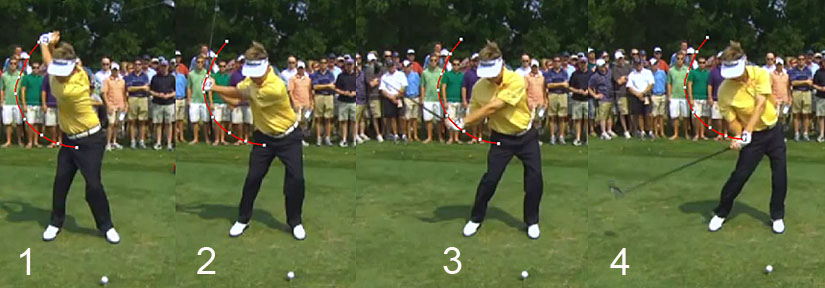
Image 1 is at P4, image 2 is at P5, image 3 is at P5.5 and image 4 is at the
P6.2 position.
At first glance, his hand arc path looks very similar to Cameron Champ's hand arc path, although if you look carefully you will note that it is more circular-shaped while Cameron Champ's hand arc path is more oval-shaped with the long axis being more vertically-aligned relative to the ground. Note that David Toms does get his hands down to a position that is well outside his right torso at his P5.5 position. However, note that his hands at P5.5 are above his waist level, and they are far higher than Cameron Champ's hands are at his P5.5 position. Also, note that his right elbow is positioned well away from the right hip area at his P5.5 position, while Cameron Champ's right elbow is abutting his right hip joint area at his P5.5 position.
Note that David Toms loses his clubhead lag very early in his downswing and that he releases PA#2 far too soon - despite the fac" that he appears to be adducting his right arm towards the right side of his torso between P4 and P5.5, and despite the fact that his right elbow is still fully bent at his P5.5 position. I think that David Toms has a relatively inefficient release of PA#2 and this may be a major reason why he cannot drive the golf ball as far as Cameron Champ (or Dustin Johnson or Jon Rahm). To better understand the differences between David Toms' early-mid downswing action versus Cameron Champ's early-mid downswing action, it is very instructive to look at comparative DTL capture images of their early-mid downswing action.
DTL capture images of David Toms' driver golf swing action.
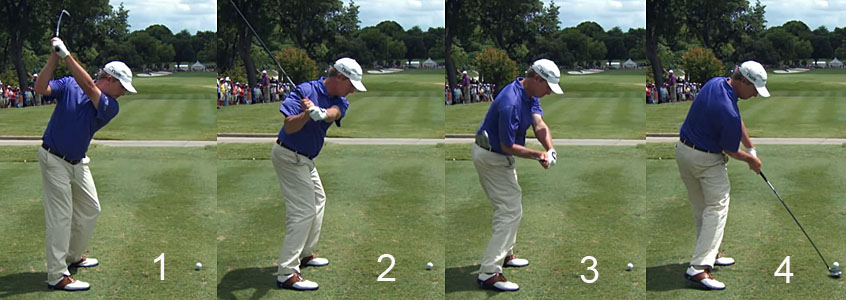
Image 1 is P4, image 2 is at P5, image 3 is at P5.5 and image 4 is at
impact.
Note that David Toms has "high hands" at his P4 position.
Note that David Toms has rotated his pelvis and upper torso counterclockwise between P4 and P5. However, at the P5 position (image 2), note that his right elbow is alongside his right shirt seam and his hands are much closer to the ball-target line than his right elbow.
Note that his pelvis and upper torso are relatively square to the ball-target line at his P5.5 position (image 3). Note that he has not rotated his pelvis more open between P5 and P5.5. Note that his shoulder sockets are nearly level, and his right shoulder socket is only marginally closer to the ground than his left shoulder socket. Note that his right elbow is still alongside his right shirt seam at the P5.5 position, and it appears to be well above his right hip joint area. Note that his hands are marginally above his waist level at P5.5, which explains why his right forearm is horizontal to the ground and not angled more downwards towards the ground at his P5.5 position.
Image 4 shows David Toms at impact with an open pelvis and slightly open upper torso. Most interestingly, note that his right elbow is still positioned alongside his right shirt seam at impact and his right elbow has not bypassed his right hip area between P5.5 and impact. This suggests that his right elbow is not moving faster in a targetwards direction than the right side of his mid-upper torso. It also suggests that his two arms are moving targetwards between P5.5 and impact at a speed that appear to be dictated by the speed of counterclockwise rotation of his pelvis and upper torso.
Now, let's look at these DTL capture images of Cameron Champ's driver golf swing action.

I apologise for the blurred images, but I could not find a better DTL swing video that was captured in slow motion.
Image 1 is at P4, image 2 is at P5, image 3 is at P5.5 and image 4 is at impact (P7).
Note that Cameron Champ has "high hands" at his P4 position - and they are similar in position to David Toms' "high hands" position (with respect to their respective right shoulder sockets) - although Cameron Champ has more spinal bend inclination than David Toms.
Note that Cameron Champ has rotated his pelvis and upper torso counterclockwise between P4 and P5. At his P5 position (image 2), his pelvis is square, and his upper torso is closed, and he doesn't look very different than David Toms in terms of their degree of counterclockwise pelvic and upper torso rotation. Note that their hands are opposite their right chest at P5 to a similar degree. Note that Cameron Champ's right elbow has bypassed his right shirt seam at P5.5, and his right elbow looks to be under his hands, and not well behind his hands (as seen in David Toms' image 2). These observations suggest to me that Cameron Champ is adducting his right arm more actively and that he is driving his right elbow more actively downwards towards its P5.5 pitch location where his right elbow will be positioned in front of his right hip joint area.
Image 3 shows Cameron Champ at his P5.5 position. Now, we can identify a number of biomechanical differences between Cameron Champ's and David Tom's early-mid downswing action. Most importantly, note that his hands are well below waist level and that they are positioned >6" below the level of his trouser belt. That "fact" accounts for the fact that his right forearm is angled more groundwards seeing that his right elbow is also at waist level - like David Toms' right elbow at his P5.5 position (even though Cameron Champ's right elbow is positioned well in front of his right shirt seam area).
In addition, note that his pelvis much more open at P5.5 (compared to David Toms' square pelvis at P5.5) while his upper torso is more similarly square to the ball-target line (compared to David Toms' upper torso at his P5.5 position). The open pelvis alignment at P5.5 suggests that Cameron Champ is rotating his pelvis counterclockwise much more assertively between P4 and P5.5 than David Toms is rotating his pelvis during the same early-mid downswing time period. Accordingly, I believe there is a significant biomechanical benefit of having the pelvis more open than the upper torso at the P5.5 position - and that biomechanical benefit is that it allows the golfer to more easily acquire right lateral bend during the mid-downswing time period. Note that the distance between Cameron Champ's right shoulder socket and his right hip joint area is much less than the same right shoulder => right hip joint distance seen at David Tom's P5.5 position, and this is because Cameron Champ has acquired much more right lateral bend. I think that acquiring a lot of right lateral bend during the mid-downswing allows a golfer to more easily perform an efficient, and fluid, right arm pitching motion (skipping stones type of right arm throwing motion that can be classified as a side-arm throwing motion) as it gets the hands to bypass the right thigh area between P5.5 and P6.5 at a faster speed and with the hands closer to the ground. Note that Cameron Champ has also retained a lot of clubhead lag at P5.5 - while David Toms has far less clubhead lag at his P5.5 position - and I believe it is casually related to his much more efficient right arm adduction maneuver, that is combined with a very assertive right elbow pitch motion where the "right elbow leads the hands".
Image 4 shows Cameron Champ at impact. Note that he has an open pelvis and slightly open upper torso - and he looks similar to David Toms from that body alignment perspective. However, note that his right elbow has bypassed his right hip area to a large degree, which means that he is swinging his arms/club much faster than his rotating pelvis during his later downswing between P5.5 and impact. I also think that Cameron Champ enjoys a much more efficient, and faster, release of PA#2 between P5.5 and impact, compared to David Toms.
Dustin Johnson's DTL capture images show the same biomechanical features as those seen in Cameron Champ's DTL capture images.

Image 1 is at P5.5, image 2 is at P6, image 3 is at P6.5 and image 4 is at impact (P7).
Note that Dustin Johnson's right elbow is positioned in front of his right hip area at P5.5 (image 1) and note that his hands are located below his waist level. Note that his pelvis is open while his upper torso is closed. Note that his right shoulder socket is lower than his left shoulder socket and that the distance between his right shoulder socket and his right hip joint is reduced due to the presence of significant right lateral bend.
Note how his right elbow bypasses his right hip area between P5.5 and impact due to the fact that his arms/club are traveling targetwards faster than his pelvic rotation.
It is clear that both Cameron Champ and Dustin Johnson are rotating their upper torso very fast between P5.5 and impact with very little continued counterclockwise rotation of their pelvis. It makes perfect sense that a very fast counterclockwise pelvic rotation between P4 and P5.5 can contribute to the overall speed of rotation of the entire torso (lower torso + upper torso) and as it allows a golfer to more easily acquire right lateral bend during the mid-late downswing when the pelvis is more open than the upper torso during this time period. On the other hand, it makes little sense to think that a continued fast counterclockwise pelvic rotation between P5.5 and impact could increase clubhead speed, based on the premise of the kinematic sequence.
Many professional golfers generate their peak pelvic rotation measurement at some time point between P5.25 - P5.5 and then their pelvis immediately begins to slow in their later downswing.
Consider another example of that pelvic motional pattern as seen in Rory McIlroy's driver swing action.
Here are capture images of Rory McIlroy's P4 => P8 time period.

Note that Rory McIlroy rotates his pelvis counterclockwise between P4 (image 1) and P6 (image 4) so that he has a slightly open pelvis at his P6 position. Also, notice that there is essentially no more counterclockwise pelvic rotation happening between P6 (image 4) and impact (image 5), and not much more counterclockwise pelvic rotation between impact (image 5) and P8 (image 6). It is very clear that his pelvis rotation has a fast phase (early in his downswing) and a slow phase (before he reaches impact).
On the other hand, note how much he is rotating his upper torso (shoulders) counterclockwise between P6 (image 4) and P8 (image 6). Continuing to rotate the upper torso (shoulders) very fast throughout the late downswing and early followthrough can definitely contribute to increased swing power because they allow the arms/released club to use their gained momentum (acquired from an efficient release of PA#4 => PA#2) to fluidly continue to move very fast through impact in an unimpeded manner.
I will now discuss two biomechanical phenomena that
some golf instructors believe can significantly increase swing power if
they are applied during the later downswing - i) positive alpha
torque and ii) parametric acceleration.
i) Topic of positive alpha torque being applied
during the later downswing.
Brian Manzella, Michael Jacobs, and Richard Franklin are golf instructors who believe that their student-golfers should apply a positive alpha torque during the mid-downswing, first starting when the golfer reaches near the P5 position.
An alpha torque, if it is positive, is an in-plane torque that is applied at the grip handle and it causes the clubshaft to actively move downplane while remaining parallel to the swingplane. A negative alpha torque is a restraining torque that impedes the club’s actively released in-plane motion.
Here is a link to a vimeo video - https://vimeo.com/121990372 - where Brian Manzella describes the concept of a positive alpha torque between the 0:30 - 2:40 minute time point of the video.
In particular, note what he states between the 2:00 - 2:38 minute time point of the video, where he suggests that if a golfer does not start applying a positive alpha torque at about the P5 position - by pushing against the aft (back) side of the club handle with the right hand while the left hand pulls the club handle - that the club will not catch-up to the left arm by impact. In other words, Brian Manzella, does not believe that the club will automatically/naturally catch-up to the left arm due to a passive PA#2 releasing action based on the shape of the hand arc path (according to the D'Alembert principle) and he believes that a golfer must apply a positive alpha torque via the biomechanical mechanism of the right hand applying a push-force against the back of the shaft during the mid-late downswing. The premise of this golf instructional advice is derived from Steve Nesbit, who wrote an article called "Work and Power Analysis of the Golf Swing", which you can read at https://www.ncbi.nlm.nih.gov/pmc/articles/PMC3899668/ .
Steve Nesbit studied the golf swings of 4 amateur golfers (a male scratch handicap golfer, a male 5-handicap golfer, a male 13-handicap golfer and a female 18-handicap golfer) and he then used a theory-based "inverse dynamics modeling" concept to calculate the likely alpha, beta and gamma torques that those 4 golfers were producing during their downswing.
In this article, this is what Steve Nesbit stated with respect to the positive alpha torque produced by the two male golfers with the lowest handicaps.
Copy of a small section of that article containing Steve Nesbit's quote.
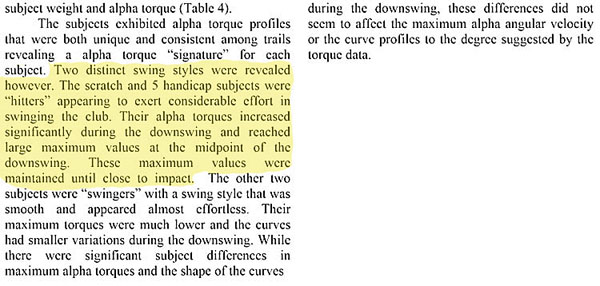
Read the yellow highlighted sentences, and note that Steve Nesbit stated
that two golfers (the scratch golfer and the 5-handicap golfer) were
"hitters", who were producing a positive alpha torque during their
downswing, where the alpha torque reached its maximum value during the
midpoint of the downswing, and where they maintained these maximum positive
alpha torque values until the clubshaft was close to impact.
Here is a copy of the alpha torque graph from Steve Nesbit's paper.
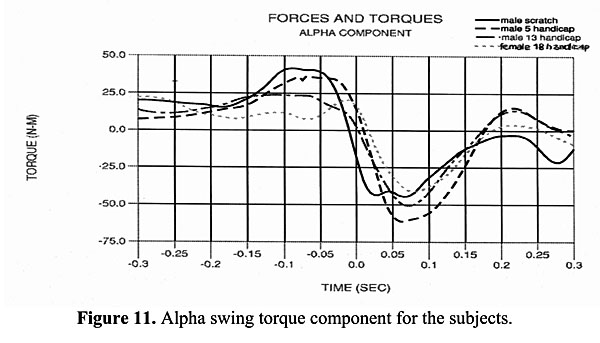
Note that the two golfers with the lowest handicap (male scratch golfer and male 5-handicap golfer) produced the largest positive alpha torque values during their mid-downswing (see "hump" at 0.1 seconds prior to impact) and note that they then maintained these high values until close to impact. From my perspective, if a golfer starts to apply a positive alpha torque during the mid-downswing by applying push-pressure with his right palm against the aft (back) side of the club handle, and if he then maintains that positive alpha torque during most of the late downswing, then he is using a swing-hitting or TGM hitting technique, and not a TGM swinging technique.
Are PGA tour professional golfers using a TGM swinging technique where the alpha torque is negative throughout the later downswing between P6 and impact, or are they using a swing-hitting technique where the alpha torque is positive during most of the late downswing and where it only decreases just prior to impact?
I am not aware of any golf researcher actually measuring any positive alpha torque being applied to the aft side of the club handle, via the right hand applying push-pressure against PP#1 or PP#3, during any golf research study. However, golf physicists (like David Tutelman) and golf biomechanists (like Sasho MacKenzie), have inferred that professional golfers are not applying a positive alpha torque during their late downswing - based on theoretical reasoning. Here is a link to an article written by David Tutelman - https://www.tutelman.com/golf/swing/nesbitKwon1.php - where he provides a detailed argument to bolster his opinion that professional golfers do not have a positive alpha torque at impact. The article is very complicated to understand, and I personally cannot understand the explanations based on mathematical calculations, but I think that the most important golf instructional element that one should try to understand are the implications of the following diagram.
Here is a copy of a diagrammatic image from David Tutelman's article.
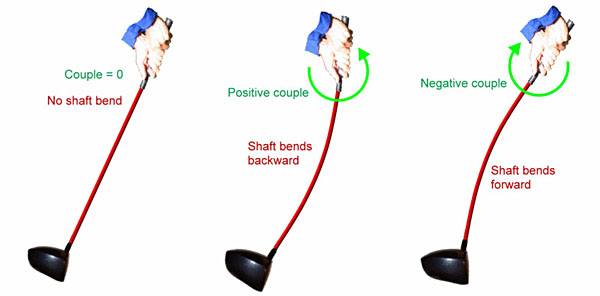
Note that if a golfer's proximal clubshaft is straight-line-aligned with his peripheral clubshaft during a golf swing action, then that means that no alpha torque (either negative or positive) is being applied by the golfer's hands at the grip handle. By contrast, if the peripheral clubshaft is bent backwards relative to the proximal clubshaft, then that implies that the golfer is applying a positive alpha torque at the grip handle. Finally, if the peripheral clubshaft is bent forward relative to the proximal clubshaft, then this means that a negative alpha torque is being applied at the club handle. Expressed differently, a negative alpha torque means that the peripheral end (clubhead end of the clubshaft) is traveling faster than the proximal end (central end) of the clubshaft and that the golfer's hands are not quite keeping up with the club, which means that a negative clockwise alpha torque will be experienced at the level of the hands.
Now, let's examine capture images from the downswing of two professional golfers.
Rory McIlroy

Image 1 is at P4, image 2 is at P5, image 3 is at P5.5, image 4 is at P6 and
image 5 is at P6.4.
I have drawn a yellow line along his proximal clubshaft.
Note that his entire clubshaft forms a straight line with that yellow line at his P4 position, which means that no alpha torque is being exerted at this time point.
Note that his peripheral clubshaft is bent back a lot at P5 and to a lesser degree at P5.5, which means that he is applying a positive alpha torque during his early-mid downswing between P4 and P5.5.
However, note that his clubshaft is marginally bent forward at P6 and significantly bent forward at P6.4 (and it remains bent forward all the way to impact). This means that the change from having a positive alpha torque to having a negative alpha torque happens around P5.5 - P6 and one can reasonably conclude that Rory McIlroy is applying a positive alpha torque during the "swing power generation phase" of his downswing between P4 and P5.5 (as a result of his pivot-induced release of PA#4 that is combined with an active right arm adduction maneuver) and that his club then releases (due to the release of PA#2) at roughly the P5.5 time point of his downswing. During his later downswing, his club is traveling faster than his hands as a result of the release of PA#2 and therefore he is not applying any push-pressure against the aft (back) side of the club handle in order to make it travel faster at any time point during his later downswing. I think that this type of swing pattern is a characteristic of a TGM swinging action, and incompatible with a swing-hitting action (as suggested by Brian Manzella).
Luke List

Image 1 is at P4, image 2 is at P5.2, image 3 is at P5.5, image 4 is at P6,
image 5 is at P6.3 and image 6 is at P6.8.
I have drawn a yellow line along his proximal clubshaft.
Note that his entire clubshaft forms a straight line with that yellow line at his P4 position, which means that no alpha torque is being exerted at this time point.
Also, note that he must be applying a positive alpha torque at P5.3 and P5.5 because his peripheral clubshaft is bent back, and that he must be experiencing negative alpha torque in his later downswing between P6 and impact because his peripheral clubshaft is bent forward at all time points between P6 and impact. In other words, Luke List (like Rory McIlroy) is likely using a TGM swinging action and not a swing-hitting action (as suggested by Brian Manzella).
It is clear to me that most PGA tour golfers are using a TGM swinging technique, and I believe that they are not applying any significant amount of push-pressure (positive alpha torque) against the aft side of their club during their late downswing between P6 and impact - in a deliberate attempt to make their clubhead travel faster.
Although a positive alpha torque in the late downswing is not appropriate for a professional quality driver golf swing action when the golfer is using a TGM swinging technique (that is based on the sequential pivot-induced release of PA#4 => passive release of PA#2), I think that it is entirely appropriate to use it for certain specialised shots like a "punch shot". Professional golfers often use a TGM hitting technique (based on the release of PA#1) for "punch shots" (eg. hitting a low flying shot out from the woods back to the fairway when they want to avoid hitting low-hanging tree branches). When using a TGM hitting action, that is powered entirely by the release of PA#1 (which is biomechanically due to an active right arm straightening action), the golfer is applying a positive push-force against the aft (back) side of the club handle with the right hand throughout the entire late downswing and into impact, which means that a positive alpha torque must be present. However, I know of no professional golfer who is using a TGM hitting action for his driver golf swing action. Is it possible that I am wrong and that certain professional golfers are using a TGM hitting technique, or a swing-hitting technique (as recommended by Brian Manzella), or a right arm swinging technique - where they are applying a positive push-force against the aft side of the club handle with their right hand during the late downswing? I could certainly be wrong, and although I think that David Tutelman has produced a strong theoretical argument that supports my personal opinion that professional golfers are likely using a TGM swinging technique, and not a swing-hitting technique, during their driver golf swing action, a theoretical argument does not represent proof! Therefore, I would very much like to see golf researchers practically test the validity of David Tutelman's hypothesis by placing pressure sensors at PP#1 and at PP#3 so that they can actually measure any push-pressure being exerted by the right hand against the aft side of the club handle at all time points during a professional golfer's downswing. I strongly suspect that this type of golf research study could yield new, and potentially useful, information from a golf instructional perspective.
ii) Topic of parametric acceleration.
Parametric acceleration of the club refers to the phenomenon where a golfer
can increase clubhead speed during the late downswing by
shortening the hand arc path's radius (shortening the hub path radius).
Here is a diagram showing what is meant by the concept of "shortening the hub path radius" in the late downswing as the club approaches impact.
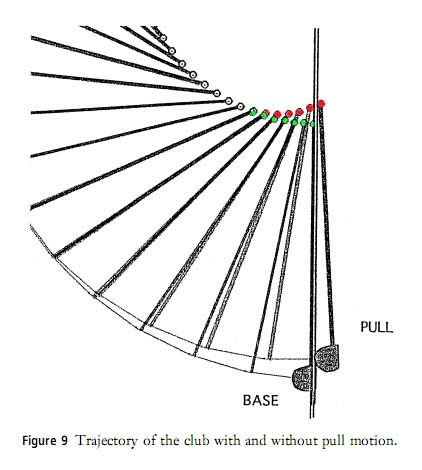
The green dots show the hand arc path in the absence of parametric
acceleration and the red dots show the hand arc path in the presence of
parametric acceleration, where the hands move slightly more upwards due to an
upwards pull motion that is secondary to an increased degree of left
shoulder socket elevation happening in the late downswing and through
impact.
What is the theoretical basis for believing that elevating the left shoulder socket, which lifts the club handle upwards in the later downswing just before impact, can increase clubhead speed? The scientific basis for the phenomenon of parametric acceleration comes from the experimental work of K Miura - see "Parametric Acceleration - The Effect of Inward Pull of the Golf Club at Impact Stage. K Miura. Sports Engineering (May 2001) 4: 75-86. Abstract available at http://onlinelibrary.wiley.com/doi/10.1046/j.1460-2687.2001.00071.x/abstract ".
Here is a copy of a diagram from his paper.
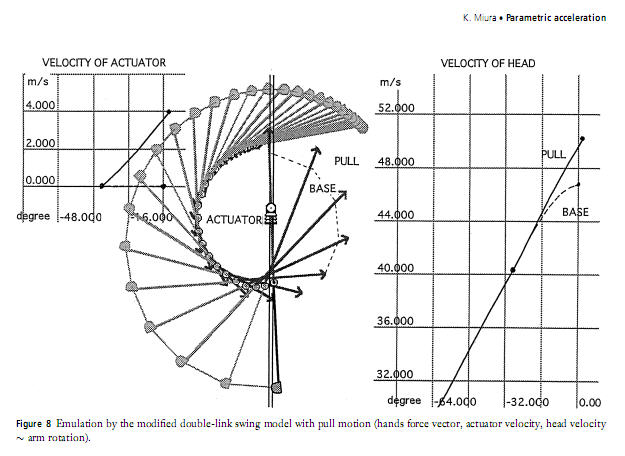
Miura modified a double pendulum model by adding a linear actuator that he situated above the central arm's torque motor, which then becomes a movable pivot (rather than a fixed pivot) if the linear actuator actively pulls the torque motor upwards during the late downswing. When he activates the linear actuator during the late downswing it pulls up on the torque motor, which in turn pulls the grip end of the club upwards to exactly the same degree (as the central arm has a fixed length).
The "velocity of actuator" graph on the left shows that he activates his linear pull actuator (in order to pull the club upwards) in the latter part of the late downswing, and the slope of the graph shows the rate of acceleration of the pulling-up action of the linear actuator. Note that the normal force arrows are increased in magnitude as a result of this added pulling-up action, which will shorten the hub radius near impact. The "velocity of head" graph on the right shows that he can get an extra 5% of clubhead speed using this maneuver. So, why is the increase in maximum clubhead velocity not greater than ~5%? The answer is related to the fact that the clubhead has already released due to a CF-release action (equivalent to a passive PA#2 release action), and it is therefore difficult to get the club to release faster if the pulling up action is superimposed on an already-released club that has already gained 80-90% of its maximum clubhead velocity by the time the pulling-up action is instituted. From a golf instructional perspective, it is important to realise that if a golfer performs the requisite biomechanical movements needed to enact a greater amount of parametric acceleration, that the potential gain of an increased clubhead speed of 5% will only occur if the ball is still struck by the sweetspot of the clubface, thereby maintaining the maximum smash factor. If the golfer pulls the club handle upwards just before impact, and misses the sweetspot, then the smash factor will likely be significantly less due to an off-center strike, and the resulting loss of ball flight distance will probably offset the potential gains that can be obtained by using the phenomenon of parametric acceleration in one's driver golf swing action. That is why I am not personally in favor of trying to eke out a small potential gain of a 5% increase in clubhead speed at impact by incorporating a large amount of the parametric acceleration phenomenon into one's driver golf swing action.
How does a golfer enact the phenomenon of parametric acceleration in his driver golf swing action from a biomechanical perspective? In other words, what "extra" biomechanical movements must he introduce into his regular driver golf swing action in order to shorten the hub radius more than usual? To get the left shoulder socket to move more upwards during the later downswing between P6 and impact, a golfer can add one-or-all of the following biomechanical movements to his regular driver golf swing action-: i) he can increase the degree of straightening of his left leg thereby increasing the degree of elevation of his left hip joint; ii) he can increasingly stretch-lengthen the left side of his mid-upper torso, iii) he can elevate his left clavicle more skywards than usual in a manner that is independent of the stretch-lengthening of the left side of his mid-torso; and iv) he can get up on his toes, or even jump-off the ground, in order to elevate his left hip joint even more just before impact.
A golfer who often manifests these "extra" biomechanical movements is Lexi Thompson.
Here is a capture image of Lexi Thompson soon after impact.
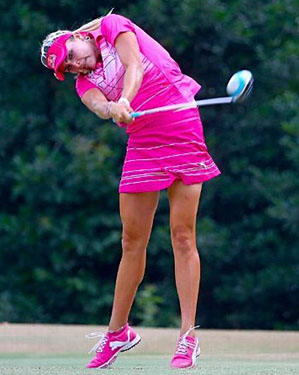
Note Lexi Thompson's i) very straight left leg at impact, which significantly elevates the left side of her pelvis; ii) the stretching-out of the left side of her upper torso, iii) the elevation of her left outer clavicle and iv) her tendency to get up onto her toes thereby lifting her heels off the ground.
If you, as a developing golfer, can consistently hit the ball on the sweetspot while performing all those "extra" biomechanical movements, then you may potentially gain up to a 5% increase in ball flight distance.
Long-drive competitors are notoriously known for "jumping-up" through impact in an attempt to gain a few extra yards of driving distance, and they are usually willing to give up the idea of simultaneously achieving the maximum degree of accuracy in order to gain those few extra yards. A good long-drive competitor who performed a "crunch down-and-then-jump up" type of exaggerated parametric acceleration swing pattern is Jason Zuback, a former world long-drive champion. He manifests an exaggerated degree of "crunching down" between P4 and P5.5 due to the use of an exaggerated amount of hip joint flexion and knee joint flexion, and he then straightens his left leg very abruptly between P5.5 and impact and he sometimes even becomes "air-borne" through impact as result of the "jumping-up" action. Greg Rose (a TPI co-founder) taught this "jumping-up action" at a golf clinic in California - https://www.youtube.com/watch?time_continue=100&v=VpnSwHoAh5M - where the subject matter of the golf clinic was "how to generate swing power" and one of the variables that he discussed was employing vertical ground reaction forces in order to execute the "jumping-up" biomechanical motion. First of all, I disagree with the "idea" of using the term "vertical ground reaction forces" because that term may give an uninformed golfer the wrong impression that the ground is producing the forces, when they are actually produced by the golfer's muscles. The ground merely serves as an immovable object that a golfer can push against when he contracts his left knee extensor muscles (especially his left vastus lateralis muscle) and his left hip joint extensor muscles (especially the left gluteus maximus muscle), but the true cause of the "jumping-up" motion is due to the muscular contraction of those specific muscles, and it is not due to "forces" arising from the ground under the left foot. Secondly, I think that a skilled long-drive competitor can still drive a golf ball 400-450 yards without using an exaggerated degree of parametric acceleration of the club if he manifests very good golf swing biomechanics during his "swing power generation phase" that happens between P4 and P5.5, and if hits the ball on the clubface's sweetspot and thereby generates the maximum smash factor.
Here is an example of a long-drive competitor who doesn't use an exaggerated degree of parametric acceleration in his late downswing.
Capture images of Domenic Mazza's driver swing action (captured from a video that was taken when he was 16 years old and when he was driving the ball >400 yards).
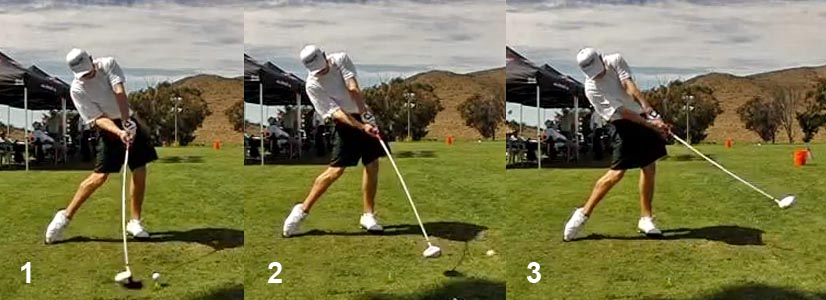
Image 1 is at impact, image 2 is at P7.2 and image 3 is at P7.5.
First of all, note that his peripheral clubshaft is bent forward just before impact, which means that he must have negative alpha torque pre-impact. Secondly, note that there is no exaggerated left leg straightening action or any "jumping-up" action through impact. Finally, note that his left foot is solidly grounded at impact and it remains solidly grounded during his followthrough to P7.5, and that there is no lifting-up and counterclockwise spinning of his left heel (which some golf instructors incorrectly believe can contribute to swing power). However, I think that it is optional whether one should lift-up and spin the left heel counterclockwise through impact and that phenomenon is much more likely to be seen in *"reverse foot" golfers rather than "front foot" golfers.
(* I discussed the difference between "reverse foot" golfers and "front foot" golfers in topic number 13 of this review paper)
It is also interesting to note that Domenic Mazza's clubshaft has not bypassed his left arm between impact and P7.2 - and that means that he is using a DH-hand release action which allows him to keep the clubface square to his clubhead arc for many inches through impact. I think that these capture images demonstrate the fact that using a DH-hand release action does not impair a golfer's ability to generate maximum swing power, and I think that many golf instructors are incorrect when they label a "drive-hold" hand release action as being a "holding-off" type of hand release action. The term "holding-off" is a negative term that implies that a DHer is impeding the full release of his club through impact, but that is a totally inaccurate interpretation of reality because DHers are fully releasing their club, and they are simply matching their left arm's forward angular velocity so that it perfectly matches the forward angular velocity of their fully released club during their early followthrough action.
At the time of writing of this review paper in December 2018, the two longest drivers on the PGA tour are Luke List and Cameron Champ, and they both do not use an exaggerated degree of parametric acceleration of the club during their driver golf swing actions.
Here are capture images of Luke List's downswing action.
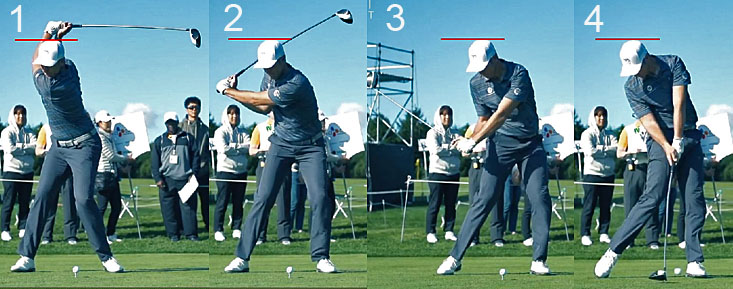
Image 1 is at his P4 position. Note that I have drawn a red line at the
level of the top of his
head.
Image 2 is at P5, image 3 is at P5.5 and image 4 is at impact. Note how his head does not change its position throughout his entire downswing. Note that he does manifest any of those "extra" biomechanical movements that are seen in Lexi Thompson's golf swing action.
Here is an image showing Luke List's hand arc path.
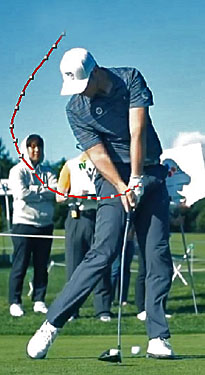
The red splined line represents his hand arc path. Note that his hand arc path reaches its nadir when it reaches his right outer thigh, and that it then moves slightly upwards in his late downswing due to a finite amount of left shoulder elevation happening between P5.5 and impact.
Note that he does not i) overly straighten his left leg and overly elevate the left side of his pelvis; ii) get up on his toes; iii) overly stretch-out his left upper torso or iv) overly elevate his left outer clavicle.
Despite not manifesting the "extra" biomechanical movements associated with the phenomenon of an increased degree of parametric acceleration of the club, he still drives the ball extremely far by PGA tour standards.
Finally, I am going to end this topic of swing power generation by demonstrating that Cameron Champ also does not resort to using an exaggerated degree of parametric acceleration of the club in his late downswing.
Here are capture images of Cameron Champ's downswing action.
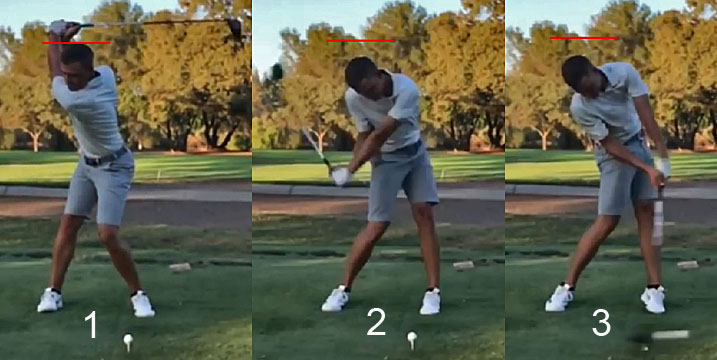
Image 1 is at P4, image 2 is at P5.5 and image 3 is at impact.
Note that I have drawn a red line at the level of the top of his head at his P4 position.
Note that his head drops down between P4 and P5.5, but it is not due to the "pivot compression phenomenon" that is due to an increased degree of hip joint flexion and knee joint flexion. His head has dropped because he has acquired i) a slightly increased degree of secondary axis tilt, ii) a significant degree of right lateral bend and iii) a small degree of tilting of his head away from the target between P4 and P5.5.
Note this left leg is not excessively straightened at impact (image 3), and that his left pelvis is not elevated to an exaggerated degree. Note that his head has not elevated between P5.5 and impact and that there is no exaggerated degree of elevation of his left shoulder socket.
Also, note that he has minimal elevation, or counterclockwise spinning, of his left heel at impact.
Finally, I am going to end this review paper by sharing these capture images of Cameron Champ's followthrough action.

Image 1 is at impact, image 2 is at P7.2, image 3 is at P7.4 and image 4 is
at P7.6.
Note that Cameron Champ is a perfect example of a DHer who does not allow the clubshaft to bypass his left arm between P7 and P7.6 - by avoiding any significant degree of left wrist extension, or any significant degree of left forearm supination, during his early followthrough time period. Note how he also keeps his clubface squared relative to his clubhead arc to well beyond impact, which means that he likely has a low ROC of his clubface through impact.
Cameron Champ perfectly demonstrates the golf instructional principle that it is possible to be a long driver of the golf ball when using a DH-hand release action (which is potentially useful from the perspective of consistently driving the ball down the middle of the fairway).
Acknowledgment: I would like to thank Jim George, PhD, for his copy editing of this extensive critical review paper. His editing prowess, which improved the readability and quality of this manuscript, is greatly appreciated.
Jeffrey Mann.
December 2018.